
The cover image was created by the transcriber and is placed in the public domain.
The Project Gutenberg EBook of Stone Art, by Gerard Fowke
This eBook is for the use of anyone anywhere in the United States and most
other parts of the world at no cost and with almost no restrictions
whatsoever. You may copy it, give it away or re-use it under the terms of
the Project Gutenberg License included with this eBook or online at
www.gutenberg.org. If you are not located in the United States, you'll have
to check the laws of the country where you are located before using this ebook.
Title: Stone Art
Thirteenth Annual Report of the Bureau of American Ethnology
to the Secretary of the Smithsonian Institution, 1891-1892,
Government Printing Office, Washington, 1896, pages 47-178.
Author: Gerard Fowke
Release Date: December 26, 2015 [EBook #50769]
Language: English
Character set encoding: UTF-8
*** START OF THIS PROJECT GUTENBERG EBOOK STONE ART ***
Produced by PM for Bureau of American Ethnology, The
Internet Archive (American Libraries) and the Online
Distributed Proofreading Team at http://www.pgdp.net (This
file was produced from images generously made available
by the Bibliothèque nationale de France (BnF/Gallica) at
http://gallica.bnf.fr)
47

The cover image was created by the transcriber and is placed in the public domain.
48
49
51
56
57
STONE ART
By Gerard Fowke
The collection of the Bureau of Ethnology includes almost every type of stone implement or ornament, and as the investigations and explorations of the collaborators have extended over nearly all the eastern and central portions of the Mississippi valley, it furnishes a substantial basis for showing the geographic distribution of various forms of objects in use among the aboriginal inhabitants.
It has not been deemed advisable to utilize material contained in other collections. Should this be done there would be no reason for drawing upon one rather than another, and if it were once begun the examination would finally extend to every collection made from American localities, a study which, although perhaps desirable, would transcend the scope of the Bureau plans.
Much that has been published in regard to the distribution of relics in various portions of the country is of little value to a paper of this kind, since few of the objects are sufficiently illustrated or referred to any class in other than the most general terms; so that it is frequently impossible to determine the group in which a given article should be placed. Partly for this reason, partly because the primary purpose is description of a certain collection made in a definite way, little space is given to the descriptive work of predecessors in the field of archeology. The general results of previous work are, however, carefully weighed in the conclusions reached.
The ordinary division into chipped and pecked or ground implements has been adopted: the former including all such as are more easily worked by flaking, and the latter including those made from stone suitable for working down by pecking into form with stone hammers or by similar means. The system of nomenclature in general use has been retained, as it is now familiar to students of North American 58 archeology, and, while not entirely satisfactory in some respects, is perhaps as good as can be devised in the present state of knowledge.
Careful study of the entire collection has failed to show the slightest difference in the form, finish, or material of implements from the same locality, whether found in mounds or graves or on the surface; hence no attempt is made to separate the two classes of objects. Allowance is to be made for the weathering of a surface specimen, but this is the only distinction.
It is not always easy to identify a stone, even with a fresh surface; in a weathered specimen it is often impossible. For this reason the material of which a specimen is made may not be correctly named; frequently the alteration due to exposure will change the appearance of a rock very much, and in such a case the best that can be done is to tell what it looks most like. The material of a majority of specimens however, or at least the classes of rock to which they belong, as granite, porphyry, etc., are correctly named; to give a more exact name would be possible only by the destruction or injury of the specimen. There are a few terms used which may be here explained.
“Compact quartzite” is a very hard, close-grained, siliceous rock, sometimes nearly a flint, and again closely approaching novaculite. “Greenstone” may be diorite or diabase, or it may be a very compact dark sandstone or quartzite so weathered that its nature can not be determined from superficial observation. “Argillite” refers to any slaty rock; it may be so soft as to be easily cut with a knife, or nearly as hard as quartzite. Usually it is greenish in color.
A comprehensive study of all available collections will no doubt modify materially the classification and system of types here presented.
The quotations from eminent anthropologists given below show the difficulties in the way of establishing a satisfactory system of types, or of assigning certain forms to particular localities. In most of these quotations the substance only of the author’s remarks is given.
According to Dr. E. B. Tylor, the flint arrows of the Dakota, the Apache, or the Comanche might easily be mistaken for the weapons dug up on the banks of the Thames;1 while cores of flint in Scandinavia and of obsidian in Mexico are exactly alike,2 and a tray filled with European arrowheads can not be distinguished from a tray of American ones.3 Prof. Otis T. Mason observes that the great variety of form in such weapons after they are finished is due partly to nature and partly to the workman’s desire to produce a certain kind of implement. All sorts of pebbles lie at the hand of the savage mechanic, none of them just what he wants. He selects the best.4 Perhaps the truth about the shape is that the savage found it thus and let it so remain.5 59
The state of things among the lower tribes which presents itself to the student is a substantial similarity in knowledge, arts, and customs, running through the whole world. Not that the whole culture of all tribes is alike—far from it; but if any art or custom belonging to a low tribe is selected at random, the likelihood is that something substantially like it may be found in at least one place thousands of miles off, though it frequently happens that there are large intervening areas where it has not been observed.6
On the whole, it seems most probable that many of the simpler weapons, implements, etc., have been invented independently by various savage tribes. Though they are remarkably similar, they are at the same time curiously different. The necessaries of life are simple and similar all over the world. The materials with which men have to deal are also very much alike; wood, bone, and to a certain extent stone, have everywhere the same properties. The obsidian flakes of the Aztecs resemble the flint flakes of our ancestors, not so much because the ancient Briton resembled the Aztec, as because the fracture of flint is like that of obsidian. So also the pointed bones used as awls are necessarily similar all over the world. Similarity exists, in fact, rather in the raw material than in the manufactured article, and some even of the simplest implements of stone are very different among different races.7
Tylor again says:
When, however, their full value has been given to the differences in the productions of the Ground Stone Age, there remains a residue of a most remarkable kind. In the first place, a very small number of classes, flakes, knives, scrapers, spear and arrow heads, celts, and hammers take in the great mass of specimens in museums; and in the second place, the prevailing character of these implements, whether modern or thousands of years old, whether found on this side of the world or on the other, is a marked uniformity. The ethnographer who has studied the stone implements of Europe, Asia, North or South America, or Polynesia, may consider the specimens from the district he has studied as types from which those of other districts differ, as a class, by the presence or absence of a few peculiar instruments, and individually in more or less important details of shape or finish, unless, as sometimes happens, they do not differ perceptibly at all. So great is this uniformity in the stone implements of different places and times, that it goes far to neutralize their value as distinctive of different races. It is clear that no great help in tracing the minute history of the growth and migration of tribes is to be got from an arrowhead which might have come from Polynesia, or Siberia, or the Isle of Man, or from a celt which might be, for all its appearance shows, Mexican, Irish, or Tahitian. If an observer, tolerably acquainted with stone implements, had an unticketed collection placed before him, the largeness of the number of specimens which he would not confidently assign, by mere inspection, to their proper countries, would serve as a fair measure of their general uniformity. Even when aided by mineralogical knowledge, often a great help, he would have to leave a large fraction of the whole in an unclassified heap, confessing that he did not know within thousands of miles or thousands of years where and when they were made.
How, then, is this remarkable uniformity to be explained? The principle that man does the same thing under the same circumstances will account for much, but 60 it is very doubtful whether it can be stretched far enough to account for even the greater proportion of the facts in question. The other side of the argument is, of course, that resemblance is due to connection, and the truth is made up of the two, though in what proportion we do not know.8
While the several authors quoted do not fully agree, and some are even slightly self-contradictory, still, if the statements are to be taken at their face value, it would seem that efforts to make such classifications are mainly a waste of time.
It may be premised that in every class of implements there are almost as many forms as specimens, if every variation in size or pattern is to be considered; and these merge into one another imperceptibly. Not only is this the case with individual types, but the classes themselves, totally unlike as their more pronounced forms may be, gradually approach one another until there is found a medium type whose place can not be definitely fixed.
As space would be needlessly occupied by attempting to name each county, the area from which specimens have been obtained is, for convenience, divided into districts. These divisions are for use in this article only, and are not intended as archeologic districts.
In the tables given under each heading, the names of counties or districts show where the types described are obtained; the columns following show the number of specimens of each material mentioned in the collection of the Bureau.
Where a limited area only has been examined in any division, the name of the county is usually given; but where specimens of any kind have been obtained from different counties near one another, they are assigned to the district including those counties. The districts are as follows:
Northeastern: Between White and Mississippi rivers.
Southeastern: Between White and Washita rivers from Clarendon to Arkadelphia.
Southwestern: West of Washita river and south of Arkadelphia, including Bowie and Red River counties, Texas.
Central: From Dardanelles southward and eastward to the above limits.
Northeastern: Bordering Tennessee river east of Decatur.
Northwestern: Bordering Tennessee river west of Decatur. 61 Coosa: Bordering Coosa river southward to and including Dallas county.
Tuscaloosa: Bordering the Tuscaloosa and Little Tombigbee, and extending a short distance below their confluence.
Miami valley: The country along the two Miami rivers, including Shelby county on the north and Madison and Brown counties on the east.
Scioto valley: South of Franklin county, including Adams and Lawrence counties.
Central: Including Union, Knox, Perry, and Franklin counties, and the area within these limits.
Southwestern: The counties bordering on either side of Mississippi river from La Crosse to Dubuque (Iowa).
Eastern: The portion between Lake Michigan, Lake Winnebago, and the Illinois line.
Southern: Dane and adjoining counties.
Keokuk: The southeastern corner of the state and adjacent portions of Illinois and Missouri.
Eastern: All the mountain district, with the extreme southwestern part of Virginia.
Western: From Mississippi river to and including the tier of counties east of the Tennessee.
Northern: The northern half of the interior portion.
Southern: The southern half of this portion.
Northwestern: North and west of a line from Lancaster to Columbia. As no other portion of the state has been examined under direction of the Bureau, only the name of the state is used herein, reference being always to this section.
Northwestern: The portion northwest of the Chattahoochee.
Southwestern: Area contiguous to the lower Chattahoochee and Flint river.
Savannah: The vicinity of the city of Savannah, where a large collection was gathered.
62
Northeastern: Between Kentucky, Big Sandy, and Ohio rivers.
Southeastern: From Estill and Cumberland counties to the Tennessee and Virginia state lines.
Central: Between Green and Ohio rivers, west of the last described districts.
Southern: From Green river southward and as far westward as Christian county.
Western: West of Green river and Christian county.
Western: West of Charlotte.
Central: Between Charlotte and Raleigh.
Southwestern: From the mouth of the Cumberland to Washington county, and thence to the Mississippi.
The various forms of implements will now be considered. As stated above, the names given the various articles are those by which they are usually known; but it may be well to define some of the terms used.
In the grooved axes, edge refers to the cutting portion; blade, to the part below the groove; poll or head, to that above the groove; face, to the wider or flat portion of the surface; side, to the narrower part; front, to that side farther from the hand, and back, to the side nearer the hand when in use.
In celts, the terms are the same, so far as they are applicable; blade referring to the lower half of the implement; that is, to the portion on which the cutting edge is formed.
The implements known as grooved axes seem to be of general distribution throughout the United States; being, so far can be learned from various writers, much more numerous east of Mississippi river than west of it. It must be remembered, however, that thousands of diligent collectors have carefully searched for such things in the east, while in the west little attention has been paid to them; consequently, deductions are not to be made concerning their relative abundance or scarcity, until further knowledge is gained. The same remark will apply to every form of aboriginal relic. 63
In the eastern and interior states, the grooved axes are far more abundant than the celts of the same size9, because as a rule only the larger implements of this class are grooved. All the ordinary varieties of axes and hatchets are found about Lake Champlain, by far the most abundant being celts, or grooveless axes.10
According to Adair and other early observers, the southern Indians had axes of stone, around the grooved heads of which they twisted hickory withes to serve as handles; with these they deadened timber by girdling or cutting through the bark.11 According to travelers of a later generation among the western Indians, similar implements were used on the plains to chop up the vertebræ of buffaloes, which were boiled to obtain the marrow.12
These statements, which might be multiplied, show that such objects are to be found widely scattered; none, however, give information more definite than that the axes are “grooved,” no reference being made to the shape of the ax or the manner of grooving.
The various modes of mounting axes and celts in handles are illustrated in the Smithsonian Report for 1879.
Stone axes were used in Europe by the Germans at as late a period as the Thirty Years’ war, and are supposed to have been used by the Anglo-Saxons at the battle of Hastings.13

Fig. 29.—Grooved ax, showing groove projections.
Axes having two grooves occur in considerable numbers in the pueblos of southwestern United States, but they are extremely rare elsewhere and unknown in most districts; as the objects are generally small, the utility of the second groove is not evident.
The arrangement of stone axes may be based upon the manner of forming the groove. In one class are placed those which in the process of making had a ridge left encircling the weapon, in which the groove was formed. This gives the ax greater strength with the same material. Usually the groove has been worked just deep enough to reach the body of the ax; that is, to such a depth that should the projections be ground off there would remain a celt-like implement (as shown in 64 figure 29, of chlorite-schist, from Sullivan county, Tennessee). The axes of this class in the Bureau collection are shown in the following table:
| District. | A | B | C | D | E | F |
|---|---|---|---|---|---|---|
| Eastern Tennessee | 9 | 8 | 4 | 5 | 1 | |
| Western North Carolina | 1 | 1 | ||||
| Central North Carolina | 1 | 1 | ||||
| Savannah, Georgia | 4 | 1 | ||||
| Butler county, Ohio | 1 | 1 | ||||
|
KEY: A = Greenstone. B = Argillite. C = Sienite. D = Granite. E = Schist. F = Quartzite. |
||||||
In the second class the groove is formed by pecking into the body of the ax after the latter is dressed into shape; in this pattern a regular continuous line from edge to poll would touch only the margins of the groove, leaving it beneath. An apparent medium between the two is sometimes seen, in which there is a projection on the lower side of the groove only; this is due, usually, to dressing the blade down thinner after the implement was originally worked to a symmetric outline. By continuous or long use the edge of the ax becomes broken or blunted and requires sharpening, and in order to keep the proper outline to make the tool efficient, it is necessary to work the blade thinner as it becomes shorter. No such change is required in the poll, consequently a projection is formed where originally there was no trace of one.
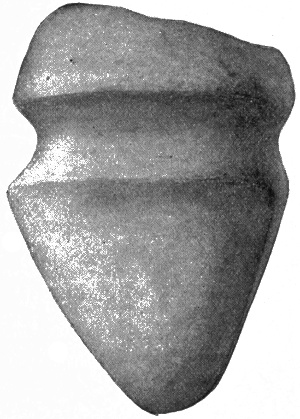
Fig. 30.—Grooved ax, showing pointed edge.
There are different methods of finishing the ax, which may appear with either form of groove. The poll may be worked into the shape of a flattened hemisphere, may be flat on top, with the part between the groove and the top straight, convex or concave, or may be worked to a blunt point, with straight or concave lines to the groove. The blade may taper from the groove to the edge, with straight or curved sides, which may run almost parallel or may be drawn to a blunt-pointed edge. This latter form is probably due to breaking or wearing of the blade, which is reworked, as shown in figure 30, of granite, from Boone county, Missouri.
There are a very few specimens, as noted below, in which the ax gradually increases in width from the poll to the edge; but such specimens seem to be made of stones which had this form approximately at the beginning, and were worked into such shape as would give a suitable implement with the least labor.
In nearly every instance the groove of an ax with a groove projection extends entirely around with practically the same depth, and the blade 65 of the ax has an elliptical section. There are, however, a few with the back flattened; and while many of the second division may be similar in section, and in having the groove extend entirely around, yet in this class are to be placed nearly all of those only partly encircled by a groove or showing some other section than the ellipse.
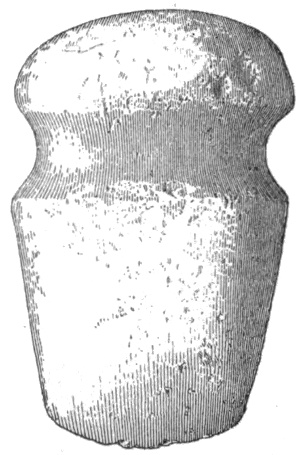

Fig. 31.—Grooved ax, showing groove entirely around.
Fig. 32.—Grooved ax, slender, showing groove entirely around.
With these exceptions, the second class of grooved stone axes comprises seven groups, which may be described and tabulated as follows:
A. Grooved entirely around, elliptical section, polls dressed in any of the ways given above; three or four have the blunt-pointed edge (figure 31, of granite, from Bradley county, Tennessee).
| District. | A | B | C | D | E | F | G | H | I |
|---|---|---|---|---|---|---|---|---|---|
| Southwestern Illinois | 1 | 1 | 1 | ||||||
| Eastern Tennessee | 4 | 3 | 2 | 2 | 15 | 4 | 1 | ||
| Central North Carolina | 1 | 1 | |||||||
| Western North Carolina | 2 | 2 | |||||||
| Central Arkansas | 1 | 1 | |||||||
| Ross county, Ohio | 1 | ||||||||
| Green River, Kentucky | 1 | 1 | |||||||
| Northeastern Kentucky | 1 | 1 | |||||||
| Kanawha valley, West Virginia | 4 | 1 | 1 | 1 | |||||
| Keokuk district, Iowa | 1 | 1 | |||||||
| Savannah, Georgia | 1 | 2 | 6 | 3 | |||||
| Miami valley, Ohio | 2 | 5 | 1 | ||||||
|
KEY: A = Greenstone. B = Granite. C = Diorite. D = Sandstone. E = Quartzite. F = Argillite. G = Slate. H = Sienite. I = Porphyry. |
|||||||||
66
B. Long, narrow, and thin, giving a much flattened elliptical section. These are classed with axes on account of the grooves, although too thin and usually of material too soft to endure violent usage. The edges are nicked, striated, or polished, as though from use as hoes or adzes (figure 32, of argillite, from Bradley county, Tennessee).
| District. | A | B | C |
|---|---|---|---|
| Eastern Tennessee | 18 | 1 | |
| Keokuk district, Iowa | 1 | ||
| Kanawha valley, West Virginia | 1 | ||
| Montgomery county, North Carolina | 1 | ||
| Western North Carolina | 1 | ||
| Butler county, Ohio | 2 | ||
|
KEY: A = Granite. B = Argillite. C = Slate. |
|||
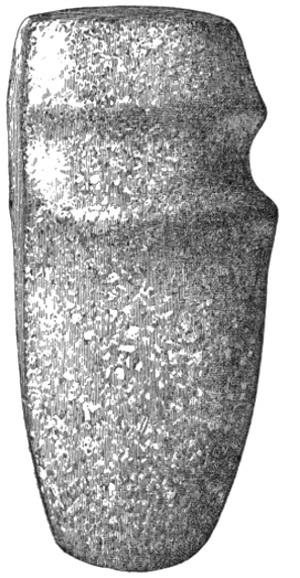

Fig. 33.—Grooved ax, showing grooved back.
Fig. 34.—Grooved ax, showing grooved back.
C. Grooved on both faces and one side; back hollowed, usually in a straight line the whole length; front drawn in from the groove to give a narrower edge (figures 33, of porphyry, from Brown county, Ohio, and 34, of granite, from Kanawha valley, West Virginia).
| District. | A | B | C | D |
|---|---|---|---|---|
| Eastern Tennessee | 1 | 1 | ||
| Kanawha valley, West Virginia | 1 | 1 | ||
| Butler county, Ohio | 1 | |||
| Brown county, Ohio | 1 | |||
|
KEY: A = Granite. B = Argillite. C = Sienite. D = Porphyry. |
||||
67
D. Same method of grooving; back is rounded, and may be in a straight or curved line the entire length, or a broken line straight in each direction from the groove. The type is illustrated by figure 35, of granite, from Keokuk, Iowa. This specimen is unusually wide and thin; generally the outlines are similar to those last described.
| District. | A | B | C |
|---|---|---|---|
| Eastern Tennessee | 5 | ||
| Butler county, Ohio | 2 | ||
| Keokuk district, Iowa | 1 | 1 | |
|
KEY: A = Granite. B = Argillite. C = Sienite. |
|||
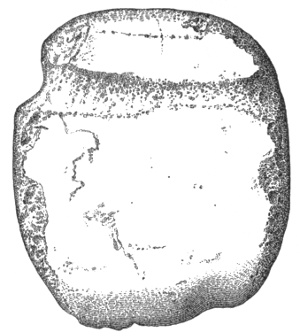
Fig. 35.—Grooved ax, showing rounded back.
E. Grooved like the last; same general form, except that the back is flat (figures 36, of sienite, from Brown county, Ohio, and 37, of granite, from Drew county, Arkansas).
| District. | A | B | C | D | E |
|---|---|---|---|---|---|
| Miami valley, Ohio | 2 | 3 | 5 | ||
| Brown county, Ohio | 1 | ||||
| Keokuk district, Ohio | 1 | 1 | |||
| Brown county, Illinois | 1 | 2 | |||
| Eastern Tennessee | 2 | 2 | |||
| Kanawha valley, West Virginia | 4 | 1 | 2 | ||
| Savannah, Georgia | 1 | 1 | |||
| Northeastern Kentucky | 1 | ||||
| Licking county, Ohio | 1 | ||||
|
KEY: A = Sandstone. B = Argillite. C = Granite. D = Sienite. E = Greenstone. |
|||||
68
F. Grooved on both faces and one side, with both sides flat. There is only one of this form in the collection; it is of argillite, from Keokuk, Iowa.
G. Grooved on faces only, with both sides flat (figure 38, of granite, from Keokuk, Iowa). There are from the same place one of porphyry, one of argillite, and three of sienite. This and the preceding form seem peculiar to that locality.
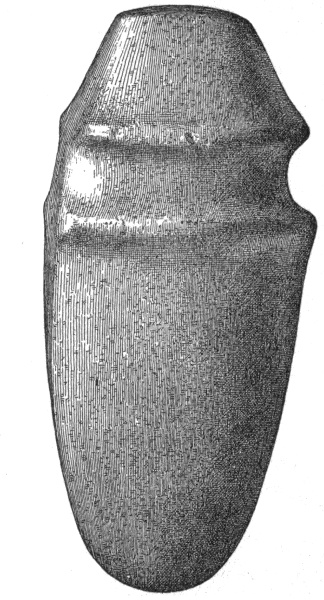
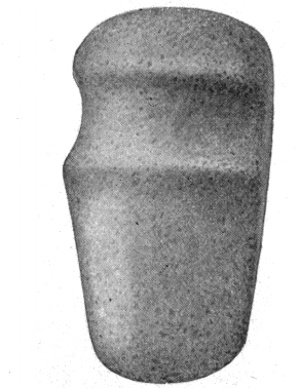
Fig. 36.—Grooved ax, showing flattened curved back.
Fig. 37.—Grooved ax, showing flattened straight back.
There are a few exceptional forms which are not placed with those just given, since they may have some features common to all except the Keokuk type, while in other respects they differ from all. Among them are some entire-grooved or grooved only on the two sides and one face; the general outline may correspond with some of the regular forms, but one face is curved from poll to edge, while the other is straight or nearly so (figure 39, of granite, from Wilkes county, North Carolina). This specimen has a depression, as if worn by the end of a handle, on the straight face at the lower edge of the groove.
None of this form are long enough for hoes, and although they may have been used for axes and hatchets, their shape seems to indicate use as adzes. Besides the one figured there are two from Savannah, Georgia; three from eastern Tennessee, one with a slight groove and very deep side notches; and three from western North Carolina, two of them entire-grooved with groove projections. 69
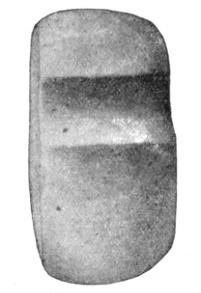
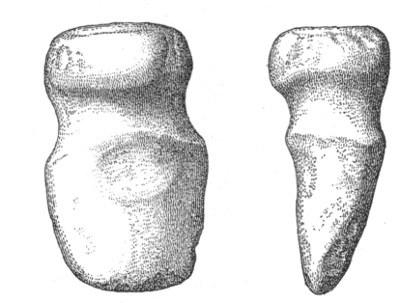
Fig. 38.—Grooved ax, Keokuk type.
Fig. 39.—Grooved ax, showing adze form.
Another unusual form, which may come under any of the foregoing figures, has the groove crossing the implement diagonally, in such a way as to cause the blade to incline backward (figure 40, of granite, from Carter county, Tennessee). Besides the specimen illustrated, this form is also represented by one of granite from northwestern North Carolina with projection for groove; two of argillite from southwestern Tennessee; one, widest at edge, from Savannah, Georgia; one from Ross county, Ohio; and two of granite, highly polished, grooved on faces and one side, with backs flat, from Kanawha valley, West Virginia.
Of the axes wider at the edge than at any point above (of which the specimen illustrated in figure 41, of granite, from a grave at Kingsport, Tennessee, may be taken as a type,) there are one of diorite from Kanawha valley, West Virginia, which seems to have been of ordinary pattern but broken and redressed to its present form; and from Savannah, Georgia, one of uniform taper with diagonal groove, and one widening irregularly until the blade is fully twice the width of the poll.
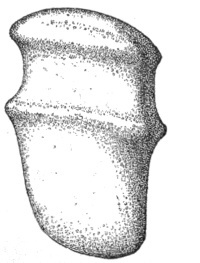
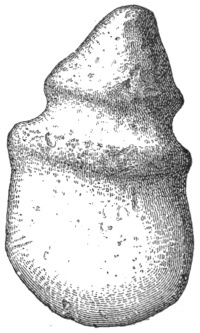
Fig. 40.—Grooved ax, showing diagonal groove.
Fig. 41.—Grooved ax, showing wide edge.
Many, if not a majority, of the entire-grooved axes have the groove wide enough for a very large handle, or for an ordinary withe to be twisted twice around. In those which have one side ungrooved, the intention was to admit a wedge between the stone and the curve of the handle. The handles were very firmly fastened; two axes in the collection have been broken in such a way that on one side, from the top half way down, the blade is gone, carrying away the groove on that side; yet the polish of the groove extends 70 over the fractured surface, which has never been reworked, showing that the tool was long used after this accident. As the handles could easily slip off over the top in specimens thus broken, they must have been tightly lashed; perhaps gum or glue was used.
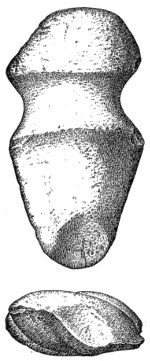
Fig. 42.—Grooved ax, showing curved edge.
Partly finished specimens show that the groove was pecked out and the edge ground before the remaining parts of the ax were worked. Some have the edge ground sharp and the groove worn smooth or even polished by long use, while all the rest of the implement retains the original weathered surface. A stone was always chosen that could be brought to the desired form with the least labor, and very often one could be found that required but little work to make a very satisfactory weapon or implement or even ornament.
Occasionally specimens indicate by the manner of wear their application to certain kinds of work. Sometimes the edge is curved by the wearing away of one face until it has almost a gouge form; sometimes the side of the blade next the hand, again that farthest away, is more worn. This in time would give the blunt-pointed edge. A peculiar finish of the lower part of the blade, which is also seen in a few celts, is shown in figure 42, of sienite, from Carter county, Tennessee. One half of each face has been left full, and the part opposite hollowed out, giving an ogee curve to the edge. Figure 43, of granite, from Jefferson county, Tennessee, seems to have a ridge on the upper side of the groove; but closer examination shows that it once had a groove projection, and that afterwards the poll was nearly all broken away and a new groove made lower down, so that what was originally the lower projection is now above the groove, the remainder of the poll being worked down to a point.
There are a few hammers which differ from the ordinary ax only in being blunt instead of sharp. They may be nothing more than broken axes, utilized as hammers instead of being resharpened.
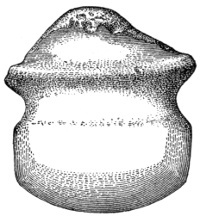
Fig. 43.—Grooved ax, showing single groove projection.
Under this head may be placed implements plainly used as adzes. They are much longer than axes in proportion to their other dimensions, have one face convex, the other straight or concave. They may be placed in the same class as the specimen shown in figure 39, and also those represented in figures 44 and 45, from McMinn county, Tennessee. There is also a similar adze from Saline county, Arkansas. All the specimens of this class are of argillite. 71
With the grooved axes is also placed a class of implements that may be called axes notched on the sides. Many of them were no doubt used as sinkers; but some of the same form, size, and material have the notches and sometimes portions of the face worn perfectly smooth, while frequently they are ground to a sharp edge. Again, even in those that have not the least polish, the edge shows marks that would seem to result from use as axes, adzes, or hoes.
There are three divisions of this class of implements, as follows:
A. Unworked, except notches; probably sinkers.
| District. | A | B | C | D |
|---|---|---|---|---|
| Eastern Tennessee | 1 | 5 | ||
| Montgomery county, North Carolina | 1 | |||
| Northeastern Alabama | 5 | |||
| Kanawha valley, West Virginia | 3 | |||
|
KEY: A = Sandstone. B = Argillite. C = Quartzite. D = Limestone. |
||||
B. Partly ground sharp edges, mostly with polished notches, sometimes with faces polished from one notch to the other (figure 46, of argillite, from Cocke county, Tennessee). In addition there are 11 examples of argillite, besides one of mica-schist from eastern Tennessee and another of sandstone from Savannah, Georgia.
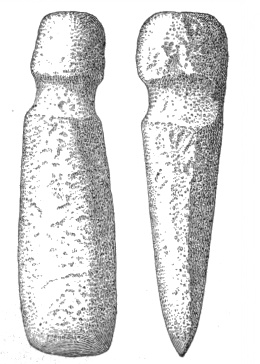

Fig. 44.—Grooved adze.
Fig. 45.—Grooved adze, showing curved blade.
C. Roughly chipped, with notches often at the middle but sometimes nearer one end. Probably most of these were sinkers; but as above stated the edges show marks of use, apparently in scraping, digging, or striking. Of these the following examples are in the Bureau collection: From several localities in eastern Tennessee, 40 of argillite; from Montgomery county, North Carolina, 24 of argillite and quartzite; 72 from Kanawha valley, West Virginia, and from Savannah, Georgia, a few specimens of the same materials.
What is true of the uses and distribution of stone axes applies with much the same force to what are called celts—not a good descriptive term, but one which is now given to the implement in lieu of something better. It would appear difficult or impossible to do with these rude tools any work for which we commonly use an ax or hatchet; and yet, by the aid of fire, or even without it, the aborigines contrived to accomplish a great deal with them.
The Maori of New Zealand do all their wonderful work of wood carving with only a chisel or adze (of stone or shell).14 Among the Iroquois, in cutting trees, fire was applied at the root, the coals were scraped away with a chisel, and this process was repeated until the tree was felled. The trunk was divided into lengths in the same way. Similarly canoes and mortars were hollowed out.15 The Virginia Indians at an early day employed a similar process. They also cleared ground for cultivation by deadening trees with their tomahawks,16 and used adzes made of shell in cleaning out the charred wood in making canoes.17 The Nootka of the northwestern part of the continent in felling a tree use a flint or elkhorn set in a handle, this being struck with a stone mallet. In hollowing canoes a musselshell also is used as an adze, and sometimes fire is applied. The outside is shaped by similar means.18
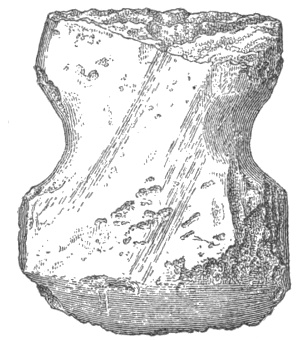
Fig. 46.—Notched ax, showing polished edge.
Stone chisels have been found in various steatite quarries, where vessels and other utensils of this material were made, and the marks of their use is plain both on the vessels in an unfinished state and on the cores, as well as on the quarry face.19
The different ways of hafting, as shown by specimens in the Bureau collection, were as follows:
(1) A hole was cut entirely through a stick and the celt was inserted so that it would project on both sides;
(2) The hole was cut partly through, and the celt was pushed in as far as it would go; 73
(3) The top of the celt was set in a socket of deer horn, which was put into a handle as in form 2;
(4) Small celt-shaped knives or scrapers were set into the end of a piece of antler long enough to be used as a handle;
(5) A forked branch was so cut as to make two prongs of nearly equal length, and the celt was fastened to the end of one, parallel with it, the other being used to guide and steady it, a prong being held in each hand;
(6) The fork of a root or branch was trimmed so as to make a flat face at any desired angle, to which the celt was lashed, a shoulder, against which the end of the celt was set, being sometimes cut in the wood;
(7) A stick was split its entire length and a single turn taken around the celt, the ends being brought together and tied, forming a round handle;
(8) A stick was split part way, one fork cut off and the other wrapped once or twice and tied, thus forming a round handle of solid wood.
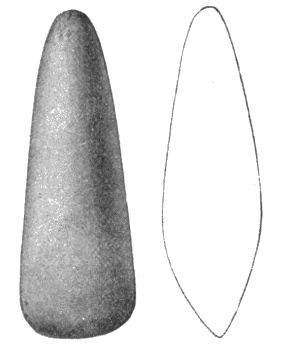
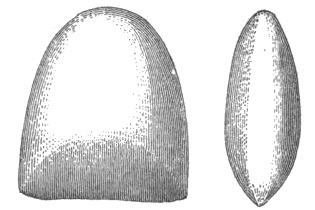
Fig. 47.—Celt, showing blade thick near edge.
Fig. 48.—Celt, showing blade thick near edge.
Forms 5 and 6 were used as adzes; forms 7 and 8 are the same methods as employed in hafting grooved axes.
A mounting similar to form 4 is seen in some Alaska specimens of celt-scrapers in which the implement is fastened to a piece of wood so as to project a short distance, and used like a plane. In all these, the celt is very firmly fastened to the handle with sinew or rawhide, which, when put on green, contracts with great force and binds like wire.
As to the forms of celts, no division is practicable based on anything but their entire appearance. The following descriptions and tabulations represent the material of this kind in the Bureau collection:
A. Round or nearly round section, pointed or flattened at the top, blade rapidly thickening from the edge; a few are polished at the top, but most of them show marks of a maul or hammer; all have been highly polished; all of this class were probably used as wedges, as their shape renders them more fit for this purpose than for any other; the 74 battered tops indicate such usage. The few not showing such marks may have been set into a bumper of wood or horn, or used with wooden mauls. They vary in length from 2½ to 7½ inches. They are represented by the specimen shown in figure 47, of argillite, from Lincoln county, Arkansas; there are also one from a mound in Sumter county, Alabama (figure 48), and one from Kanawha valley, West Virginia, both of serpentine and elliptical in section, though the form of the edge puts them in this class. The following specimens are typical representations of the class:
| District. | A | B | C | D | E |
|---|---|---|---|---|---|
| Northwestern North Carolina | 3 | 7 | 2 | ||
| Eastern Tennessee | 3 | ||||
| Western Tennessee | 1 | ||||
| Southeastern Arkansas | 2 | ||||
| Union county, Mississippi | 1 | ||||
| Madison county, Illinois | 1 | ||||
| Savannah, Georgia | 2 | 1 | |||
|
KEY: A = Sienite. B = Argillite. C = Granite. D = Rotten limestone. E = Sandstone. |
|||||

Fig. 49.—Celt, showing long, slender form.
B. Long, narrow, elliptical section, pointed top, curved or straight edges, sides straight or gently curved. None of these seem to have been put to any rough use, as the edges are quite sharp and the entire surface is well polished; length from 4¼ to 12½ inches. The type is illustrated by figure 49, of argillite, from a mound in Monroe county, Tennessee.
| District. | A | B | C | D | E |
|---|---|---|---|---|---|
| Eastern Tennessee | 8 | 3 | |||
| Northwestern Georgia | 1 | ||||
| Savannah, Georgia | 6 | 1 | 3 | ||
| Kanawha valley, West Virginia | 1 | ||||
| Northeastern Alabama | 1 | ||||
| Western North Carolina | 1 | ||||
|
KEY: A = Argillite. B = Granite. C = Sandstone. D = Quartzite. E = Sienite. |
|||||
C. Thick, almost round section, round-pointed top, nearly straight to sharp-curved edge, sides gently curved, widest at edge or just above. Most of these show marks of use as cutting tools or hatchets. In 75 many the top has been roughened as if for insertion into a hole cut in a piece of wood; others have this roughening around the middle or immediately above, leaving a polish at both ends, and these were hafted probably by means of a stick or withe twisted around them. The roughening is a secondary operation, having no relation to the making of the implement; it was produced by pecking after the surface was polished. In a few cases it extends from the top well down the sides; but usually it reaches but a little way below the top, or else is in a circle around the body of the celt. Most of them have sharp edges; a few have edges either chipped or blunted and polished, showing long usage. Two from Kanawha valley (one roughened for handle) have the edges worn in on one of the faces until they almost resemble gouges; but that they were not intended as such is shown by the concavity being nearer one side and not reaching entirely across. The length ranges from 4½ to 10 inches. The type is illustrated by figures 50 and 51, both of sienite, from Lauderdale county, Tennessee.
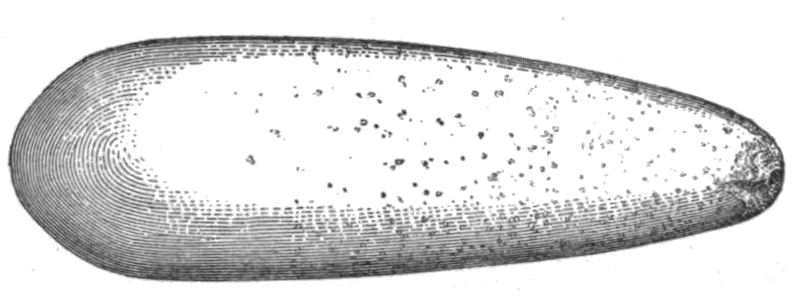
Fig. 50.—Celt, nearly round section.
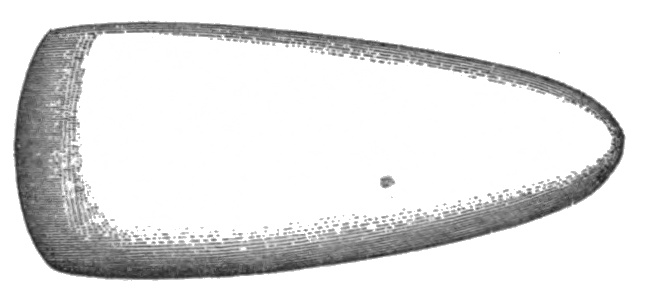
Fig. 51.—Celt, nearly round section.
This may be regarded as the typical form of celt for eastern United States, and its geographic distribution is exceptionally wide, as shown in the table.
The Bureau collection includes the following specimens of this class:
| District. | A | B | C | D | E | F | G | H |
|---|---|---|---|---|---|---|---|---|
| Western North Carolina | 4 | 2 | 9 | 16 | ||||
| Montgomery county, North Carolina | 1 | |||||||
| Coosa district, Alabama | 1 | |||||||
| Ross county, Ohio | 1 | |||||||
| Knox county, Ohio | 1 | |||||||
| Miami valley, Ohio | 1 | 2 | ||||||
| Eastern Tennessee | 5 | 1 | ||||||
| Green river, Kentucky | 1 | |||||||
| Northeastern Kentucky | 1 | 2 | ||||||
| Northeastern Arkansas | ||||||||
| Kanawha valley, West Virginia | 4 | 4 | 3 | 1 | ||||
| Crawford county, Wisconsin | 1 | |||||||
| Southwestern Illinois | 2 | 1 | ||||||
| Savannah, Georgia | 3 | 2 | 2 | |||||
| Western Tennessee | 2 | |||||||
|
KEY: A = Porphyry. B = Sienite. C = Granite. D = Argillite. E = Greenstone. F = Sandstone. G = Diorite. H = Compact quartzite. |
||||||||
76
D. Of the form last described, except in being much thinner; some have the tops battered, showing use as wedges; length from 3 to 9 inches.
| District. | A | B | C | D | E | F | G | H | I | J |
|---|---|---|---|---|---|---|---|---|---|---|
| Eastern Tennessee | 11 | 3 | 2 | 1 | 1 | 1 | ||||
| Kanawha valley, West Virginia | 2 | 5 | 2 | 6 | ||||||
| Northwestern Georgia | 3 | 1 | ||||||||
| Savannah, Georgia | 2 | |||||||||
| Green river, Kentucky | 1 | |||||||||
| Northeastern Kentucky | 2 | |||||||||
| Southeastern Arkansas | 1 | |||||||||
| Central Arkansas | 1 | |||||||||
| Northeastern Arkansas | 1 | 1 | ||||||||
| Butler county, Ohio | 2 | |||||||||
| Northwestern North Carolina | 8 | 2 | 1 | 4 | ||||||
|
KEY: A = Argillite. B = Porphyry. C = Sienite. D = Diorite. E = Sandstone. F = Granite. G = Hornblende. H = Greenstone. I = Serpentine. J = Compact quartzite. |
||||||||||
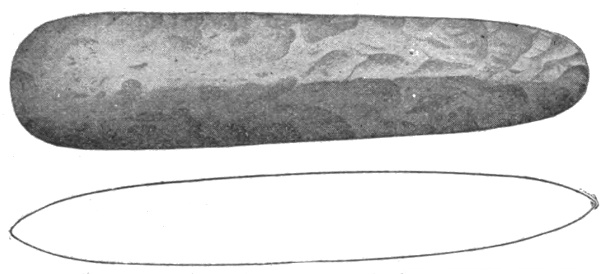
Fig. 52.—Celt, showing nearly diamond section.
E. Pointed oval, or nearly diamond section, sides straight or slightly curved; length 6 to 12½ inches. Few as these are, they vary considerably in appearance. The group is illustrated by figure 52, showing a specimen of brown flint, containing numerous small deposits of chalcedony, from Benton county, Tennessee; polished over the entire surface, the edge highly so.
In addition, there are the following examples: From Caldwell county, North Carolina, one of porphyry and one of granite, the latter roughened on sides for handle; from McMinn county, Tennessee, one of gray flint, highly polished over its surface, except the top, which is much battered; from Cocke county, Tennessee, one of argillite.
F. Elliptical section, flattened or rounded top, edge curved or nearly straight, sides straight or gently curved, tapering from edge to top or in a few cases nearly parallel. These present many variations in finish and in evidence of use. Some are well polished over the entire surface; some have only the lower part polished; while some are entirely without polish except at the extreme edge. In some the top is battered; some have the surface roughened for handle at the top, others around the middle, still others all over the upper half or even more than half. One from McMinn county, Tennessee, has a roughly pecked shallow groove at the middle. Several have the edge 77 very blunt, the faces at the edge form almost a right angle; these are thickest very near the edge and become gradually thinner toward the top. Most of this kind are from Caldwell county, North Carolina; the same form coming also from Monroe county, Tennessee, and from Savannah, Georgia. The length is from 3 to 7½ inches. Figure 53, of compact quartzite, from Monroe county, Tennessee; figure 54, of granite; and figure 55, of sienite, from Caldwell county, North Carolina.
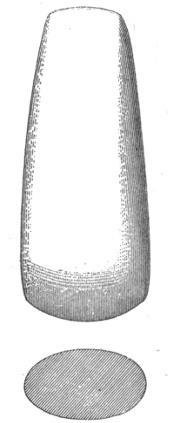
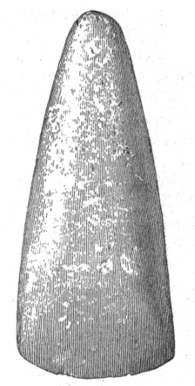
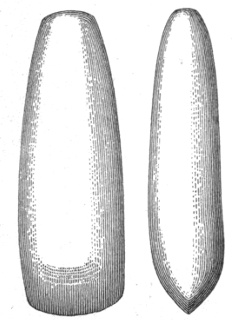
Fig. 53.—Celt.
Fig. 54.—Celt.
Fig. 55.—Celt.
| District. | A | B | C | D | E | F | G | H | I | J | K | L |
|---|---|---|---|---|---|---|---|---|---|---|---|---|
| Eastern Tennessee | 4 | 4 | 20 | 7 | 4 | 1 | 1 | |||||
| Western North Carolina | 1 | 4 | 22 | 4 | 3 | 5 | ||||||
| Montgomery county, N. C. | 1 | |||||||||||
| Coosa district, Alabama | 2 | |||||||||||
| Southwestern Illinois | 1 | 7 | ||||||||||
| Kanawha valley, W. Va. | 3 | 7 | 5 | 10 | 1 | 1 | ||||||
| Keokuk, Iowa | 1 | |||||||||||
| Southwestern Wisconsin | 1 | 1 | ||||||||||
| Miami valley, Ohio | 2 | 3 | ||||||||||
| Northeastern Arkansas | 1 | 1 | 2 | 2 | ||||||||
| Southeastern Arkansas | 1 | |||||||||||
| Northwestern Georgia | 1 | 2 | ||||||||||
| Savannah, Georgia | 2 | 2 | 1 | 7 | ||||||||
| Yazoo county, Mississippi | 5 | 2 | ||||||||||
|
KEY: A = Hornblende. B = Serpentine. C = Compact quartzite. D = Argillite. E = Sienite. F = Porphyry. G = Granite. H = Micaceous sandstone. I = Diorite. J = Greenstone. K = Sandstone. L = Flint. |
||||||||||||
78
G. Of the same general pattern as the last, except that the sides widen just before reaching the edge, giving a “bell shape” (figure 56). The length is from 6¼ to 8 inches. In this group there are two specimens of granite, two of porphyry, and one of sienite, all from Yazoo county, Mississippi. Two have their tops roughened.

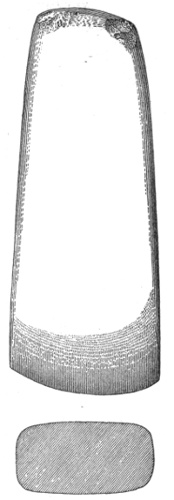
Fig. 56.—Celt, showing “bell shape” and roughening for handle.
Fig. 57.—Celt, showing rectangular section.
H. Rectangular section, occasionally with the corners sufficiently rounded to give a somewhat elliptical section; top flattened or rounded; sides straight and parallel or nearly so, sometimes very slightly curved. Most have polished surfaces; only three or four show any battering, or roughening for handle. A large one of hornblende from Lauderdale county, Tennessee, has the edge dulled and polished by use. Length is from 2 to 9 inches. Figure 57, of argillite, from a mound in Monroe county, Tennessee. The distribution of this class of celts is wide, as shown by the following table:
| District. | A | B | C | D | E | F | G | H | I | J |
|---|---|---|---|---|---|---|---|---|---|---|
| Eastern Tennessee | 10 | 10 | 2 | 1 | 1 | |||||
| Western Tennessee | 1 | |||||||||
| Northeastern Kentucky | 1 | 1 | 1 | 1 | 1 | |||||
| Green River, Kentucky | 1 | |||||||||
| Southwestern Illinois | 2 | 1 | ||||||||
| Miami valley, Ohio | 2 | 2 | 1 | 1 | ||||||
| Kanawha valley, W. V. | 1 | 8 | 4 | 4 | 1 | |||||
| Northwestern Georgia | 1 | |||||||||
| Savannah, Georgia | 1 | |||||||||
| Central Arkansas | 1 | |||||||||
| Northwestern North Carolina | 1 | |||||||||
|
KEY: A = Sandstone. B = Argillite. C = Porphyry. D = Granite. E = Sienite. F = Diorite. G = Hornblende. H = Limestone. I = Jasper. J = Serpentine. |
||||||||||
I. Thickest at top (wedge form), section elliptical or nearly rectangular; sides straight or curved, widest at edge or nearly parallel. A few are roughened for handling, and one or two are battered at top by hammering; most are small. The type is shown in figure 58, of granite, 79 from Carroll county, Indiana. This class of celts also is widely distributed and diverse in material.
| District. | A | B | C | D | E | F | G | H | I | J |
|---|---|---|---|---|---|---|---|---|---|---|
| Eastern Tennessee | 3 | 4 | 1 | |||||||
| Northeastern Arkansas | 1 | 1 | ||||||||
| Southeastern Arkansas | 1 | 1 | ||||||||
| Butler county, Ohio | 1 | |||||||||
| Green river, Kentucky | 1 | |||||||||
| Northeastern Kentucky | 3 | 1 | 1 | |||||||
| Crawford county, Wis. | 1 | |||||||||
| Southwestern Illinois | 3 | 1 | ||||||||
| Savannah, Georgia | 2 | |||||||||
| Kanawha valley, West Virginia | 1 | 7 | 5 | 1 | 5 | 2 | ||||
|
KEY: A = Hornblende. B = Granite. C = Sienite. D = Comp. quartzite. E = Argillite. F = Greenstone. G = Sandstone. H = Diorite. I = Porphyry. J = Basalt. |
||||||||||

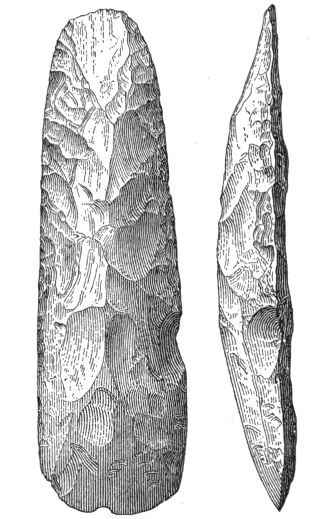
Fig. 58.—Celt, showing wedge-shape.
Fig. 59.—Celt, showing half-elliptical section.
J. Flat on one side, convex on the other, giving a semi-elliptical section; sides nearly parallel; top flat or rounded. These were evidently intended for scrapers; none are at all chipped or battered from use, and with very few exceptions the whole surface is highly polished. The flint and jasper specimens, which have been first chipped into shape, have the facets and edge as smooth as though finished on an emery 80 wheel. Similar forms, except with flat instead of convex upper surfaces, are known to have been used as adzes, but these have no marks of such use. The length ranges from 2 to 8 inches, but most are small. The type is shown in figure 59, of brown flint, from a grave in Alexander county, Illinois.
| District. | A | B | C | D | E | F | G | H |
|---|---|---|---|---|---|---|---|---|
| Eastern Tennessee | 4 | 1 | 1 | |||||
| Central Arkansas | 1 | |||||||
| Northeastern Arkansas | 4 | 1 | ||||||
| Southeastern Arkansas | 1 | |||||||
| Southwestern Illinois | 1 | |||||||
| Butler county, Ohio | 1 | |||||||
| Northeastern Kentucky | 2 | |||||||
| Tuscaloosa district, Alabama | 1 | |||||||
| Northwestern North Carolina | 1 | 2 | 1 | |||||
|
KEY: A = Graphite. B = Argillite. C = Porphyry. D = Compt. quartzite. E = Yellow jasper. F = Gray jasper. G = Novaculite. H = Sienite. |
||||||||
K. Similar to last, except that the sides come to a point at the top; length, 3½ to 9 inches. Very few of either pattern are above 5 inches long, the larger ones being mostly of flint (figure 60, of sienite, from Warren county, Ohio).
| District. | A | B | C | D | E | F |
|---|---|---|---|---|---|---|
| Northeastern Arkansas | 2 | |||||
| Western Tennessee | 1 | |||||
| Eastern Tennessee | 1 | 2 | 5 | |||
| Kanawha valley, West Virginia | 1 | |||||
| Southwestern Illinois | 2 | 1 | ||||
| Warren county, Ohio | 2 | |||||
|
KEY: A = Yellow jasper. B = Sienite. C = Diorite. D = Gray jasper. E = Argillite. F = Compt. quartzite. |
||||||
L. Sides concave, top narrow. Nearly every specimen has the upper portion pecked rough; one from Bradley county, Tennessee, and another from Mississippi county, Arkansas, are entirely polished. The latter has the scraper-form edge to be described later and is of exceptionally large size; it measures 5½ inches, being the only one exceeding 5 inches in length.
M. Top flat, round, or pointed; the blade usually begins a little below the middle, and is perfectly smooth in every case; in some the blade is not over an inch in length, probably reduced by continual sharpening. They may have been scrapers, though they do not have that form; if 81 used as weapons they were probably set into the end of a piece of antler, which, in turn, was set in a club. The type is shown in figure 61, of argillite, from Monroe county, Tennessee.
| District. | A | B | C | D | E |
|---|---|---|---|---|---|
| Eastern Tennessee | 7 | 1 | 2 | ||
| Kanawha valley, West Virginia | 1 | 1 | |||
| Northeastern Arkansas | 1 | 1 | |||
| Southeastern Arkansas | 1 | ||||
| Southwestern Illinois | 1 | 2 | |||
|
KEY: A = Argillite. B = Sienite. C = Granite. D = Quartzite. E = Hornblende. |
|||||
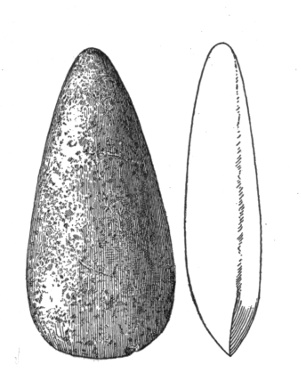
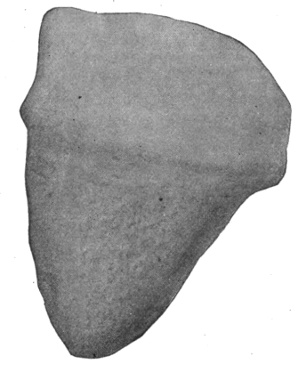
Fig. 60.—Celt showing half-elliptical section.
Fig. 61.—Celt, showing concave sides.
N. Ground down thin, with a flat-elliptical or nearly rectangular section; sides straight or slightly curved, nearly parallel or tapering considerably to the top, which is either rounded or flattened. All are polished over the entire surface; none show any marks of use as wedges or hatchets, and most of them are too delicate for such use. The longer ones can be readily grasped in the hand, and are as well adapted to stripping off the hide of an animal, dividing the skeleton at the joints, or stripping the flesh from the bones, as anything made of stone can be; while the smaller ones, set in a handle to afford a grip, would answer the same purpose. There are three which are sharp at both ends, one having one symmetrical and one scraper-form edge; one having a scraper-form edge at each end on opposite sides; and one of rather soft argillite, unfinished, which has marks of pecking, chipping, and grinding, showing that any of these methods were practiced, as was most convenient. All these are from eastern Tennessee. The features are illustrated in 82 figures 62, of argillite, from a mound, Caldwell county, North Carolina; 63, of black flinty slate, very hard, from a mound, Poinsett county, Arkansas; and 64, of argillite, from a mound, Monroe county, Tennessee.
| District. | A | B | C | D | E | F | G | H | I | J | K | L | M |
|---|---|---|---|---|---|---|---|---|---|---|---|---|---|
| Northwestern North Carolina | 2 | 2 | 1 | ||||||||||
| Montgomery county, North Carolina | 1 | ||||||||||||
| Eastern Tennessee | 1 | 53 | 5 | 1 | 4 | 7 | 2 | ||||||
| Western Tennessee | 1 | ||||||||||||
| Northwestern Georgia | 1 | 1 | |||||||||||
| Savannah, Georgia | 2 | 1 | 1 | 1 | |||||||||
| Union county, Mississippi | 1 | ||||||||||||
| Butler county, Ohio | 1 | ||||||||||||
| Northeastern Arkansas | 1 | 1 | 1 | 1 | |||||||||
| Southeastern Arkansas | 1 | ||||||||||||
| Kanawha valley, West Virginia | 2 | 6 | 2 | 2 | 1 | 1 | |||||||
| Northeastern Kentucky | 1 | 1 | 1 | ||||||||||
| Green river, Kentucky | 1 | ||||||||||||
| Coosa district, Alabama | 1 | 1 | 1 | ||||||||||
|
KEY: A = Marble. B = Argillite. C = Sienite. D = Quartzite. E = Serpentine. F = Diorite. G = Porphyry. H = Granite. I = Sandstone. J = Hornblende. K = Compact quartzite. L = Slate. M = Chert. |
|||||||||||||
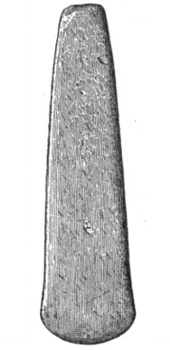
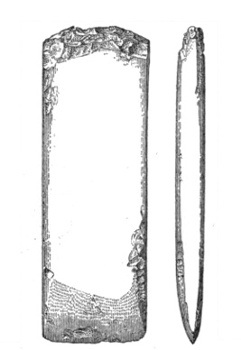
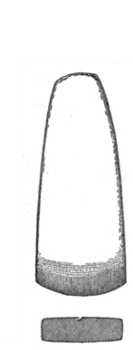
Fig. 62.—Thin polished celt.
Fig. 63.—Thin polished celt.
Fig. 64.—Thin polished celt.
While there are perhaps no true gouges in the collection, there are some examples of a form between a celt and a gouge, illustrated in figure 65, of serpentine, from Caldwell county, North Carolina.
Implements of this form are known to have been used to tap sugar maples, and also to hollow out wooden troughs, and are very common 83 in the north, though less abundant in the south.20 It is in those localities in which bark instead of logs was used for canoes that they are most numerous. Sometimes they were hollowed the whole length and used as spiles.21 They were also employed instead of celts in hollowing wooden mortars and the like when a more regular concavity was desired.22
The aboriginal implements known as “chisels” are round, elliptical, or rectangular in section. The flint and jasper specimens are generally widest at the edge, the reverse being usually the case with those of other material. Most of them have marks of hammers at the blunt end, though some are polished at the top and a few, from eastern Tennessee, are sharp at both ends. The top (except in the double-edged ones) is usually flat, though a few are pointed or very thin, almost with cutting edges. Jaspers and flints are chipped, with the facets polished, the edges highly so. Any form may occur in any locality. Almost invariably they have scraper-form edges. The length is from 2 to 6 inches.
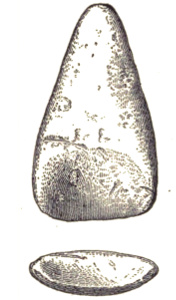
Fig. 65.—Celt, showing thin, gouge-form edge.
Typical examples are shown in figure 66, of yellow jasper, from a grave in Mississippi county, Arkansas; figure 67, of novaculite, from an unknown locality in Arkansas; figure 68, of serpentine, from Bradley county, Tennessee; figure 69, of sienite, from Caldwell county, North Carolina; and figure 70, of gray jasper, from Bradley county, Tennessee. Some specimens are sharp and worn at both ends, and could have been used only with handles.
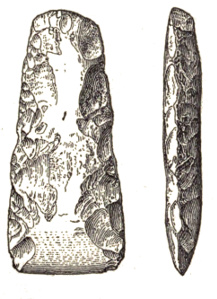
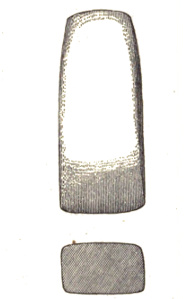
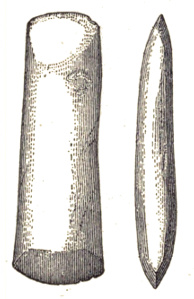
Fig. 66.—Celt, chisel-form.
Fig. 67.—Celt, chisel-form.
Fig. 68.—Celt, chisel-form.
84
The Bureau collection includes the following specimens:
| District. | A | B | C | D | E | F | G | H | I | J | K | L | M | N | O | P | Q |
|---|---|---|---|---|---|---|---|---|---|---|---|---|---|---|---|---|---|
| Northwestern North Carolina | 1 | 2 | 1 | ||||||||||||||
| Northeastern Arkansas | 32 | 5 | 2 | 4 | 1 | 1 | 1 | ||||||||||
| Southeastern Arkansas | 1 | 2 | 3 | ||||||||||||||
| Coosa district,Alabama | 1 | 1 | |||||||||||||||
| Warren county, Ohio | 1 | ||||||||||||||||
| Southwestern Illinois | 2 | 1 | |||||||||||||||
| Eastern Tennessee | 40 | 1 | 2 | 1 | 3 | 1 | |||||||||||
| Union county, Mississippi | 1 | ||||||||||||||||
| Kanawha valley, West Virginia | 5 | ||||||||||||||||
| Northwestern Georgia | 1 | ||||||||||||||||
| Savannah, Georgia | 1 | ||||||||||||||||
|
KEY: A = White flint. B = Serpentine. C = Sienite. D = Argillite. E = Granite. F = Yellow jasper. G = Gray jasper. H = Mottled jasper. I = Red jasper. J = Silicified wood. K = Quartzite. L = Black flint. M = Novaculite. N = Compact quartzite. O = Porphyry. P = Sandstone. Q = Hornblende. |
|||||||||||||||||
The high polish sometimes found on the top of a round-pointed celt may be due to its working slightly in the socket in its handle of wood, deerhorn, or other material.


Fig. 69.—Celt, chisel-form.
Fig. 70.—Celt, chisel-form.
By celts having a scraper-form edge is meant those having the edge to one side of the median line, due to constant use of one face. This face, at the edge, is in a straight line from side to side; it may have a chisel-like flattening, or may curve toward the middle of the celt for a short distance and then have the same form to the top as the other face, which is convex or curved, as in the ordinary hatchet-celt. They form a medium between celts whose faces gradually curve from top to edge, and the celt-scrapers which are flat on one side. Among the thicker celts this form is quite rare, though several, especially one from Kanawha valley, West Virginia (represented in figure 74), are quite pronounced. In the thinner specimens, however, a majority are of this pattern, while in some types, nearly all indeed, even those up to 6 inches long, are so beveled. The type, of which an illustration is shown in figure 71, is of very hard black slate; the same form is presented in figures 66 and 70.
From Bartow county, Georgia, is a scraper made from the edge of a celt which has been broken diagonally across from one face to the other. A stem like that of a spear-head has been formed by chipping away the sides of the part broken, which gives a convenient attachment for a handle; the original edge is unchanged except in the wear which has resulted from its new use. 85
The specimen shown in figure 72 (of argillite, from McMinn county, Tennessee) is introduced on account of its undoubted use as a scraper, and because it is much smaller than some of the chipped flints thus classified, the edge being less than an inch wide; the sides are roughly incurved.
In Bradley county, Tennessee, there were found over 200 specimens of very small, thin, flat, waterworn sandstone pebbles, which were mostly in their natural condition, except that they had one side rubbed to a sharp edge. A few, more slender, were ground to a point. Some of them have a handle chipped out on the side opposite the edge, sometimes with nicks in it, made for attachment to a handle by means of a cord. Most of these specimens are less than 2 inches in length. No suggestion is offered as to their use.
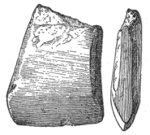
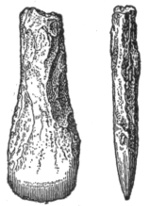
Fig. 71.—Celt, showing scraper-form edge.
Fig. 72.—Scraper.
A granite implement from Union county, Illinois, with nearly rectangular section, slightly curved sides, rounded corners, and high polish over the entire surface, having nearly the same thickness (about an inch) at every part, would seem to be a polishing or rubbing stone. There are, however, one from Warren county, Ohio, and three from Kanawha valley, West Virginia, of almost exactly the same size and pattern, which have had one end ground off to a sharp edge; so the specimen may be only an unfinished celt. One of those from Kanawha valley has had the edge partly broken away, and one face has been pecked considerably in an attempt to restore it for use; but the intention was not carried out. Some celts, not of the scraper pattern, which have the edge to one side of the median line, are perhaps broken or blunted specimens redressed on one side only.
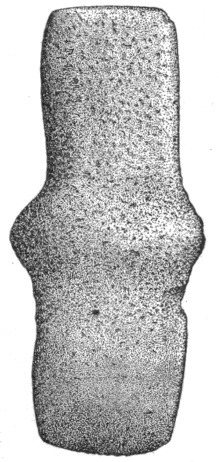

Fig. 73.—Scraper or adze, with projecting ridge.
Fig. 74.—Adze or scraper.
Figure 73 exhibits a specimen of argillite from Carter county, Tennessee, probably an adze or scraper, with a projection to keep the 86 implement from being forced into the handle. The edge is symmetrical, though much striated. The specimen shown in figure 74 (of granite, from Kanawha valley, West Virginia) represents a peculiar form. There are several like it in the collection, all but this one from islands in the Pacific.
On account of their shape and undoubted use, a class of celts, although neither pecked nor ground, is introduced. Many of them resemble, in most respects, the so-called paleolithic implements, though sometimes of better finish. They are made with a rounded top and nearly parallel sides; rudely triangular; or with the sides curved to a point at the top. The edge may be straight or curved, and is usually chipped, though sometimes ground; a few are chisel-shaped. Usually they show no signs of wear; when they do, it is always in the form of a polish at the larger end, or on the exposed facets. One of black flint, 8 inches long, from Kanawha valley, has a scraper-form edge, smoothly polished. Many, even of those scarcely changed from their original form and natural surface, have the edges dulled and polished from use as scrapers or adzes.
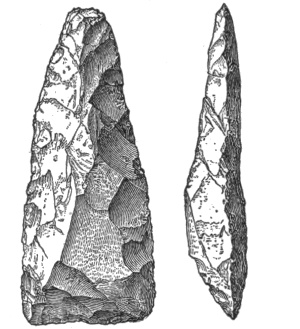
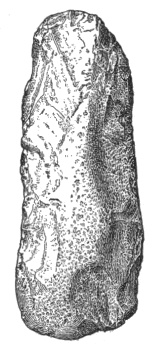
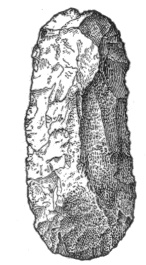
Fig. 75.—chipped celt.
Fig. 76.—Chipped celt.
Fig. 77.—Chipped celt.
The collection includes the following examples: 36 of argillite, flint, porphyry, and compact quartzite, from Montgomery county, North Carolina, some with the wider edge sharp (figure 75, of flint); 12 of limestone and flint from Mason county, Kentucky; 70 of argillite, a few with the edges ground, from southeastern Tennessee (figure 76, from McMinn county); over 300 from Kanawha valley, nearly all of black flint, a few being of diorite or quartzite—some are partly polished, or have ground edges (figure 77, of black flint, from a mound).
With the exception of two from Iowa and a few from Preston county, West Virginia, the hematite celts in the collection are from Kanawha valley, and are small, ranging in length from 1 to 2¾ inches, except one 4½ and one 5½ inches. They are illustrated in figures 78, 79, 80, and 81, the last from a mound. Nearly all have been ground directly from the 87 nodule or concretion in which this ore of iron so frequently appears. Occasionally one of homogeneous structure has been chipped into form before grinding, the facets in some cases being rubbed nearly away. Sometimes they have a rectangular outline, but usually the sides taper from the edge to the top by a gradual curve, or are parallel a part of the way and then taper either by a straight or, oftener, by a curved line. The section is rectangular or elliptical.
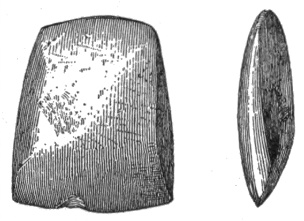
Fig. 78.—Hematite celt.
These implements were probably used as knives or scrapers, being set into the end of a piece of antler, which may in turn have been set into a larger handle of wood. That some were knives is shown by the edge which is dulled to a flat polished surface extending from side to side; and that many were scrapers is shown by their celt-scraper shape, a half elliptical section, or by the scraper-form edge, seen in the largest specimen. Some, however, have the edge symmetrical, as in the hatchet-celts. One has incurved sides, and is roughened on the sides and on the faces near the top.
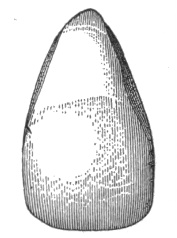
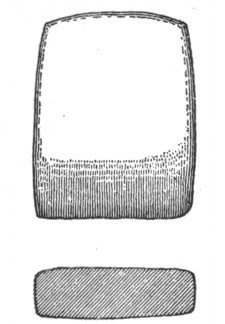
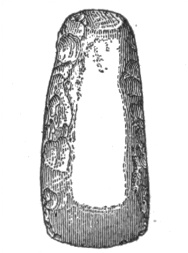
Fig. 79.—Hematite celt.
Fig. 80.—Hematite celt.
Fig. 81.—Hematite celt.
The fact of the ordinary conical or bell-shaped, long-cylindrical, or somewhat pear-shaped stones having been used for pestles is so well settled that no confirmatory references are needed. A few citations may be given in regard to certain forms sometimes differently classed, especially some of the discoidal stones to be hereafter described.
According to Stevens, the corn crushers used by the Swiss lake dwellers are spherical; some are flattened on two sides, like an orange, others almost round with depressions on four sides. They are about the size of a man’s fist or rather smaller. The Africans have a piece of quartz or other hard stone as large as half a brick, one side of which is convex, to fit the hollow of a larger stone used as a mortar.23 Evans observes that disks sometimes show marks of use as hammers 88 or pestles;24 one found at Ty Mawr was thick, with a cavity on each face.25 In preparing pemmican, the American Indians are known to have pounded the dried meat to a powder between two stones.26 This gives the impression that any suitable stones may have been used; and the ancient California Indians worked out a round stone as an acorn sheller, modern tribes using any smooth stone.27
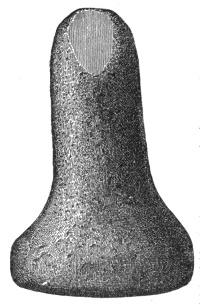
Fig. 82.—Handled pestle, with expanding base.
The pestles which have the bottom round or convex are generally found in the same localities as the hollowed stone mortars. Several forms of pestles are represented in the collection. They may be grouped as in the following description and tabulation.
A. With expanding base; bottom flat or slightly convex, often with a slight depression in the middle. Handle tapering, or of uniform diameter to the top; in a few, slightly swelling above as if to give a firmer hold. Top rounded, flat, or pointed. Bottom may be very little expanded or may have twice the diameter of the handle. Probably used for pounding grain or seeds on a flat stone, as it could not be used in a mortar even slightly hollowed. None seem to have been used as mullers or rubbers. They may have served for hammers, and would be excellent for cracking nuts, as the pit in the bottom would tend to keep them from flying out to the side. The type is shown in figure 82, of quartzite, from Sullivan county, Tennessee. The distribution is moderately wide, and the material chiefly granite and quartzite, with a few of other rock varieties, as shown in the table:
| District. | A | B | C | D | E | F |
|---|---|---|---|---|---|---|
| Northeastern Kentucky | 2 | 2 | 1 | |||
| Eastern Tennessee | 3 | 6 | 1 | |||
| Ross county, Ohio | 2 | 1 | ||||
| Miami valley, Ohio | 1 | 7 | 1 | 2 | ||
| Southwestern Illinois | 1 | |||||
| Kanawha valley, West Virginia | 1 | 1 | 1 | 1 | ||
|
KEY: A = Quartzite. B = Granite C = Sienite D = Diorite. E = Sandstone. F = Argillite. |
||||||
B. Almost cylindrical, from 6 to 18 inches long and about two inches in diameter. Some of the larger ones were probably rolling-pins, as 89 the ends, either from some fancy finish, or because worked to a point, are of a shape that would make their use as pestles impracticable. Even as rollers, some must have been used for crushing grain that had previously been softened or was not fully matured, as they are of a soft stone that would wear very easily. The shorter ones are blunt at the ends, and may have been used in a shallow wooden mortar; none are adapted for use in stone. The class is illustrated by figure 83, of soft clay slate, from Cherokee county, Georgia.
| District. | A | B | C | D | E |
|---|---|---|---|---|---|
| Montgomery county, North Carolina | 1 | ||||
| Northwestern North Carolina | 1 | ||||
| Eastern Tennessee | 3 | 2 | 3 | 1 | |
| Butler county, Ohio | 1 | ||||
| Northwestern Georgia | 1 | 1 | |||
| Hopkins county, Kentucky | 1 | ||||
|
KEY: A = Argillite. B = Soft slate. C = Clay slate. D = Mica-schist. E = Quartzite. |
|||||

Fig. 83.—Pestle, long cylindrical form.
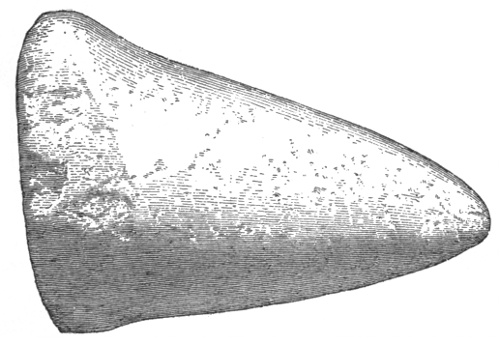
Fig. 84.—Pestle, conical.
C. Conical, or truncated cone, bottom flat, convex or curved from one side to the opposite. Some are quite smooth on the bottom as if from rubbing either back and forth or with a rotary motion; while many have the bottom pecked rough, showing use as hammers or pounders. For those with curved bottoms a rocking motion seems best adapted; with the palm resting on the longer side, good work could be done in any of these ways. Typical specimens are shown in figures 84, of quartzite, from Monroe county, Tennessee; 85, of granite, from Warren county, Ohio; and 86, of quartzite, from Saline county, Arkansas. A somewhat aberrant specimen, shown in figure 87, of granite, from Carter county, Tennessee, has an elliptical base, rounded top, and flat bottom; the longer sides grooved for handle. A similar one, of quartzite, came from Warren county, Ohio. There is considerable variety of material, quartzite largely predominating. Although 90 the geographic range is wide, the distribution is rather sparse, and several districts are not represented.
| District. | A | B | C | D | E | F | G |
|---|---|---|---|---|---|---|---|
| Southeastern Arkansas | 2 | ||||||
| Central Arkansas | 1 | 1 | |||||
| Eastern Tennessee | 12 | 1 | 1 | ||||
| Miami valley, Ohio | 3 | 1 | 3 | 2 | |||
| Montgomery county, North Carolina | 1 | 1 | |||||
| Kanawha valley, West Virginia | 2 | 1 | |||||
|
KEY: A = Quartzite. B = Marble. C = Sienite. D = Hornblende. E = Granite. F = Diorite. G = Sandstone. |
|||||||
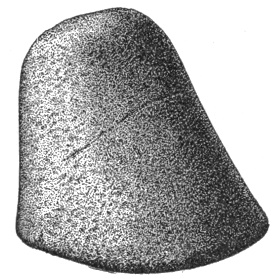
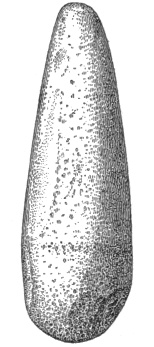
Fig. 85.—Pestle.
Fig. 86.—Pestle.
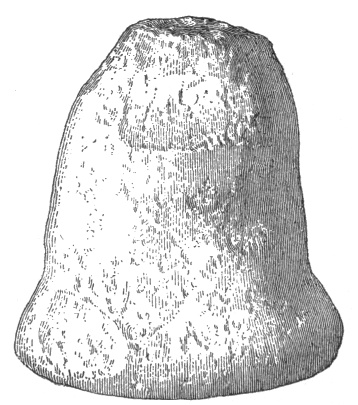

Fig. 87.—Pestle, grooved for handle.
Fig. 88.—Pestle.
D. Conical, or truncated cone, with top more or less rounded, very little worked, a stone of approximate form having been chosen and the angles and corners pecked off; bottom flat, and in some quite smooth; used as pestles or mullers. The group is represented by 17 specimens of quartzite, all from southeastern Tennessee. 91
E. Not dressed at all on the sides, but with both ends worn to a convex shape. Represented by two specimens of quartzite from southeastern Tennessee.
F. Cylindrical, flat bottom, dome-shaped top, these portions having been carefully pecked into shape. Some are smoothly polished on the bottom, but none elsewhere. Those from Miami valley, and one from Kanawha valley are much longer than the others. The type illustrated in figure 88 is of quartzite, from McMinn county, Tennessee.
| District. | A | B | C | D |
|---|---|---|---|---|
| Eastern Tennessee | 5 | 1 | 1 | |
| Kanawha valley, West Virginia | 1 | 3 | ||
| Miami valley, Ohio | 1 | 1 | ||
|
KEY: A = Quartzite. B = Porphyry. C = Sandstone. D = Limestone. |
||||
There is scarcely a locality in the country where pitted stones are not found; they are indeed of such frequent occurrence that they are seldom considered worth the trouble of gathering.
There can be no “type” among such crude implements; they are almost invariably waterworn sandstone pebbles, with a pit varying from a slight roughening of the surface to a hollow half an inch in depth pecked in each face. They probably belong with hammerstones, as they seldom show other marks of work, the edge in some being only slightly marked in one or two places, while in others it is much worn.
Various numbers of the Journal of the Anthropological Society of Great Britain and Ireland refer to pitted stones as found in every part of the world. According to Evans, slight pits aid in holding stone hammers; they also prevent the jar to a large extent. If used to pound meat or break bones, it would be hard to hold them when greasy without pits.28 Such implements may have had handles of wood with projections to fit the pits,29 though this is not probable; but if so a piece of buckskin on the handle opposite the pits would do better and be more convenient to apply.
Conjecture and theory have had full sway in regard to the uses of cupped stones; but the question is apparently far from solution. There is a prevalent idea that they were used for cracking nuts; but why should an Indian make a large number of holes in a great many stones for such purpose? It is true there would be an advantage in having the nut stand on one end; but very few stones have depressions that will allow this.
Of the southern Indians Adair observes:
They gather a number of hiccory-nuts, which they pound with a round stone, upon a stone, thick and hollowed for the purpose. When they are beat fine enough, they 92 mix them with cold water, in a clay basin, where the shells subside. The other part is an oily, tough, thick, white substance ... with which they eat their bread.30
Lawson’s language regarding the Indians of North Carolina is even more definite. He says:
[They gather] likewise hickerie nuts, which they beat betwixt two great stones, then sift them, so thicken their venison broth therewith, the small shells precipitating to the bottom of the pot, whilst the kernel, in the form of flour, mixes it with the liquor, both these nuts [hickory and chinquapin] made into meal makes a curious soup, either with clear water, or in any meat broth.31
Neither of these statements seems to have any reference to cupped stones. The first is a good description of a mortar with a round pestle, while the second says nothing about any particular form of stone; yet they have been referred to time and again as proof of the nut-stone theory. There would be some difficulty in pounding nuts fine in small holes half an inch or more below where the pounding stone could reach.
C. C. Jones32 was satisfied that cupped stones were used for cracking nuts because great numbers of nut-bearing trees grow where they are found; while Whittlesey, noting the fact that hundreds of them are found throughout northern Ohio, considered them as sockets in which the end of a spindle rested. Dawson33 speaks of “stones having deep hollows in the sides which were mortars for grinding pigments, or sockets for fire drills.”
The cupped stones in the Bureau collection are almost invariably of reddish sandstone, of varying texture, from a few ounces to 30 pounds in weight. The holes are from one to twenty-five in number, of various sizes even in the same stone, and follow the natural contour of the surface even when that is quite irregular; the stone is never dressed or flattened to bring the cups on a level; none show any marks of work, but are the rough blocks or slabs in their natural state.
Many of the holes are roughly pecked in, but the larger ones are usually quite smooth, as if ground out, and almost complete hemispheres. They range from a pit only started or going scarcely beyond the surface to one 2 inches in diameter. The smaller ones with one cup pass into the pitted stones. Occasionally at the bottom of a large cup there is a small secondary hole as though made by a flint drill.
The polished cups may have been used for fire-drill or spindle sockets, though why there should be a number of holes when but one could be used at a time awaits explanation. The rough ones may have been for holding nuts, and so long as they were on the same plane any number could be utilized; but when they are on different parts of the stone, even on opposite sides, as many of them are, the question remains open. Slabs or thin pieces nearly always have cups on both sides, while blocks or thick slabs have them on one side only. On the 93 former a number of nuts could be cracked with one blow of a flat stone and thrown into a receptacle of some kind, either side of the stone being used at pleasure; but there would be no economy of time or work in this method, and it would be very strange that any one should not learn with so much experience that a nut should never be laid on the flat side in cracking. No theory yet advanced accounts for the greater number of such relics, namely, the irregular fragments of stone with cups at varying intervals and different levels.
No division can be made in regard either to size or material of the stone, or to form or finish of the cups. Many of the smaller ones were no doubt paint mortars. One well finished specimen of this class is shown in figure 89; it is of quartzite from 4 feet beneath the surface in Crittenden county, Arkansas.
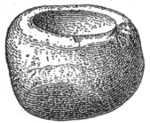
Fig. 89.—Cupped stone or paint cup.
Cupped stones are found wherever representatives of the Bureau have worked, and numerous references might be given concerning their existence in other localities.
The objects known as mullers are generally flat and smooth on one side and convex on the other, sometimes with a pit in one side or both, mostly of granite, quartzite, or sandstone; rarely of other materials.
A fine specimen of white quartz from Elmore county, Alabama, has the bottom flat and highly polished, the edge perpendicular to bottom and rounding off into the slightly convex top, with a pit at center. Figure 90 represents a muller of marble or crystalline limestone from a grave in Randolph county, Illinois. It has a smooth, flat bottom, with convex top somewhat smaller than the base; around the circumference there is a depression polished by wear. A similar specimen, of diorite, from Carter county, Tennessee, seems to be the lower part of a pestle with expanding base, whose top or handle has been lost, the part remaining having a place for a handle pecked around it.

Fig. 90.—Muller, showing polished surface.
The discoidal stones with this shape were probably used as mullers; they were also used as pestles in the hollow mortars, as the edge is often chipped or pecked, which would account for the pits on the faces. Figure 91 represents a muller of granite from Savannah, Georgia. Sometimes the base has an elliptical instead of a circular outline, as seen in other specimens from Savannah.
Mullers are found wherever there are indications of occupancy for any considerable length of time.
Stones evidently used for grinding and polishing need only to be mentioned, as they are of widespread occurrence. Implements used for the 94 former purpose are made of any siliceous stone of convenient size and suitable texture, from a coarse quartzite to a very fine close-grained sandstone, according to the class of work to be done. The markings on them range from the narrow, sharp, incised lines due to shaping a small ornament, to the broad grooves resulting from grinding an ax or celt into form. Nearly all of those in museums are small specimens used for rubbing; but there are many large blocks in various localities, sometimes several feet square, marked and scored in every direction by grinding or sharpening the large implements on them.
Among the polishers may be included a number of small pebbles of very hard siliceous stone, generally some form of quartz, which by the high polish show long use. The larger ones may have been used for rubbing skins in tanning, as they can easily be grasped in the hand. Very few have changed from their primitive form to a greater degree than would naturally result from the wear upon them. A few very small ones, long-ovoid in shape, usually not over 2½ or 3 inches in length, were probably paint mullers, as they are well fitted for use in small paint cups. Many of the discoidal stones—which will be spoken of under the proper head—may have had these functions. The highly polished specimens are all from the southern states. There is one rubbing stone of pumice from Craighead county, Arkansas.
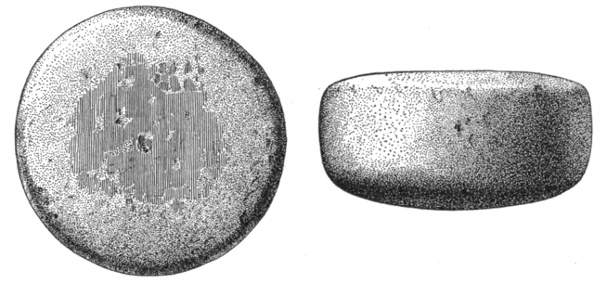
Fig. 91.—Muller, showing polished surface.
Hammers or hammerstones show every stage of work, from the ordinary pebble or fragment, with its surface scarcely altered, to the highly polished round or ovoid “ball.” They are usually of the hardest available material, and seem to be of more frequent occurrence in the northern districts than in the southern states, though found everywhere. Used in their earlier stages merely as tools with which to fashion other implements, they were assigned to specified purposes when brought to a better finish or form. A typical example, shown in figure 92, is of granite, from Ross county, Ohio.
The Sioux used an oval stone, with a piece of rawhide covering all 95 but the point and attaching it to a withe handle,34 while the Shoshoni and Ojibwa made use of a round stone, wrapped in leather, attached by a string of 2 inches to a handle 22 inches long covered with leather; this was called a poggamoggan.35 Rounded stones are said to have been used by the California Indians as bolas,36 though it is more probable that they were slung-shots. The ancient Californians worked out a round stone for an acorn-sheller; the present Indians use any smooth stone.37 Elaborately carved round stones, mounted in handles as clubs, are known to have been used by the Queen Charlotte Island Indians for killing fish,38 and other northwestern Indians have been observed to use a round stone inclosed in a net and attached to a line as a sinker.39
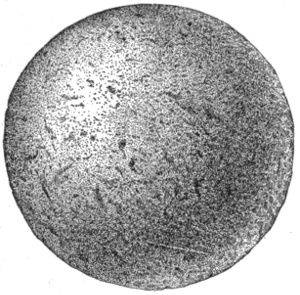
Fig. 92.—Hammerstone.
It is not necessary to quote references to the well-known fact that the Eskimo and the Patagonians made use of round stones of various sizes as bolas. There is no evidence that our Indians ever used anything of the sort.
Three subclasses of grooved stones, differing in essential features from axes, may be discriminated. They are as follows:
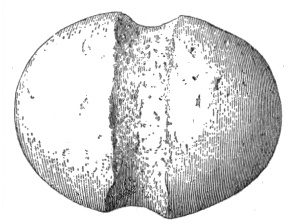
Fig. 93.—Grooved round stone.
A. Slightly or not at all worked, except the groove; often showing marks of violent usage. With these may be classed the large stone hammers of the Lake Superior region.
B. Round or ellipsoid stones; in the latter the groove may follow either axis. The type (figure 93) is of sandstone from Carter county, Tennessee.
C. Resembling axes in all but the edge. Of class A there are none in the collection; their form and size are such that they could have been for no other purpose than hammerstones. Of class B there are some from Savannah, which may be sinkers or club heads. According to Morgan, oval stones with grooves were secured in the heads of war clubs,40 and Carver observed that the southwestern Indians used as a slung-shot a curiously worked stone, with a string a 96 yard and a half long tied to it, the other end being tied to the arm above the elbow.41
The specimens of class C may be broken axes. Figure 94 (granite, from Butler county, Ohio) shows a form quite common throughout central and western Ohio. They are generally small, have evidently never been sharp, and were in all probability intended for hammers from the beginning.
The Indian mortars in the collection are nearly always of sandstone of varying degrees of fineness. As is the case with cupped stones, when made of slabs, both sides have been worked; when of rough blocks, only one.
The Senecas and Cayugas are said by Morgan to have used wooden mortars in which to pound corn after it was hulled,42 and it is possible that the long pestles of soft stone were used with wooden mortars, though some are not well adapted to this use. The Iroquois women pounded in stone mortars the stony material used in tempering the clay for their pottery.43 The California Indians made mortars by knocking a segment off a bowlder, making a flat surface, and working out with a hammer and chisel,44 while the tribes of the interior worked directly from the surface of a suitable rock. The Yokuts, according to Powers, use tolerably well made stone mortars, and sometimes place a basket-like arrangement around the top to prevent the acorns from flying out.45
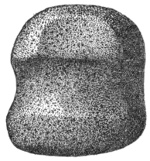
Fig. 94.—Grooved hammer.
No two specimens of the mortars and metate-like stones in the Bureau collection are alike; the nearest approach that can be made to a classification is as follows:
A. Smooth and flat on one or both sides; for use with mullers; from McMinn county, Tennessee, and Allamakee county, Iowa.
B. With round cavities on one or both sides; for round or cylindrical pestles; from McMinn county, Tennessee. A cobblestone from Bradley county, Tennessee, has a shallow cavity in either side and a pit in the center of each. From Kanawha valley there is a slab weighing about 25 pounds, flat and smooth on one side, as though primarily used with a muller and the regular even cavity afterward made; on the other side a cavity and a cupped hole have been worked in from the natural surface. A slab from Warren county, Ohio, has a shallow cavity worked into one side and a cupped hole in the other. From Union county, 97 Mississippi, there is a flattened bowlder with a shallow cavity on each side; a shallow cup has been pecked on the edge of one of them. From Caldwell county, North Carolina, comes a bowlder of water-worn mica-schist, with a shallow cavity and a deeper one on one side, and on the other a cupped hole opposite each of these cavities.
C. With one side hollowed out, the other flat and smooth. Specimens of this type come from Caldwell county, North Carolina; McMinn county, Tennessee, and Bradley county, Tennessee, the last with a pit in the center and another on the edge of the flat side.
D. With a long, narrow depression on each side. A very large specimen of fine-grained sandstone from Lincoln county, Arkansas, represents this type.
There are, in addition, two pieces of fine-grained sandstone with uniform thickness of less than an inch and about 10 inches across, from Kanawha valley, West Virginia, and Hale county, Alabama, respectively. Both sides are ground perfectly smooth, and flat. The objects were probably for some culinary purpose.
The sinkers in the collection may be divided into four classes, viz: A, entirely unworked; B, notched on the sides; C, encircled by a groove; and D, perforated. Conversely, stones under all these different heads may have served other and widely different purposes.
Of the functions of class A, only those who have seen them in use can speak. Stevens mentions that some tribes inclose a round stone in a sort of net and attach it to a line in fishing;46 and no other use can be imagined for some of the specimens in the Bureau collection.
Specimens of class B are found along water courses in such situations as to leave no doubt of their use as sinkers;47 they were attached to grapevines and dragged on the bottom of streams to frighten fish into nets or traps.48 Those in the collection are made of ordinary flat water-worn pebbles, with notches rudely chipped in the sides; a number are from southeastern Tennessee.
Of class C, while many were perhaps sinkers, more were club heads and slungshots or hammers. A number have been obtained from Savannah, Georgia, more or less worked, some being rounded, with grooves of varying depths and sizes. Small stones of this form are used by Greenland fishermen as sinkers;49 and according to Thatcher, a large stone is by the Indians made fast to a sinking line at each end of a net, and the net is spread in the water by sinkers at different parts of it.50
Class D will be referred to under the head “Perforated stones,” from which they can be discriminated only arbitrarily. 98
A number of roughly chipped, somewhat crescent-shaped specimens of argillite, from half a pound to 2 pounds in weight, collected in Montgomery county, North Carolina, may have been used as sinkers.
Only the larger or rougher perforated stones used as implements are included in this class.
Several perforated pieces of steatite, some mere rough fragments, others with the edges smooth and dressed to a somewhat symmetrical outline, have been collected about Savannah, Georgia. Some of these have been drilled, others gouged through apparently with a slender flint. In the latter group the little projections left by the tool have been worn smooth. The hole may be near one end or about the center. Similar pieces have been found in Forsyth county, Georgia; one of these is worked to an irregular pentagon and smoothly finished. From Haywood county, North Carolina, there are some very rough fragments, apparently just as they were picked up, except for the perforation; and a number of pieces of perforated pottery are from Montgomery county, North Carolina.
Perforated stones were used by the southern Indians to drag along the bottoms of streams and frighten fish into their nets and traps.51 Four disks 4 to 5½ inches in diameter, with handles from 13 to 17 inches long, were found in a cave at Los Angeles, California,52 and objects of this character were, according to Schumacher, used by the Santa Barbara Indians as weights for wooden spades.53 According to Abbott many perforated stones are found close to rivers and on shores in such positions as to leave no doubt of their use as sinkers.54 Similar stones were used as sinkers by the Scandinavians in comparatively recent times; by the Bechuanas for grinding grasshoppers, spiders, etc., and also as weights for digging-sticks; by some savages in the Pacific islands as clubs; by the Icelanders for breaking up salted fish.55 They were used by the Iroquois as weights for fire drills;56 by the Eskimo as clubs, having a rawhide handle secured by a knot.57 According to Dale,58 Layard,59 Griesbach,60 and Gooch,61 they were used by natives of southern Africa as root-diggers (to remove earth from the roots), as weapons, and to give weight to digging-sticks. They were also used by the Peruvian Indians to be thrown with a stick. Disk-shaped and 99 cylindrical throwing stones, perforated for the stick, are found among the Swiss lake dwellings.62 According to Evans63 they were used mostly as hammers or clubs. They are hard and battered on the edges; sinkers would be of softer stone.
The most complete article that has yet been given concerning the forms and uses of perforated stones is that by H. W. Henshaw.64
There are numerous references to discoidal stones by various writers, but a majority of the objects do not fall under any explanation that has so far been given.
The Choctaw Indians used disks two fingers wide and two spans around in playing “chungke,”65 and the Indians of North Carolina were much addicted to a sport called “chenco,” played with a staff and a bowl made with stone.66 The same kind of game was, or still is, played with hoops or rings of wood or rawhide by the Iroquois,67 the Pawnee,68 the Apache,69 the Navajo,70 the Mohave,71 and the Omaha;72 also, with rings of stone, by the Arikara,73 the Mandan,74 and other tribes.
The game of chungke, however, will account for only a small part of the great number of stones of this form. The Indians of southern California, in manufacturing pottery, make the clay compact and smooth by holding a rounded and smooth stone against the inside.75 The Fijians, in making pottery, use a small, round flat stone to shape the inside,76 while the Indians of Guiana use ancient axes or smooth stones for polishing the clay in making their vessels.77 According to Evans,78 pitted disks were used as pestles, hammers, or mullers; a thick one with pitted ends was found in a mortar at Holyhead.79 Under the head of pestles and of perforated stones further references will be found that may apply as well to this form of implements.
No kind of relic is more difficult to classify. From the smooth, symmetrical, highly-polished chungke stone they gradually merge into mullers, pestles, pitted stones, polishers, hammers,80 ornaments, and 100 the ordinary sinker or club-head, so that no dividing line is possible. Theories constructed on a basis of their use may be far from correct.
They present various forms and degrees of finish; many have the natural surface on both sides with the edge worked off by grinding or pecking, the latter being produced probably by use as a hammer; the sides may be ground down while the edge remains untouched; or the sides may be pecked and the edge ground, being probably of a thick pebble originally. Some of the finer grades, as chalcedony and quartz, that have received the highest finish, appear to have had all the work done by grinding or rubbing, as even those only slightly worked bear no signs of hammering or pecking. When of the harder materials they are generally made of water-worn pebbles as nearly the desired form as can be found; in fact, some specimens which are in their natural state, entirely unworked, require a very close examination to distinguish them from others whose whole surface has been artificially produced. In the jasper conglomerates from Arkansas, however, there is a regular series from a roughly chipped disk to one of the highest polish and symmetry. The larger ones of quartz, particularly those with concavities in the sides, must have been patiently wrought for years before brought to their present state. Many of the smaller ones, especially sandstone, seem to have been designed for grinding or polishing.
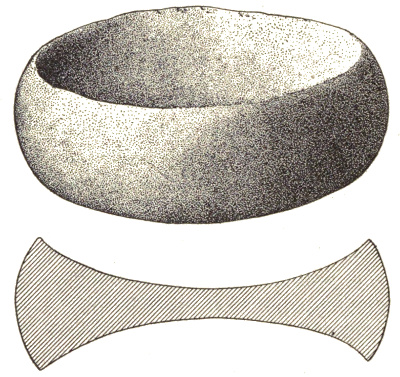
Fig. 95.—Discoidal stone.
The following groups are represented in the collection:
A. Sides hollowed out, edge convex; 2 to 6 inches diameter, seven-eighths to 2¾ thick.
1. Edges of concavity sharp.
a. Cavity a regular curve from side to side. The type (figure 95) is of quartz, from Cherokee county, Georgia. There are also, from Kanawha valley, West Virginia, one of sandstone, of which one side has been worked out by a flint, the little pits being distinctly visible, while the other side has natural surface; from Loudon county, Tennessee, one of 101 quartzite, 6 inches diameter, which has been used as a mortar, the cavities being roughened, with their edges broken and scarred (the edge of the stone is battered entirely around midway between the sides as though used for a hammer); from McMinn county, Tennessee, one of quartzite, about the same size as last, with a slight pit in the center of each cavity, the edges of the concavity being considerably chipped, and the edge of the implement very smooth; from Polk county, Tennessee, one of quartzite, 3½ inches in diameter, with the edge polished except in one spot, where it shows marks of use as a hammer or pestle—it has been used also as a mortar, the edges of the concavity being much chipped and broken; one each from Craighead county, Arkansas, of novaculite; Randolph county, Illinois, of granite; Cherokee county, Georgia, of quartz; and Obion county, Tennessee, of sandstone. In the four last mentioned the entire surface is quite smooth or even highly polished.
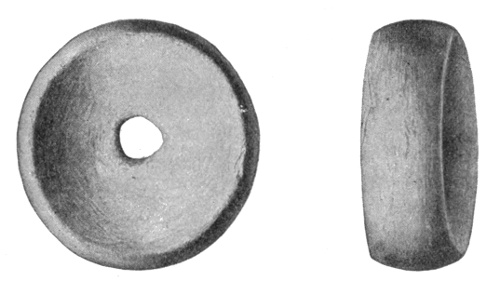
Fig. 96.—Discoidal stone, with perforation.
b. With a small perforation at the center. The type is shown in figures 96 (of sandstone, from a grave in Union county, Illinois), and 97 (of granite, from Virginia). There is another specimen, of sandstone, from Red River county, Texas.
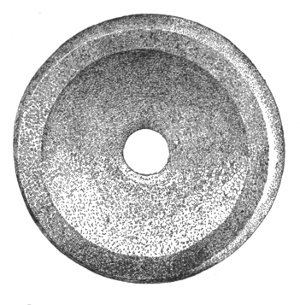
Fig. 97.—Discoidal stone, with perforation.
c. With a secondary depression in each cavity. Figure 98 (yellow quartz, highly polished, from Fulton county, Georgia) is typical. There is also one of quartzite, with a secondary depression in one side only, from Roane county, Tennessee, which may be supposed, from this and other imperfections, to be unfinished.
2. Edges of concavity rubbed off blunt. These are grouped simply by form, as the specimens from Kanawha valley, West Virginia, and northeastern Kentucky are nearly all roughly finished, quite different 102 from the smooth or polished ones from farther south. Some are worked out into the form of a ring, and there is every stage between that form and the flat disk whose sides show no trace of pecking. Figure 99 (quartzite, from Sevier county, Tennessee) illustrates a typical example, roughly worked but entirely perforated, and figure 97 shows the same type in another form.
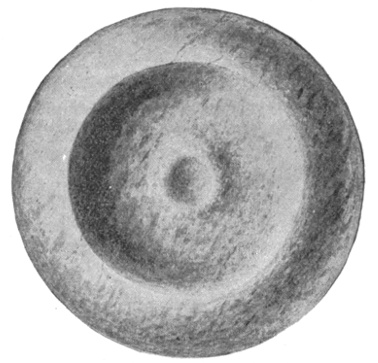
Fig. 98.—Discoidal stone, with secondary depression.
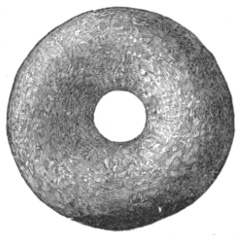
Fig. 99.—Discoidal stone, in form of a ring.
| District. | A | B | C | D | E | F |
|---|---|---|---|---|---|---|
| Caldwell county, North Carolina | 1 | |||||
| Crittenden county, Arkansas | 1 | |||||
| Drew county, Arkansas | 1 | |||||
| Randolph county, Illinois | 1 | 2 | ||||
| Eastern Tennessee | 1 | 1 | ||||
| Bartow county, Georgia | 1 | |||||
| Kanawha valley, West Virginia | 1 | 1 | 1 | |||
| Northeastern Kentucky | 22 | |||||
|
KEY: A = Quartz. B = Novaculite. C = Flint. D = Quartzite. E = Sandstone. F = Granite. |
||||||
103
B. Flat or slightly concave sides, edges straight and at right angles to the sides; diameter, 1⅝ to 5 inches. The type shown in figure 100 is of sandstone from Lauderdale county, Alabama.
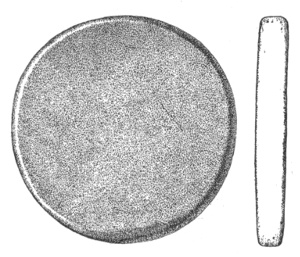
Fig. 100.—Discoidal stone.
| District. | A | B | C | D | E |
|---|---|---|---|---|---|
| Lauderdale county, Alabama | 1 | ||||
| Mississippi county, Arkansas | 1 | 1 | 1 | ||
| McMinn county, Tennessee | 1 | 4 | |||
| Kanawha valley, West Virginia | 1 | ||||
|
KEY: A = Sandstone. B = Quartzite. C = Very fine schist. D = Yellow jasper. E = Argillite. |
|||||
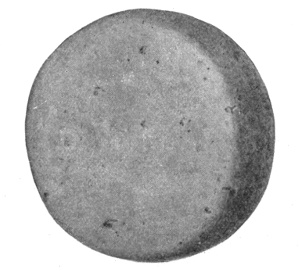
Fig. 101.—Discoidal stone.
C. Sides flat; edges straight, sometimes rounding off into the sides; diameter, 2¼ to 6 inches; thickness, three-quarters to 2¼ inches. A number from southeastern Tennessee, especially the smaller ones, are quite rough, being merely pecked or chipped into shape with no subsequent 104 rubbing. Figure 101 (chalcedony, from a mound in Monroe county, Tennessee) represents the type. The material is variable.
| District. | A | B | C | D | E | F | G | H | I |
|---|---|---|---|---|---|---|---|---|---|
| Southeastern Tennessee | 5 | 5 | 1 | 3 | 1 | 9 | |||
| Western Tennessee | 1 | 1 | |||||||
| Savannah, Georgia | 1 | 7 | 1 | ||||||
| Mississippi county, Arkansas | 1 | ||||||||
|
KEY: A = Quartz. B = Sandstone. C = Argillite. D = Chalcedony. E = Limestone. F = Marble. G = Granite. H = Jasper conglomerate. I = Quartzite. |
|||||||||
D. Like the last, except much smaller. Very few are polished over the entire surface; some are rubbed more or less on the edges or sides, but a majority have the edge rough as it was chipped or pecked out; many have either the edge or sides in the natural state. From those smoothly polished to those very rudely worked the gradation is such that no dividing line can be drawn. This is true, also, of the smaller specimens of other types. Some of the quartzite specimens are very loose in texture. From seven-eighths to 2 inches in diameter and one-fourth to three-fourths of an inch thick.
| District. | A | B | C | D | E | F | G | H | I | J |
|---|---|---|---|---|---|---|---|---|---|---|
| Eastern Tennessee | 1 | 54 | 64 | 32 | 1 | 12 | 4 | |||
| Bartow county, Georgia | 1 | 1 | 1 | 4 | ||||||
| Savannah, Georgia | 2 | |||||||||
| Kanawha valley, West Virginia | 7 | 20 | 1 | |||||||
| Northeastern Kentucky | 14 | 5 | ||||||||
|
A = Marble. B = Sandstone. C = Argillite. D = Granite. E = Red jasper. F = Quartzite. G = Micaceous sandstone. H = Limestone. I = Quartz. J = Cannel coal. |
||||||||||
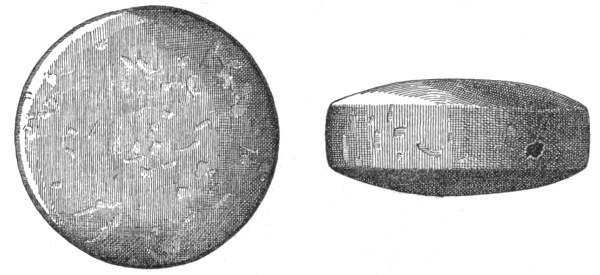
Fig. 102.—Discoidal stone, convex.
E. Convex on both sides, edges straight. One of white quartz from Caldwell county, North Carolina, has the sides much curved, making the stone very thick in proportion to its width; there is a deep pit on each side, the entire surface being highly polished. Diameter, 2 to 3½ 105 inches; thickness, three-fourths to an inch and a half. Illustrated by figure 102 (of porphyry, from a grave in Caldwell county, North Carolina).
| District. | A | B | C | D | E | F | G | H | I | J | K | L | M | N | O | P | Q | R | S |
|---|---|---|---|---|---|---|---|---|---|---|---|---|---|---|---|---|---|---|---|
| Eastern Arkansas | 3 | 1 | 1 | 1 | 4 | 7 | 1 | 7 | 1 | 1 | |||||||||
| Eastern Tennessee (many of these rough and entirely without polish) | 1 | 88 | 29 | 1 | 1 | 31 | 27 | 8 | 1 | 1 | 2 | ||||||||
| Kanawha valley, West Virginia (rough) | 1 | ||||||||||||||||||
| Savannah, Georgia | 1 | 3 | |||||||||||||||||
| Union county, Mississippi | 1 | ||||||||||||||||||
| Caldwell county, North Carolina | 1 | 10 | 4 | 1 | 2 | 1 | 2 | 1 | |||||||||||
|
KEY: A = Yellow jasper. B = Iron ore. C = Mica schist. D = Novaculite. E = Jasper conglomerate. F = Quartzite. G = Quartz. H = Hornblende. I = Marble. J = Clayey limestone. K = Argillite. L = Sandstone. M = Limestone. N = Sienite. O = Granite. P = Chalcedony. Q = Steatite. R = Black flint. S = Porphyry. |
|||||||||||||||||||
F. Same form as the above; 1¼ to 2 inches in diameter, one-half to seven-eighths of an inch thick.
| District. | A | B | C | D | E | F | G | H | I | J |
|---|---|---|---|---|---|---|---|---|---|---|
| Elmore county, Alabama | 2 | 1 | 1 | 1 | ||||||
| Western North Carolina | 1 | 2 | ||||||||
| Eastern Tennessee | 2 | 1 | 9 | 1 | ||||||
| Bartow county, Georgia | 1 | 1 | 1 | 2 | ||||||
| Savannah, Georgia | 3 | |||||||||
| Kanawha valley, West Virginia | 4 | |||||||||
| Drew county, Arkansas | 1 | |||||||||
|
KEY: A = Jasper. B = Mica schist. C = Micaceous sandstone. D = Quartzite. E = Quartz. F = Marble. G = Argillite. H = Sandstone. I = Limestone. J = Steatite. |
||||||||||
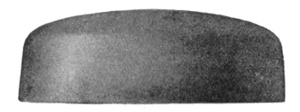
Fig. 103.—Discoidal stone.
G. Flat or slightly convex on one or both sides, edge straight, one side wider than the other. Some have the edge battered or chipped and it is always at the angle of the edge with the wider side. From 1⅝ to 3½ inches in diameter, and three-fourths to an inch and a half 106 thick. The specimen shown in figure 103 (of compact quartzite, from Bartow county, Georgia) is typical. The material is quite diverse.
| District. | A | B | C | D | E | F | G | H | I | J | K |
|---|---|---|---|---|---|---|---|---|---|---|---|
| Eastern Tennessee | 2 | 1 | 2 | 2 | 1 | ||||||
| Savannah, Georgia | 1 | 3 | |||||||||
| Bartow county, Georgia | 1 | 1 | |||||||||
| Kanawha valley, West Virginia | 2 | 1 | |||||||||
| Caldwell county, North Carolina | 3 | 1 | 1 | 2 | |||||||
| Mississippi county, Arkansas | 1 | ||||||||||
|
KEY: A = Sandstone. B = Marble. C = Quartzite. D = Quartz hornblende. E = Granite. F = Quartz. G = Compact quartzite. H = Sienite. I = Chalcedony. J = Schist. K = Flint. |
|||||||||||
There are also of this type, one of very hard black stone (not identified) from Red River county, Texas, three-fourths of an inch in diameter; one of barite from Bartow county, Georgia, one inch in diameter, three-fourths inch thick; and one of granite, from Chester county, South Carolina, an inch in diameter. There are also one of quartzite from Drew county, Arkansas, with a shallow pit on each side; one of the same material from southeastern Tennessee, with a deep pit gouged in smaller side; and from the same locality, three of quartzite, one of quartz, and one of sandstone, each with a deep pit in the larger side. All of these are small and none of them polished.
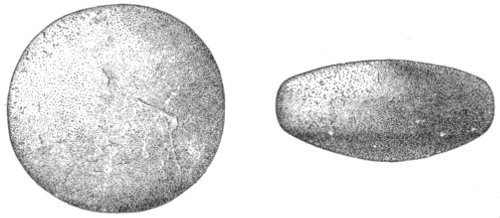
Fig. 104.—Discoidal stone.
H. Convex sides and curved edges; size as in group G. The type (figure 104) is of quartz, from Caldwell county, North Carolina.
| District. | A | B | C | D | E | F |
|---|---|---|---|---|---|---|
| Catahoula parish, Louisiana | 1 | |||||
| Eastern Tennessee | 2 | 3 | ||||
| Caldwell county, North Carolina | 2 | 1 | ||||
| Northeastern Arkansas | 1 | 1 | ||||
|
KEY: A = Jasper conglomerate. B = Quartz. C = Limestone. D = Quartzite. E = Sandstone. F = Conglomerate. |
||||||
107
I. Same form, rough and not polished; 1 to 2¾ inches in diameter, one-half to 1 inch thick.
| District. | A | B | C | D | E | F |
|---|---|---|---|---|---|---|
| Eastern Tennessee | 50 | 3 | 11 | 10 | ||
| Northeastern Arkansas | 1 | 3 | 3 | |||
| Caldwell county, North Carolina | 1 | |||||
| Kanawha valley, West Virginia | 36 | 1 | ||||
|
KEY: A = Quartzite. B = Flint. C = Yellow jasper. D = Argillite. E = Quartz. F = Sandstone. |
||||||
J. Sides slightly convex, edge slightly curved; 2¼ to 3½ inches in diameter, three-quarters to an inch and a half thick.
| District. | A | B | C | D | E | F | G | H |
|---|---|---|---|---|---|---|---|---|
| Kanawha valley, West Virginia (evidently used for a hammerstone) | 1 | |||||||
| Eastern Tennessee | 2 | 3 | 4 | 1 | 2 | 1 | ||
| Lauderdale county, Tennessee | 1 | |||||||
| Caldwell county, North Carolina | 2 | 1 | ||||||
| Fulton county, Georgia | 1 | |||||||
|
KEY: A = Sandstone. B = Quartz. C = Quartzite. D = Chalcedony. E = Argillite. F = Clayey limestone. G = Steatite. H = Sienite. |
||||||||
K. Sides flat; edges convex; roughly finished, no polish; 1⅛ to 2¼ inches in diameter, three-eighths to three-fourths of an inch thick.
| District. | A | B | C |
|---|---|---|---|
| Kanawha valley, West Virginia | 1 | 1 | |
| Eastern Tennessee | 4 | 1 | 7 |
|
KEY: A = Sandstone. B = Quartz. C = Quartzite. |
|||
L. Not polished; roughly chipped edges; 2 to 3½ inches in diameter.
| District. | A | B | C | D |
|---|---|---|---|---|
| Mississippi county, Arkansas | 1 | 1 | 1 | 3 |
| Bartow county, Georgia | 1 | |||
| Union county, Mississippi | 3 | |||
|
KEY: A = Sandstone. B = Quartzite. C = Chalcedony. D = Yellow jasper. |
||||
M. Edges V-shape; 1¾ to 2½ inches diameter, 1 to 1½ inches thick. The type (figure 105) is of granite, from Randolph county, Illinois, with insunk pecked sides and polished edge. A specimen from Kanawha valley, West Virginia, is of flint, with only the edge worked; apparently 108 a hammer. One from Craighead county, Arkansas, has flat sides and the entire surface polished; another from McMinn county, Tennessee, is also polished entire. A good specimen from Cocke county, Tennessee, is of flint, one side rubbed flat, the other a rounded cone, highly polished.
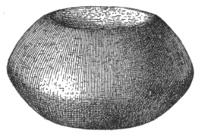
Fig. 105.—Discoidal stone, with V-shaped edges.
N. Sides hollowed out; edges straight or slightly curved; very thick; used as mortars, hammers, or pestles. This form gradually merges into disk-shaped, pitted, or entire dressed hammers, which in turn run into the ordinary hammerstones. The types are figures 106 (quartzite, from Bradley county, Tennessee) and 107 (quartzite, from Nicholas county, Kentucky). There are in this group from eastern Tennessee three of quartzite, 2¼ by 4½ inches, 4¼ by 5¾ inches, and 1¾ by 3¼ inches, and one of granite, 2¾ by 3 inches; from Caldwell county, North Carolina, one of granite; and from Montgomery county, North Carolina, three of quartzite. The last four are evidently hammers or pestles. In addition there is a specimen from Jackson county, Illinois, of ferruginous sandstone, 3 inches in diameter. On one side there is a pit and on the other a shallow, mortar-like cavity extending entirely across.

Fig. 106.—Discoidal stone, used as mortar.
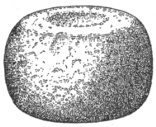
Fig. 107.—Discoidal stone, probably used as hammer.
O. One side flat, the other rounded; of convenient size for grasping. In some the bottom is quite smooth. There is sometimes a pit in one or both sides, more frequently in the bottom. They were used as mullers or pestles; in the latter, either the side or the edge may have been the pounding surface. The line between these implements and the cylindrical, dome-topped pestles can not be drawn (see figure 91).
| District. | A | B | C | D |
|---|---|---|---|---|
| Eastern Tennessee | 1 | 2 | ||
| Southwestern Wisconsin | 2 | 1 | 1 | |
| Kanawha valley, West Virginia | 1 | |||
| Crittenden county, Arkansas | 1 | |||
| Jackson county, North Carolina | 1 | |||
| Warren county, Ohio | 1 | |||
| Savannah, Georgia | 2 | 1 | 2 | 8 |
|
KEY: A = Quartzite. B = Quartz. C = Sandstone. D = Granite. |
||||
109
P. Sides flat; edge convex; same size and use as last.
| District. | A | B | C | D |
|---|---|---|---|---|
| Southeastern Tennessee | 1 | 1 | ||
| Kanawha valley, West Virginia | 3 | 5 | ||
| Warren county, Ohio | 1 | |||
| Madison county, Alabama | 1 | |||
|
KEY: A = Quartzite. B = Quartz. C = Sandstone. D = Granite. |
||||
Q. From southeastern Tennessee and northwestern Georgia there are many disk-shape fragments of pottery, small, thin, and coarse, with the edges roughly chipped; and from northeastern Kentucky there are similar pieces, except that they have been fashioned from fragments of limestone and sandstone. These specimens are illustrated by figure 108 (pottery, from a mound in Bartow county, Georgia).
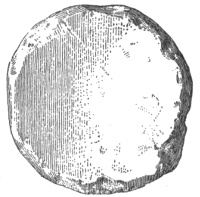
Fig. 108.—Discoidal pottery fragment.
It has been a puzzle to archeologists to assign to any class the peculiar stones called “spuds.” They are usually of a comparatively soft material, carefully worked and polished, and bear no marks of rough usage. On the other hand, they seem too large for ornament. Perhaps their office may have been in some ceremony or game. Something similar in form seems to be denoted in the following extracts:
Col. James Smith81 says, speaking of the Indians of western Pennsylvania, that as soon as the elm bark will strip in spring, the squaws, after finding a tree that will do, cut it down, and with a crooked stick, broad and sharp at the end, take the bark off the tree, and of this bark make vessels. The Twana Indians, who formerly lived at the south end of Hoods canal, Washington, in barking logs use a heavy iron implement about 3 feet long, widened and sharpened at the end;82 and the tanbark workers of our day use an instrument of somewhat similar form.
The ordinary spud is too weak to endure such usage, though it is claimed by old people living in the Shenandoah valley, Virginia, that in the last century the Indians in that locality used an implement of this pattern for stripping the bark from trees. The implement may have been used in dressing hides, the hole being for attachment of a handle. 110
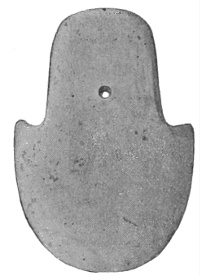
Fig. 109.—Spud.
A celt of argillite, highly polished, from Loudon county, Tennessee, of the pattern shown in figure 64, has a neatly drilled cylindrical hole about a third of the way from the top; but such cases are unusual. The spuds may be divided into three general classes, as follows:
A. Blade circular in outline, including 180 degrees or more, or semielliptical with either axis transverse; sides of stem straight or slightly curved, parallel or slightly tapering to top, which is either straight or slightly rounded; shoulder nearly at right angles to stem, with sharp or rounded corners or sometimes barbed; stem and blade not differing greatly in length. The type of the class, presented in figure 109, is of clay slate, from a mound in Monroe county, Tennessee. The other six specimens in the collection were distributed as shown in the table.
| District. | A | B | C | D | E |
|---|---|---|---|---|---|
| Western North Carolina | 1 | 1 | 1 | ||
| Monroe county, Tennessee | 1 | 1 | |||
| Phillips county, Arkansas | 1 | ||||
| Pulaski county, Arkansas | 1 | ||||
|
KEY: A = Green slate. B = Mica-schist. C = Compact quartzite. D = Clay slate. E = Quartzite. |
|||||
B. Lower part of the blade a half circle or less; top square or slightly rounded; stem rapidly widening, with increasing curve to the blade, making an angle with it; stem and blade nearly the same length. A specimen of green slate, from Mississippi county, Arkansas, is illustrated in figure 110. Another, of compact quartzite, comes from Loudon county, Tennessee.

Fig. 110.—Spud.
C. Handle or stem round; very much longer than the blade, which is semicircular or semielliptical, with square or barbed shoulders. Illustrated in figure 111 (probably of chloritic slate, from Prairie county, Arkansas).
The specimens known as plummets vary considerably in form, size, and degree of finish, indicating diversity of purpose, and different writers have assigned to them various uses. 111
According to Abbott, one of these relics was found at Salem, in a mortar.83 Stevens says, quoting from Schoolcraft, that the Pennacook Indians used sinkers very much like a plummet in shape.84 In Florida very rough plummets with deep grooves are found in the shell mounds, which were no doubt used as sinkers. The Indians of southern California use them as medicine stones to bring rain; the Eskimo use similar stones as sinkers, but have them perforated at the end. The larger objects of this form may have been used as pestles.85 They might be made very efficient in twisting thread, as they revolve for a considerable time when set in motion.

Fig. 111.—Spud.
The general form is ovoid, sometimes quite slender, sometimes almost round; the ends may be either blunt or pointed. They may be grooved near the middle or near either the larger or smaller end. Some have two grooves, some are only partially grooved, while others have the groove extending lengthwise. There are forms that differ somewhat from this description, but such are rare.
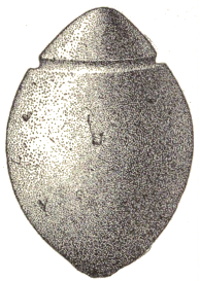
Fig. 112.—Plummet, grooved near one end.

Fig. 113.—Plummet, double-grooved.
Many small and otherwise unworked waterworn pebbles and pieces of steatite pots from southeastern Tennessee and from Montgomery county, North Carolina, have grooves near the middle or near one end; they were probably applied to some of the uses for which plummets were intended.
The plummets in the Bureau collection may be grouped as follows:
A. Grooved near smaller end. The types are illustrated in figure 112 (sandy limestone, from a mound in Catahoula parish, Louisiana), and figure 113 (hematite, double grooved, with notches cut in various places, from a mound in Kanawha valley, West Virginia). Other specimens are, one from Arkansas county, Arkansas, of sandstone, and one each from Brown and Randolph counties, Illinois, both of hematite.
B. Grooved near larger end. A good example, of hematite, is from Kanawha valley, West Virginia, with a second groove partially around the middle. 112
C. Grooved near the middle. The class is represented by a beautiful specimen (figure 114) of hematite, with the groove much polished and irregular, and a deep notch cut in one end, from Ross county, Ohio. Another specimen, from Kanawha valley, West Virginia, is a double conical implement of hematite, elliptical in section with both ends ground off on flatter sides only.
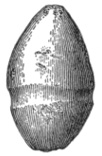
Fig. 114.—Plummet, grooved near middle.
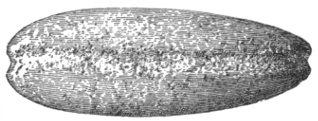
Fig. 115.—Plummet, grooved lengthwise.
D. Grooved lengthwise. This class includes a plummet of quartzite, from Yellowstone park (figure 115), and another of hematite, much shorter than the Yellowstone specimen and with blunt ends, from Kanawha valley, West Virginia.
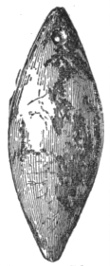
Fig. 116.—Plummet, grooveless, perforated.
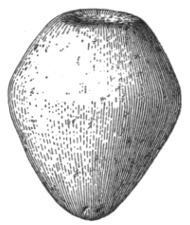
Fig. 117.—Plummet, double cone in shape.
E. Grooveless. A good specimen (figure 116) is of quartz and mica, elliptical in section, pointed at ends with one end perforated, from Yellowstone park; another, from Randolph county, Illinois, of hematite, rough, perhaps unfinished.
F. Double cone, with one end ground off flat and hollowed out. The type (figure 117) is of granite, one of three from Savannah, Georgia.
G. Top flattened and hollowed out; sides incurving to the middle; lower half a hemisphere. The class is represented by figure 118 (quartzite, from Randolph county, Illinois), and figure 119 (sandstone, from Adams county, Ohio). From Kanawha valley there is one of hematite, similar in form to the last.
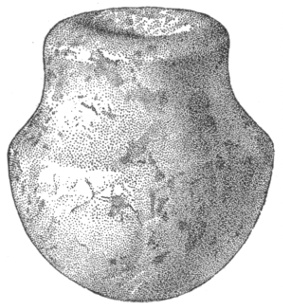
Fig. 118.—Plummet.
H. Ovoid, with the smaller end ground off flat.86 A good specimen of this class (figure 120) is of magnetite, from Caldwell county, North Carolina. From Savannah, Georgia, there are two of sandstone, both smaller than the type and rough; from Kanawha valley there is one of quartzite, nearly half ground away, leaving almost a hemisphere; and from eastern Tennessee there are one of magnetite and one of quartzite, the latter nearly round.
I. Cylindrical. A unique specimen, from a mound in Loudon county, Tennessee, is illustrated in figure 121. It is of sandstone; a short cylinder with incurved sides, each end terminating in a blunt cone. 113
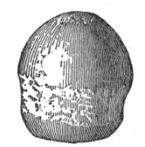
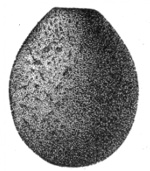
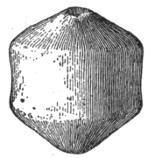
Fig. 119.—Plummet.
Fig. 120.—Plummet, end ground flat.
Fig. 121.—Plummet.
Figure 122 represents a piece of smoothly dressed steatite from Desha county, Arkansas, with a two-thirds round section, the ends rounded, with a groove near one end, which may be classed with the plummets. There are pieces of sandstone from the same locality which connect this pattern with the simpler “boat-form” stones, except that the flat side is ground smooth instead of being hollowed. This is only one of numerous examples where the shapes of implements whose “typical forms” seem utterly dissimilar merge into one another so gradually that no line of demarkation can be drawn.
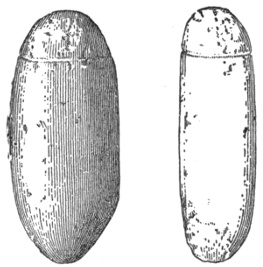
Fig. 122.—Plummet, cylindrical.
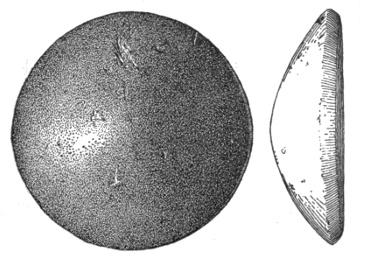
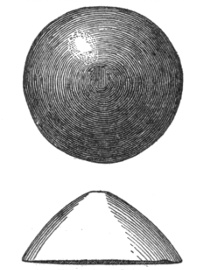
Fig. 123.—Cone.
Fig. 124.—Cone.
The relics known as “cones” have the base flat and the side curving slightly; usually the curve extends regularly over the top, but sometimes the apex is rubbed off flat. The conic surface may form an angle with the base, or the line of junction may be rounded into a curve. They vary considerably in thickness, some being nearly flat, others having a height equal to the diameter of the base. One of steatite from Savannah, as also one of sandstone from Kanawha valley, has a slight pit or depression on the flat side. Among the best examples are 114 one (figure 123) of steatite from Bradley county, Tennessee, and another (figure 124) of hematite from Loudon county, in the same state; one (figure 125) of compact quartzite from a mound in Ogle county, Illinois, and a fourth specimen (figure 126) of granite from Kanawha valley, West Virginia. The distribution is as follows:
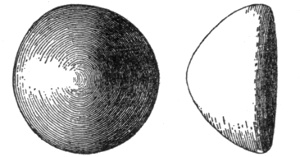
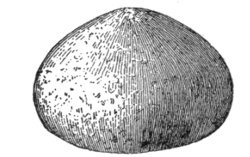
Fig. 125.—Cone.
Fig. 126.—Cone.
| District. | A | B | C | D | E |
|---|---|---|---|---|---|
| Eastern Tennessee | 3 | 4 | |||
| Ogle county, Illinois | 1 | ||||
| Savannah, Georgia | 1 | ||||
| Haywood county, North Carolina | 1 | ||||
| Kanawha valley, West Virginia | 1 | 1 | 1 | ||
|
KEY: A = Steatite. B = Hematite. C = Compact quartzite. 11 D = Granite. E = Sandstone. |
|||||
Hemispheric stones, like the cones, can receive a name only from the form and not from any known or imagined use to which they could have been applied.
All such specimens in the collection, except one, are from Kanawha valley, and of hematite; many if not most of them have been ground down from the nodule, and were probably paint stones originally; at least, the material rubbed from them was used as paint while the maker had their final form in view. One, however, has been pecked into shape and is entirely without polish. In all, the base is flat and varies in outline from almost a circle to a narrow ellipse. A section of the stone parallel to either axis of the base varies from a little more to a little less than a semicircle. Typical forms, both from Bracken county, Kentucky, are illustrated in figure 127.
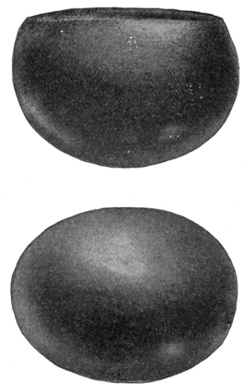
Fig. 127.—Hemispheres.
115The specimen, illustrated in figure 128 (yellow quartz, from a mound in Kanawha valley) is intermediate between cones and hemispheres. The sides are polished, while the flat bottom and rounded top are roughened. As it has faint red stains, it may have been used as a paint-muller.
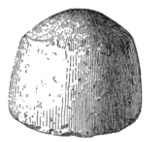
Fig. 128.—Hemisphere.
The articles known as paint stones scarcely come under the head of implements. Some of the hematite pieces are incipient celts, hemispheres, or cones; but most of them were used merely to furnish paint, at any rate until rubbed down quite small. They are of every degree of firmness, some being as brittle as dry clay, others like iron. Most pieces in the collection are from Kanawha valley, but others are from southeastern Tennessee, northeastern Arkansas, and Caldwell county, North Carolina. From the last-named section, as well as from Chester county, South Carolina, and McMinn county, Tennessee, come pieces of graphite more or less rubbed; and one has been sent in from Elmore county, Alabama.
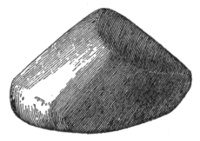
Fig. 129.—Paint stone.
The specimen illustrated in figure 129, from a mound, is a good example of the manner in which the harder hematite was ground.
The so-called “ceremonial stones” are variously subdivided and named by different writers. They are supposed to have been devoted to religious, superstitious, medical, emblematic, or ceremonial purposes; to be badges of authority, insignia of rank, tokens of valorous deeds, or perhaps some sort of heraldic device; in short, the uses to which they might, in their different forms, be assigned, are limited only by the imagination.
According to Nilsson the ancient Scandinavians wore “victory stones” suspended around their necks,87 and the Eskimo wear charms and amulets to bring success in fishing and hunting.88 Adair (1775) says that the American Archi-magus wore a breastplate made of a white conch-shell, with two holes bored in the middle of it, through which he put the ends of an otter-skin strap and fastened a buck-horn button to the outside of each.89 An explanation of the purpose of many of the smaller perforated stones also may be found in Nilsson’s remark90 that the small ovoid or ellipsoid ones were used as buttons; a string being tied to the robe at one end, run through the hole and tied in a knot. 116
The various Indians of Guiana in their leisure hours often fashion highly ornamental weapons and implements which they never use except ceremonially, but keep proudly at home for show.91
So, too, the Yurok and Hupa Indians of California, as well as some of the tribes of Oregon, have very large spearheads or knives, which are not designed for use, but only to be produced on the occasion of a great dance. The larger weapons are wrapped in skin to protect the hand; the smaller ones are glued to a handle. Some are said to be 15 inches long.92 The Oregon Indians believed the possession of a large obsidian knife brought long life and prosperity to the tribe owning it.93
Some of the wild tribes of the interior have something which they regard as the Jews did the Ark of the Covenant. Sometimes it is known; again it is kept secret. The Cheyenne had a bundle of arrows; the Ute a little stone image, and the Osage a similar stone.94 The Kiowa had a carved wooden image, representing a human face; the Ute captured it, and the Kiowa offered very great rewards for its return; but the Ute, believing the Kiowa powerless to harm them so long as it was retained, refused to give it up.95
The North Carolina Indians, when they went to war, carried with them their idol, of which they told incredible stories and asked counsel;96 and as a token of rank or authority, the Virginia Indians suspended on their breasts, by a string of beads about their neck, a square plate of copper.97 These were worn as badges of authority. The native tribes, from our first acquaintance with them, evinced a fondness for insignia of this kind.98
Simply for convenience the ceremonial stones in the Bureau collection will here be divided into two general classes. The first, comprising those pierced through the shortest diameter, will be called gorgets, which name, like that of celt, has no particular meaning, but is in common use. The second class will comprise all others, which will have some name that may or may not be suitable to their form, but by which they are usually called. In this class are included boat-shape stones, banner stones, picks, spool-shape ornaments, and bird-shape stones, as well as engraved tablets or stones.99
The relics commonly called gorgets have been found in Europe; they may be convex on one side, concave on the other, and are supposed to 117 be for bracers.100 It is said that the Miami Indians wore similar plates of stone to protect their wrists from the bowstring.101 Herndon and Gibbon remark that a gold ornament in shape like a gorget, but not pierced, is worn on the forehead by some of the Amazon Indians.102 According to Schoolcraft the so-called gorgets were sometimes used as twine-twisters;103 but Abbott holds that while some may have been twine-twisters, or may have been used for condensing sinews or evening bowstrings (that is, reducing the strings to a uniform diameter), most were simply ornaments, as they are generally found on the breast of a buried body.104 Stevens is even more conservative, holding that they were neither twine-twisters nor devices for condensing sinews or evening bowstrings, as they show no marks of wear in the holes.105
Some writers suppose the gorgets to have been shuttles; but this supposition can hardly be entertained, although it is true, according to Chase, that the Oregon Indians passed thread with a curved bone needle.106 As twine-twisters they would be about as awkward as anything that could be devised. As to evening bowstrings, it would seem that if a string were too large in places to pass through a hole it could not be pulled through; pounding and rolling the wet string with a smooth stone, or some such means, would be the remedy. The bracer theory is plausible; but no one seems ever to have seen a gorget used for this purpose.
Few of the gorgets in the Bureau collection show such marks of wear around the edges of the hole as would be made by a cord; but the majority are thus worn at the middle, where the hole is smallest. Some specimens among every lot are not perforated, or only partially so; the drilling seems to have been the last stage of the work. The hole is almost always drilled from both sides, and the few in which it goes entirely through from one side would probably have had it enlarged later from the other. A number are fragments of larger gorgets, the pieces having been redrilled.
Some of the specimens have various notches and incised lines, the latter being sometimes in tolerably regular order; but there is not the slightest indication that these marks had any meaning or were intended for any other purpose than to add to the ornamental appearance of the stone.
If they were to be worn at the belt or on any part of the dress they could easily have been fastened by a knotted string, or if the wearer desired he could have an ornamental button of some kind. If suspended around the neck, in order to make them lie flat against the breast they probably had a short cord passed through the perforation and tied 118 above the top of the object, the suspending cord being passed through the loop thus formed.
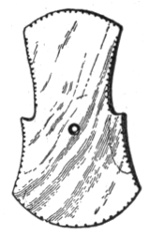
Fig. 130.—Gorget.
The principal division is into group A with one hole and group B with two holes, though in many cases this forms the only difference between two specimens.
A. General outline rectangular, or perhaps slightly elliptical, sometimes with one end somewhat narrower than the other, or with one end rounded off, or with the corners slightly rounded. Perforation commonly near one end. The form is represented by the specimen with two perforations illustrated in figure 133, which otherwise fully answers the description. The argillite specimens have the broader ends striated as though used for rubbing or scraping, but in other respects conform to those of other materials. The materials are generally the softer rocks, as shown in the accompanying table:
| District. | A | B | C | D | E |
|---|---|---|---|---|---|
| Eastern Tennessee | 2 | 3 | 2 | 3 | |
| Wilkes county, North Carolina | 1 | ||||
| Knox county, Ohio | 1 | ||||
| Kanawha valley, West Virginia | 7 | 2 | |||
|
KEY: A = Steatite. B = Slate. C = Sandstone. D = Schist. E = Argillite. |
|||||
A related type is rectangular or with incurved sides (forming either a regular or broken curve) and rounded ends, and differs in having the perforation near the center. The same pattern sometimes has two holes. It is illustrated in figure 130 (striped slate, from a mound in Kanawha valley, West Virginia). There are also from the same place one each of slate, cannel coal, and clay slate, and from eastern Tennessee one each of slate, shale, and clay slate.
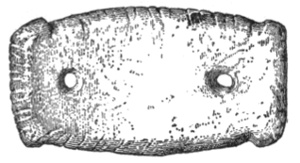
Fig. 131.—Gorget(?).
There are a number of small pebbles, thin and flat, with a hole drilled near the edge, from southeastern Tennessee, North Carolina, and southeastern Arkansas. One of these, from Caldwell county, North Carolina, is of banded slate; the others are of clay slate or sandstone. Two of them have straight and zigzag lines on both faces, and notches around the edge.
Allied to these are a number of pieces of flat stone from southeastern Tennessee, Kanawha valley, and North Carolina, with the faces partially rubbed down smooth, the edges being untouched. They are of slate, talc, or argillite.
From southeastern Tennessee and North Carolina there are several pieces of steatite, which may have been for sinkers. Some have a hole 119 near one end, others a hole at each end, while still others are not perforated. All have been worked over the entire surface, and some of them are well polished. One of these is represented in figure 131.
B. Gorgets with two holes. Of these there are several subdivisions, differing more or less widely in form. They are as follows:
1. Thick, with both the sides and the ends incurved or reel-shape; faces flat or slightly convex. This form is represented by the specimen shown in figure 132, from a mound, Knox county, Ohio. There is another from the same place, a third from Kanawha valley, and a fourth from Butler county, Ohio; all of green slate.
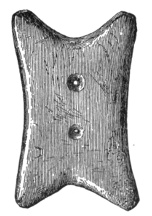
Fig. 132.—Gorget, reel-shape.
2. Rectangular, or with sides or ends, or both, slightly curved, either convex or concave; faces flat. Shown in figure 133 (green slate, from a grave in Kanawha valley, West Virginia).
| District. | A | B | C | D | E | F |
|---|---|---|---|---|---|---|
| Nicholas county, Kentucky, with ends V-shaped | 1 | |||||
| Kanawha valley, West Virginia | 11 | 3 | 3 | |||
| Eastern Tennessee | 6 | 1 | 1 | 1 | ||
| Ogle county, Illinois | 1 | |||||
| Forsyth county, Georgia | 1 | |||||
| Haywood county, N.C. | 1 | |||||
| Davidson county, N.C. | 1 | |||||
| Chautauqua county, N.Y. | 1 | |||||
|
KEY: A = Slate. B = Limestone. C = Sandstone. D = Shale. E = Argillite. F = Fine quartzite. |
||||||

Fig. 133.—Gorget.
3. Widest at middle, with single or double curve from end to end; very thin; both sides flat.
| District. | A | B | C |
|---|---|---|---|
| Kanawha valley, West Virginia | 1 | 4 | |
| Davidson county, North Carolina | 1 | ||
| Savannah, Georgia | 1 | ||
| Eastern Tennessee | 5 | 1 | |
|
KEY: A = Slate. B = Sandstone. C = Schist. |
|||
120
4. Same outline but thicker; one face flat, the other convex. Represented by figure 134 (shale, from Jackson county, Illinois). The distribution of the form is as follows:
| District. | A | B | C | D | E | F | G |
|---|---|---|---|---|---|---|---|
| Eastern Tennessee | 2 | 3 | 1 | 1 | |||
| Haywood county, North Carolina | 1 | 2 | |||||
| Davidson county, North Carolina | 1 | ||||||
| Savannah, Georgia | 2 | 2 | |||||
| Kanawha valley, West Virginia | 1 | ||||||
| Jackson county, Illinois | 1 | ||||||
| Desha county, Arkansas | 1 | 1 | |||||
|
KEY: A = Sandstone. B = Slate. C = Schist. D = Steatite. E = Talc. F = Argillite. G = Shale. |
|||||||
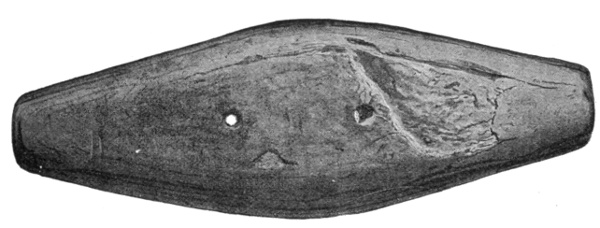
Fig. 134.—Gorget.
5. Same outline, but quite thick, approaching the “boat-shape” stones in form. In some the flat side is slightly hollowed out. A majority of them are not perforated. The type (figure 135) is of sandstone, from a mound at Adelphi, Ohio.
There are also, from Butler county, Ohio, Kanawha valley, West Virginia, and Savannah, Georgia, one each of slate; from Ross county, Ohio, two, and from Kanawha valley, and Cocke county, Tennessee, one each, all of sandstone. There are two (of sandstone and slate) from Kanawha valley, which differ from the others in having the sides parallel, giving them a semicylindrical form.
The pattern of the specimen illustrated in figure 136 (striped slate, from Butler county, Ohio, of which a number have been found in that state), may be classed between the gorgets and the boat-shape stones. The shorter end of the object has, sometimes, a projection or enlargement at the top, apparently for suspension, although no perforated examples have been found.
Under the head of “banner stones” are placed ornaments having the ends at right angles to the perforation. The hole is drilled in a midrib, from which the faces slope by either straight or curved lines to the edges. The two halves of the stone are symmetrical. In most specimens one face is flatter than the other, even plane in some cases. Some specimens are finished to a high 121 polish, before the hole is started; others have the hole completed with the exterior more or less unfinished. The specimens in the Bureau collection may be classified as follows:
A. Rectangular or trapezoidal, with sides and ends sometimes slightly curved inward or outward.
B. Reel-shape.
C. Crescentic.
D. Butterfly pattern.
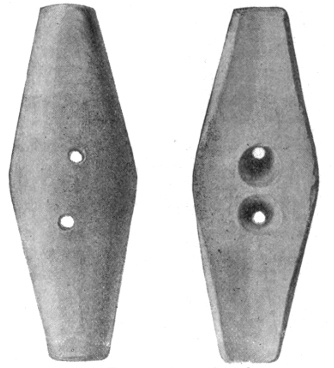

Fig. 135.—Gorget, boat-shape.
Fig. 136.—Gorget resembling boat-shape stone.
The last three varieties may be considered as only modifications of the simple rectangular banner stones. By rounding off the corners of the articles or dressing them to sharp points, by cutting away portions from the sides or by trimming away the central portions at either or both ends of the perforations, all these different forms may be produced.

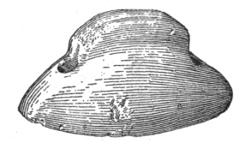
Fig. 137.—Banner stone.
Fig. 138.—Banner stone.
A. A typical specimen is illustrated in figure 137. It is of slate, and was taken from a mound in Kanawha valley, West Virginia. Another good example, shown in figure 138, is of sandy slate, from a grave in Monroe county, Tennessee. The geographic range of this type is wide, though the objects are not abundant. 122
| District. | A | B | C | D | E | F |
|---|---|---|---|---|---|---|
| Montgomery county, North Carolina | 1 | 1 | ||||
| Kanawha valley, West Virginia | 2 | |||||
| Hancock county, Illinois | 1 | |||||
| Savannah, Georgia | 1 | 3 | 1 | 1 | ||
| Eastern Tennessee | 2 | 1 | 1 | 1 | ||
|
KEY: A = Granite. B = Steatite. C = Slate. D = Sandstone. E = Compact quartzite. F = Diorite. |
||||||
B. The reel-shape banner stones are somewhat variable, but are fairly illustrated in figure 139, representing a specimen of argillite from Sevier county, Tennessee.
A related form has the middle cut from one end, leaving two horn-like projections extending parallel with the hole. An example of this form, shown in figure 140, is of banded slate, from a mound in Kanawha valley, West Virginia.
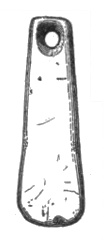
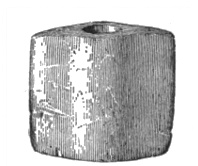
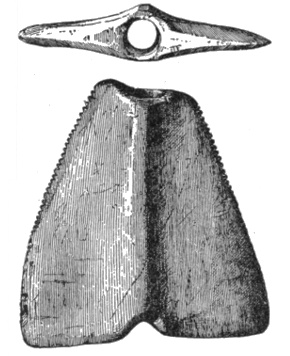
Fig. 139.—Banner stone, reel-shape.
Fig. 140.—Banner stone, with horn-like projections.
Fig. 141.—Banner stone, crescent-shape.
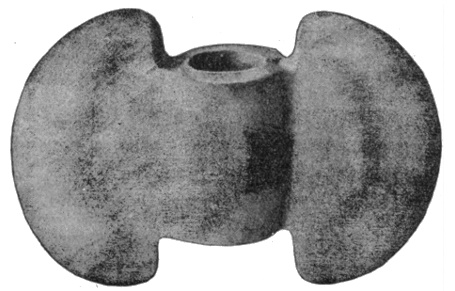
Fig. 142.—Banner stone, crescent-shape
C. The crescentic banner stones might better be termed “semilunar,” since most of them are flat at one end and curved at the other. Occasionally one has both ends curved and parallel, the sides also slightly curved, making the article reniform. Others have the ends straight and parallel, with the sides curved or like the zone of a circle. Two have a midrib for the hole, with the sides dressed down quite thin, as with the butterfly gorgets. All were finished in form before the drilling was done, though some had not received their final polish. The type is illustrated in figures 141 (steatite, from northwestern North Carolina), 142 (pagodite, from Rhea county, Tennessee), and 143 (sandstone, 123 from Jefferson county, Tennessee). The last form is sometimes called a perforated ax, but the material and fragile make exclude it from every class except the ceremonial stones.
| District. | A | B | C | D | E | F |
|---|---|---|---|---|---|---|
| Savannah, Georgia | 1 | 1 | 1 | |||
| Western North Carolina | 2 | 1 | ||||
| Montgomery county, North Carolina | 1 | |||||
| Kanawha valley, West Virginia | 2 | |||||
| Eastern Tennessee | 1 | 2 | ||||
|
KEY: A = Steatite. B = Slate. C = Granite. D = Reddle. E = Pagodite. F = Talc. |
||||||
D. The “butterfly” gorgets are so named from their resemblance to a butterfly with expanded wings. The sides or wings are usually quite thin, either semicircular or like a spherical triangle in outline. The perforated mid-rib is shorter than the wings and carefully worked. A good example, shown in figure 144, is of ferruginous quartz from Monongahela, Pennsylvania, and that illustrated in figure 145 is of banded slate from Kanawha valley. There is also one of the latter material from Lewis county, Kentucky.


Fig. 143.—Banner stone, crescent-shape.
Fig. 144.—Butterfly banner stone.
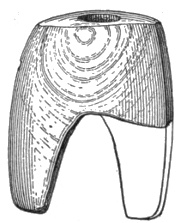

Fig. 145.—Butterfly banner stone.
Fig. 146.—Banner stone.
An aberrant form is elliptical in section at the middle, round or nearly so at the ends, the sides expanding rapidly from end to middle by 124 double curves. It is represented by figure 146 (ferruginous quartz, from Kanawha valley, West Virginia), and by a specimen of quartzite from Union county, Mississippi.
There are two types of relics, perhaps ceremonial, for which no use has been determined, and which are named from their general resemblance to the form of a boat. They are as follows:107
A. With flat face more or less hollowed, sides triangular and parallel. A number are not perforated. The type is shown in figure 147 (striped slate, from Davidson county, North Carolina).
| District. | A | B | C | D | E | F |
|---|---|---|---|---|---|---|
| Davidson county, North Carolina | 1 | |||||
| Southeastern Arkansas | 1 | 2 | 1 | |||
| Savannah, Georgia | 1 | |||||
| Eastern Tennessee | 1 | 1 | 1 | |||
|
KEY: A = Compact quartzite. B = Slate. C = Sandstone. D = Porphyry. E = Barite. F = Steatite. |
||||||
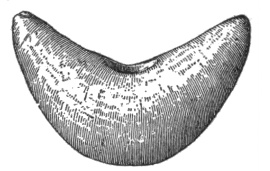
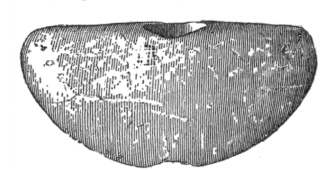
Fig. 147.—Boat-shape stone.
Fig. 148.—Boat-shape stone.
B. Coming to a point at each end; flat side, deeply hollowed; perforations near the ends, with a groove between them in which the suspending cord rested. Some have a flattened projection in which the groove is made. The type (figure 148) is of steatite, from a grave in Sullivan county, Tennessee. The distribution is as follows: 125
| District. | A | B |
|---|---|---|
| Central North Carolina | 3 | |
| Eastern Tennessee | 2 | 1 |
| Savannah, Georgia | 1 | |
|
KEY: A = Steatite. B = Slate. |
||

Fig. 149.—Pendant.

Fig. 150.—Pick.
The relics known as picks from their form and not at all from their function vary considerably in size. Not all are perforated. A good example, shown in figure 150, is of striped slate, from Knox county, Ohio. There are also in the collection, from Union county, Mississippi, one specimen of greenstone; from Jackson county, North Carolina, one of slate, and from Montgomery county, North Carolina, one each of steatite and slate. The last named is the half of a larger one that was broken at the part drilled, and has had a hole drilled near the larger end of this fragment, which has not been reworked.
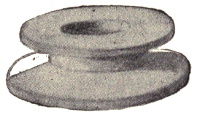
Fig. 151.—Spool-shape ornament.
Relics of spool shape, probably ornamental rather than industrially useful, are not uncommon in copper, though very rare in stone. The specimen shown in figure 151 is of sandstone, from Jackson county, Arkansas. There are also, from Prairie and Lonoke counties, one each of sandstone, and from Jackson county two of the same material; from Clark county there is one of pinkish slate, with the stem drilled between and parallel to the faces, the others with stems drilled lengthwise.
Stone relics of bird form are quite common north of the Ohio river, but are exceedingly rare south of that stream. A good example, shown 126 in figure 152, is of granite, from Vernon county, Wisconsin, and the collection embraces another specimen, of sandstone, from Kanawha valley, West Virginia.
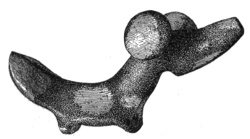
Fig. 152.—Bird-shape stone.
According to Gillman, bird-shape stones were worn on the head by the Indian women, but only after marriage.108 Abbott109 quotes Col. Charles Whittlesey to the effect that they were worn by Indian women to denote pregnancy, and from William Penn that when squaws were ready to marry they wore something on their heads to indicate the fact. Jones110 quotes from De Bry that the conjurers among the Virginia Indians wore a small, black bird above one of their ears as a badge of their office.
The shaft of an arrow is straightened by wetting and immersing it in hot sand and ashes, and bringing into shape by the hand and eye. To reduce the short crooks and knobs it is drawn between two rough grit stones, each of which has a slight groove in it; coarse sand is also used to increase the friction.111
Again, a rock has a groove cut into it as wide as the shaft and two or three times as deep. Into this the crooked part of the shaft is forced, and by heating or steaming becomes flexible and can be easily made straight, which shape it will retain when dry.112
A somewhat different device for the same purpose appears in the Bureau collection. It is illustrated in figure 153 (of fine sandstone); there was another part to correspond with that shown. The specimen is from Monongahela, Pennsylvania.
As the use of stone tubes by the Indians has given rise to considerable discussion, the following references to the various ways in which they have been employed may help to settle it. 127
Schoolcraft observed that the Dakota Indians used a horn tube in bleeding; one end was set over the cut, and the other vigorously sucked.113 Powers says that the Klamath Indians use tubes for smoking,114 while H. H. Bancroft says that the Acaxees of Mexico employ “blowing through a hollow tube” for the cure of disease,115 and also that the Indians of southern California inhale smoke of certain herbs through a tube to produce intoxication.116 According to C. C. Jones the Florida and Virginia Indians used reeds in treating diseases by sucking or blowing through them, and also used them in cauterizing; and he observes that the Indians of Lower California employed similar processes, using stone tubes117 instead of reeds. Hoffman illustrates the removal of disease through the agency of a tube of bone by a Jĕs´sakīd´ or medicine-man of the Ojibwa.118 Read calls attention to the fact that the old Spanish writers describe a forked wooden tube, the prongs being inserted in the nostrils, while the other end was held over smoldering herbs, and suggests that the Indians may have used stone tubes in the same way.119
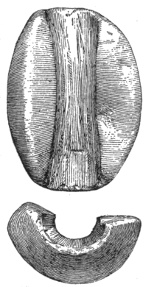
Fig. 153.—Shaft rubber.
The Indian mode of inhaling smoke would produce the same result, whether drawn through the mouth or into the nostrils.
The use of stone tubes for astronomical purposes, which has been discovered by some imaginative writers, is, of course, absurd; nevertheless they are useful in viewing distant objects on a bright day, especially when looking toward the sun.
Nearly all of the tubes made of soft material with tapering perforation seem to have been gouged rather than drilled. Schumacher observes that the California Indians drilled their tubes from both ends and enlarged the hole from one end by scraping, the mouthpiece being made of a bird bone stuck on with asphaltum.120
There are five classes of stone tubes in the collection of the Bureau, as follows:
A. One end flattened and expanding into a wing on either side. This class is illustrated by figure 154 (from Kanawha valley, West Virginia). The corners of this specimen have been trimmed off; the typical form is indicated by the dotted lines. There are also from the 128 same locality one of quartzite, and from Ross county, Ohio, one of sandstone.
B. Conical; the bore more tapering than the exterior. Represented by the specimen shown in figure 155, of sandstone, from a mound in Kanawha valley, West Virginia.
| District. | A | B | C | D |
|---|---|---|---|---|
| Sevier county, Tennessee | 1 | |||
| Savannah, Georgia | 1 | |||
| Western North Carolina | 1 | 1 | ||
| Kanawha valley, West Virginia | 2 | 1 | ||
|
KEY: A = Sandstone. B = Steatite. C = Slate. D = Clay slate. |
||||
C. Hour-glass shape, usually but not always with a narrow ring or projection around the smallest part. Exterior with gently curving outlines; the perforation is usually in the form of a double cone, with the points at the smallest part of the tube, which may or may not be midway between the ends. A good specimen, illustrated in figure 156, is of steatite, from Sevier county, Tennessee.
D. Of nearly uniform diameter inside and out; section circular, elliptical, or flattened on one side. This form is exemplified by figure 157, a specimen from North Carolina. There are also one each from Caldwell, Haywood, and Montgomery counties, North Carolina, all of slate.
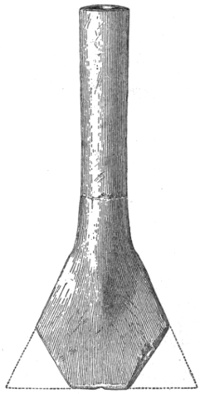
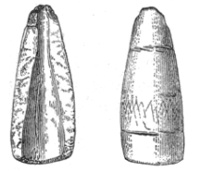
Fig. 154.—Tube, one end flattened.
Fig. 155.—Tube, conical.
E. Round or elliptical in section, ¾ to 2½ inches long; probably beads. The collection includes specimens from Bradley county, Tennessee, of steatite; from Savannah, Georgia, of ferruginous sandstone; and from Union county, Mississippi, of jasper.
So much has been written concerning pipes that few references seem necessary, and none will be given except from Col. R. I. Dodge, who, after an experience of many years among the Plains Indians, says that the latter have different pipes for different occasions, as the medicine 129 pipe, peace pipe, council pipe, and a pipe for common use. Each is sacred to its own purpose.121
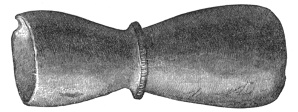
Fig. 156.—Tube, hour-glass form.
In an article so highly prized by its owner, great pains would be expended to give an ornamental appearance to one which would be used on important ceremonial occasions; and it would be carved or worked in a manner gratifying to its maker or the one for whom it was intended. This fact, and the statement quoted above, will explain the great variety in form from a limited area. Still, in some sections of the country there are certain types that prevail, and may be in some cases peculiar to these localities; such, for instance, are the long stemmed pipes from western North Carolina and eastern Tennessee.
In many pipes of soft stone the bowl is gouged out instead of drilled.

Fig. 157.—Tube, cylindrical.
The pipes in the Bureau collection embrace the following classes:
A. Stem with an elliptical or somewhat triangular section; the bowl near one end, leaving a projection in front; stem hole in long end. The form is shown in figure 158. From Caldwell county, North Carolina there are two similar pipes of steatite. Another, from Preston county, West Virginia, differs only in having the stem hole in the short end.
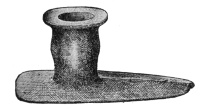
Fig. 158.—Pipe, flat base.
B. Same form of stem; no projection in front, the bottom of the stem curving up gradually into the front of the bowl. This type is represented by figure 159 (of steatite, from a mound in Loudon county, Tennessee). There are also, from Kanawha valley, West Virginia, an example of talcose slate, and from Caldwell county, North Carolina, one of steatite.
C. Stem having a midrib in which the hole is bored. One of steatite, from Caldwell county, North Carolina, has a prow; the others have not. Another of steatite from Loudon county, Tennessee, has a slender projection below the bowl, as if for a handle. The axis of the 130 bowl and that of the stem meet at any angle between 100° and 170°. Figure 160 represents a typical specimen, of steatite, from a mound in Sullivan county, Tennessee. There are also, from Caldwell county, North Carolina, and Kanawha and Preston counties, West Virginia, one each, and from Sullivan county, Tennessee, two, all of steatite; and there is an example from Kanawha valley, West Virginia, of material not identified.
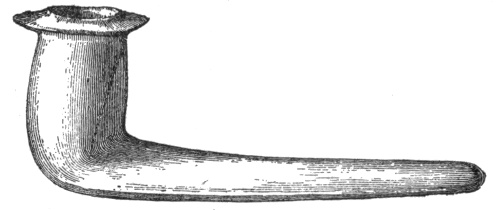
Fig. 159.—Pipe.
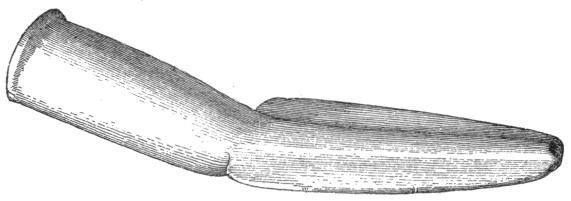
Fig. 160.—Pipe.
D. With bowls and stems either round or square; very large. A good example (figure 161) is of red sandstone, from southeastern Missouri; it is the only pipe in the entire collection of the Bureau on which is shown any attempt at ornamentation. From Jefferson county, Tennessee, and Savannah, Georgia, there are one each, of steatite.

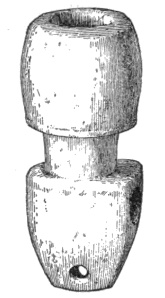
Fig. 161.—Pipe, ornamented.
Fig. 162.—Pipe.
E. Cylindrical bowl, with a square-edged groove around it near the middle, below which the bottom has a somewhat celt like form, with stem hole in one side. A small hole is drilled near the edge at the 131 bottom, probably for the purpose of suspending feathers or other ornaments. The type is represented by figure 162 (of limestone, from Crawford county, Wisconsin). Pipes of the same form are found also in central Ohio.

Fig. 163.—Pipe, long-stemmed.
F. Round stem from one-half inch to 10 inches long; bowl at extreme end, set on at various angles from nearly a right angle to almost a straight line. Good examples are illustrated in figure 163 (steatite, from Caldwell county, North Carolina) and 164 (also of steatite, from a mound in Monroe county, Tennessee). The other specimens in the collection are distributed as shown in the table:
| District. | A | B |
|---|---|---|
| Eastern Tennessee | 4 | 7 |
| Caldwell county, North Carolina | 22 | |
| Chester county, South Carolina | 1 | |
|
KEY: A = Sandstone. B = Steatite. |
||
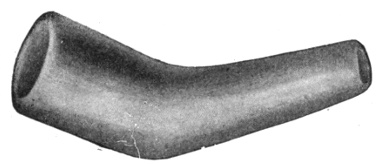
Fig. 164.—Pipe, short-stemmed.
G. Same form of stem, short, with flange around the top of the bowl. Represented by one of sandstone, from a mound in Monroe county, Tennessee (figure 165), and three of sandstone and two of marble from eastern Tennessee.
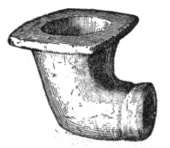
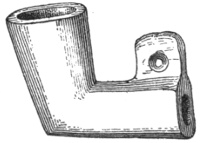
Fig. 165.—Pipe.
Fig. 166.—Pipe.
H. Small, stem more or less squared, bowl upright. There are two examples of this class from Monroe county, Tennessee, each having a flat projection or ridge on top of the stem, which is perforated for attachment of ornaments. The type, represented in figure 132 166, is of clay slate, from Monroe county, Tennessee. It will appear from the following table that the distribution of this form is limited:
| District. | A | B | C |
|---|---|---|---|
| Savannah, Georgia | 1 | ||
| Eastern Tennessee | 1 | 1 | 2 |
| Western North Carolina | 3 | ||
|
KEY: A = Sandstone. B = Clay slate. C = Steatite. |
|||
I. Egg-shape bowl, stem hole in the side. One from Bradley county, Tennessee, of argillaceous limestone, has a hole drilled from end to end, but no stem hole. It may have been made so intentionally, or the drilling may have been carried too far and the specimen left unfinished. The type is of barite, from Sevier county, Tennessee (shown in figure 167). Another specimen, from McMinn county, Tennessee, is of argillaceous limestone.

Fig. 167.—Pipe.
J. Form like last, with a flange around the top of the bowl. A typical specimen, shown in figure 168, is of steatite, from Loudon county, Tennessee. There are, also, from Preston county, West Virginia, one of sandstone, and from Caldwell county, North Carolina, two of steatite.
K. Bowls egg-shape, but quite long and sometimes rather pointed at the bottom; stem hole in the side. This class includes the following: From Savannah, Georgia; Roane county, Tennessee; and Adams county, Ohio, one each of sandstone; from Holt county, Missouri, one of micaceous sandstone; from Kanawha valley, West Virginia, one of indurated red clay, possibly catlinite; and from Caldwell county, North Carolina, three of steatite.

Fig. 168.—Pipe.
The chipped implements in the Bureau collection, are nearly always made of some form of flint or similar chalcedonic rock, as it is easily chipped and can be brought to a keen edge or point. Sometimes quartz, quartzite, argillite, or even a more granular rock is used; but this is infrequent, and is due to the scarcity of the more desirable material. 133
In the spades and hoes first to be considered the flaking seems to have been by percussion mainly, if not entirely; the same method appears to have been employed in obtaining flakes from blocks, to work into the smaller implements. Some of the processes used in making them will be hereinafter described.
It must be admitted that most Indians depended largely on agriculture for subsistence; some historical works that represent them as barbarous hunters, depending entirely on the chase, will, on the same page perhaps, relate how Virginia and New England pioneers were saved from starvation by supplies of corn, beans, and pumpkins obtained from the Indians. This being the case, some method of cultivation was necessary.
It is not to be inferred that “cultivation” implies all that is now meant by the term; the Indian seems merely to have worked the hill in which his corn was planted and not the whole surface of the field, a shallow hole being scooped out in which the grain was dropped, and as the stalk became larger the dirt was heaped up around it. The remains of many “Indian old fields” in various parts of the country show this, there being no long ridges as in cornfields of the present day, but only a great number of these detached hills. The great scarcity of implements suitable for such work argues nothing, for in most parts of the country stone easily worked and adapted to the purpose is unobtainable.
There are a few flint deposits found in southern Illinois in which the material occurs in nodules that can be made with even less work than a piece of wood into suitable implements; and in the country which may be considered as belonging to this archeologic district the flint hoes and spades are tolerably abundant. In other portions of the country, wood, the shoulder blades of large animals, and musselshells perforated for attachment to a handle, were formerly used; the shells are frequently found, but the other materials have long since disappeared.
Early observations on the industries of the aborigines are significant. Thus, according to De Forest, the Connecticut Indians used spades rudely constructed of wood, or of a large shell fastened to a wooden handle;122 and Palmer123 figures a hoe made of horn, 14 by 5 by one-fourth inches, in a wooden handle 5 feet long, which is split and slipped over the smaller end; such, with others of wood and stone, were used among the Utah Indians before iron was introduced. Dawson holds that they were probably prepared in large numbers for the planting time, when the whole tribe mustered to till the fields, and that when the work was over they were gathered and hidden in some safe place until the next 134 season.124 This may have been the case to some extent, but the specimens found in these hiding places seldom have marks of use, and it is more probable that they were the property either of persons living at a distance or of an individual manufacturer in some particular village, being thus concealed for safe-keeping until there was a demand for them or, perhaps, to await a convenient time for transportation. A sedentary tribe would have no more reason for hiding this than any other kind of property.
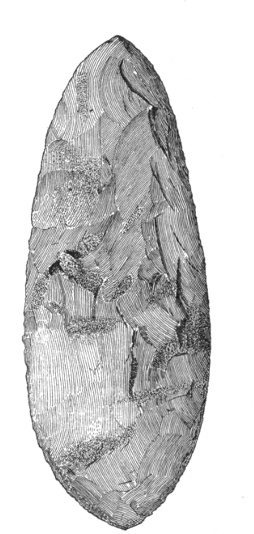
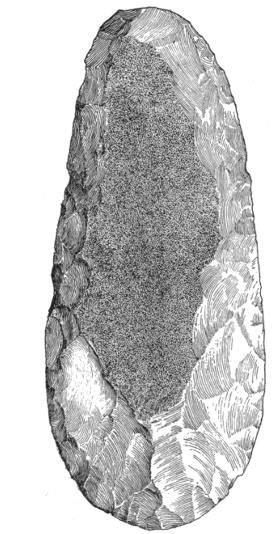
Fig. 169.—Chipped spade with pointed ends.
Fig. 170.—Chipped spade with rounded ends.
The chipped implements known as spades are frequently found buried in large numbers. Two caches were disclosed by high water in 1884, near Caseyville, Kentucky, containing, respectively, 57 and 75 specimens from 6 to 13 inches long.
The most common form is that having an oval or elliptical outline, with the ends either coming to a point or rounded. Long use of those having pointed ends would wear them off until they approached the others in form; but so many of both patterns show no evidence of use 135 that this distinction must be considered intentional. The principal varieties are as follows:
A. Those with pointed ends. Figure 169 represents a typical specimen of yellow flint, from Union county, Illinois.
| District. | A | B |
|---|---|---|
| Southwestern Illinois | 2 | 2 |
| Southeastern Arkansas | 2 | |
| Cheatham county, Tennessee | 1 | |
| Union county, Mississippi | 1 | |
|
KEY: A = Yellow flint. B = Grey flint. |
||
B. Those with the ends rounded. Represented by figure 170 (yellow flint, from Union county, Illinois).
| District. | A | B | C | D |
|---|---|---|---|---|
| Southwestern Illinois | 2 | 2 | ||
| Cheatham county, Tennessee | 1 | |||
| Lauderdale county, Tennessee | 1 | |||
| Polk county, Tennessee | ||||
| Lauderdale county, Alabama | 4 | |||
| Craighead county, Arkansas | 1 | |||
|
A = Yellow flint. B = Grey flint. C = Brown flint. D = Argillite. |
||||
A specimen from Jackson county, Illinois, has had a portion of the edge broken squarely. The polish over this fractured surface shows that it was long used after breaking without being rechipped to a sharp edge. This indicates usage only in loose ground, as it evidently would be quite difficult to force the square, broken part into a hard soil or tough sod.
The specimens from Polk county, Tennessee, are pecked or chipped, or both, and are quite roughly made. They are neither scratched nor polished, and may be unfinished implements of some other class, though agreeing closely with the flint spades in shape and size.
C. A modification of the last form has the upper portion chipped away along the sides until it is ovoid, with a blunt point, leaving the lower part a regular curve. An example, shown in figure 171, is of grayish brown flint, from Scott county, Missouri. There are also one each from Mississippi county, Missouri, and Hopkins county, Kentucky, of the same material.
D. Like the above, but much shorter in ratio to the width, and with a flatter curve. The type, figure 172, is of yellow flint, from a mound in Obion county, Tennessee. There are also three from Union county, Illinois, one of them with almost the same dimensions. 136
E. Semicircular outline, with sides notched for securing the handle, as in arrowpoints and spearheads. Represented by figure 173, showing a specimen of gray flint from a mound in Mississippi county, Arkansas. There are four additional specimens, all from Union county, Illinois.
F. A related form, also notched for attachment of handle. Figure 174 represents an example of yellow flint, from Poinsett county, Arkansas, the only one of this shape in the collection.
From Jackson county, Illinois, there is a series beginning with a small scraper and a small scraper-like celt, and passing gradually into the large spades or digging-tools, there being a number of intermediate forms and sizes. Two specimens, only 6 inches long, have the glazed surface so characteristic of these implements, which could have been produced only by long-continued use in digging.
From a workshop at Mill creek, Union county, Illinois, there are a large number of pieces in every stage of work. Among them can be made series of all the different types here given, from the nodule in its natural state to the completed implement. Near by is a flint deposit showing extensive aboriginal quarrying.
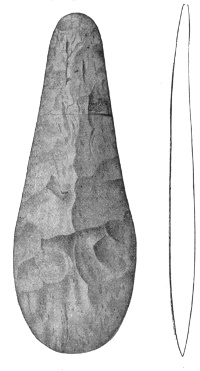
Fig. 171.—Chipped spade, ovoid.
Dawson,125 in speaking of these implements, says: “The rudest of all rude implements, similar to the paleoliths of Europe, were used by the more settled and civilized agricultural nations.” While the majority of them are rude, simply because there was no necessity for elaborate work or fine finish in tools of this class, yet there are many specimens (as, for example, the one shown in figure 171) which in symmetry and workmanship will compare favorably with the larger specimens of other types, due regard being had to the fact that the coarse flint of which they are usually made does not admit of the most delicate execution.
The singular name “turtleback” is suggested instantly on seeing a specimen of the class so designated by Abbott and others. As commonly used, it refers to rude or unfinished leaf-shape implements of any size, which may be found in great abundance almost anywhere. 137 It is used here, however, to denote more especially the disks or almond-shaped pieces of flint or chert sometimes found cached in considerable numbers.
Perkins126 records the discovery of such caches in Vermont; an exceptional case, as they are seldom found outside of the Mississippi valley. The southern portion of Illinois has furnished more than any other section; those found there are almost invariably made from nodules of bluish gray hornstone, the concentric lines being strongly marked.127
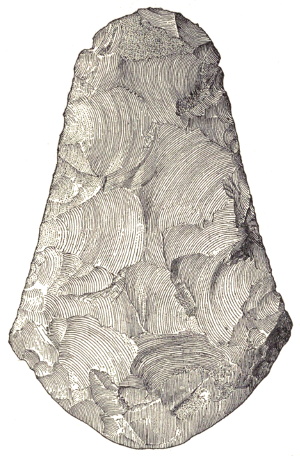
Fig. 172.—Chipped spade.
The Bureau has secured a large number from southern Illinois, ranging from 3½ to 7½ inches in length, some nearly circular, others having a length nearly twice the breadth. All have secondary chipping around the edges. Many of the larger ones and most of the smaller have the edges more or less worn or polished in such manner as would result from use as knives or scrapers. A typical specimen is shown in figure 175. 138
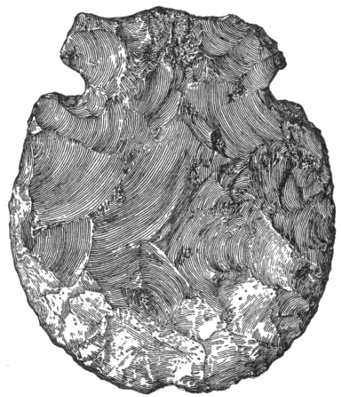
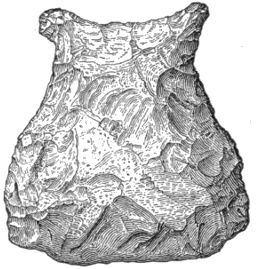
Fig. 173.—Chipped spade, showing handle notches.
Fig. 174.—Chipped spade.
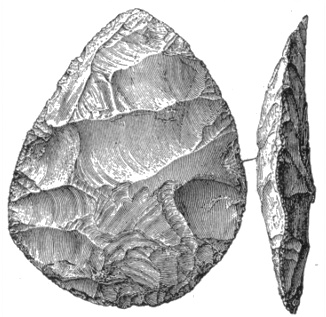
Fig. 175.—Chipped disk, or “turtleback.”
Stevens128 denies in strongest terms that these relics are unfinished implements, saying it is the worst possible form into which flint could be chipped for carrying or for future work. On the other hand, Cheever129 says the Indians of California usually carry a pouch of treasures, consisting of unfinished arrowheads or unworked stones, to be slowly wrought out when they are industriously inclined. Catlin, too, observed that the Apache sometimes carry bowlders of hornstone a long distance to obtain material for arrowheads;130 and according to 139 im Thurn, the various Indian tribes of Guiana have each their special manufacture and exchange with other tribes.131 Tylor says:
Till lately the Patagonians, when they came on their journeys to a place where suitable flint or obsidian was to be found, would load themselves with a supply of lumps to chip into these primitive currier’s scrapers.132
Both Jewitt133 and Evans134 say that stones of this character were used as sling-stones; but there is no evidence that North American Indians ever used slings. Speaking of similar stones, Tylor remarks:
They were used either as knives or scrapers; with the curved side upward (or out) there would be no danger of cutting a hide in skinning game, and they could be used to cut up the flesh; while by putting the pointed end in the handle they could be used as scrapers.135
The smoothed edge in so many specimens substantiates the last statement, while the theory that they are unfinished implements finds support in the fact that nearly all the nodules from which they are made have an ellipsoid form, and the present shape of the implement would result from chipping away the useless weathered surface to lessen the weight.
In the remaining portion of this paper, which will treat of the smaller chipped implements, a plan somewhat different from that of the preceding part will be followed.
As already stated, these specimens are almost invariably made of some form of flint; this term including chalcedony, basanite, jasper, chert, hornstone, and similar rocks. So common is its use that the term “flints” is gradually being adopted as a name for all the different classes of arrowheads, knives, drills, etc. The exceptions are not numerous enough to justify separate classification, so no tables of material will be used. Further, the great abundance of such relics in all portions of the country makes useless any allusion to the number from any particular locality; about the only limitation to their discovery is the amount of time and care which one chooses to give.
Before entering on the description, some quotations may be given in regard to methods of making these chipped implements.
According to Evans, the Mexican Indians take a piece of obsidian in the left hand and press it firmly against the point of a small goathorn held in the right, and by moving it gently in different directions they chip off small flakes until the arrow is complete;136 they also 140 cut a notch in the end of a bone, into which the edge of the flake is inserted and a chip broken off by a sideways blow.137 According to the same author, the Eskimo sometimes set the flake in a piece of split wood. The arrow is roughly chipped by blows with a hammer, either direct or with a punch interposed, and is then finished by pressing off fine chips with a point of antler set in an ivory handle.138 Not only leaf-shape barbed arrows, but also ones either with or without the stem, can be produced by pressure with a point of antler; the former, however, are the more easily made, and were probably earlier in use.139
The Plains Indians lay the flat side of a flake of obsidian on a blanket, or other yielding substance, and with a knife nick off the edges rapidly. In their primitive state they probably used buckskin instead of the blankets, and pointed bone or horn instead of the knife.140
The Apache holds the flake or flint in his left hand, places his punch at the point where the chip is to be broken off, and it is struck by an assistant, thus knocking a chip from the under side; the flake is then turned and the process repeated, until the arrow is complete. The stone is held in the hand, as it can not be chipped on a hard substance.141 A punch observed by Catlin in use by these Indians was a whale tooth 6 or 7 inches long, with one round and two flat sides. The Fuegians, according to the same authority, use a similar process and make as fine implements.142
The Eskimo make a spoon-shaped cavity in a log, lay the flake over it, and press along the margin, first on one side and then on the other, like setting a saw, until they form two sharp serrated edges. The working tool is a point of antler firmly bound into a piece of ivory. The same plan is used by widely separated peoples.143
Nilsson, in chipping out gun flints with a stone hammer, found it necessary to have the point operated on lie immediately above a point that rested on the rock “anvil” which he used.144
The Veeard or Wiyot of California used a pair of buck-horn pincers tied together with a thong at the point; they first hammered out the arrowhead in the rough, and then with these pincers carefully nipped off one tiny fragment after another.145 The Klamath cover the hand with a piece of buckskin to keep it from being cut, and lay a flake along the ball of the thumb, holding it firmly with the fingers. With a point of antler from 4 to 6 inches long, they press against the edge, thus removing scales from the opposite side; they turn the flake around and over frequently, to preserve symmetry.146 141
The Shasta Indian lays a stone anvil on his knee, holds the edge of the flake against it, and with his stone hammer chips off flakes, finishing the base first, and gently chipping the whole arrow into shape. Both obsidian and glass are used.147 The Shoshoni Indians used the same process.148
A Pit River Indian has been seen to make a very sharp and piercing arrow from a piece of quartz, with only a piece of round bone, one end of which was hemispherical with a small crease in it (as if made by a thread) one-sixteenth of an inch deep. The arrow was made by pressing off flakes by main strength, the crease being to prevent the bone from slipping, and affording no leverage.149 John Smith (1607) says of the Powhatan Indian:
His arrowhead he maketh quickly, with a little bone, of any splint of stone or glass.150
The Cloud River Indian used two deer prongs, one much smaller than the other, the points ground to the form of a square, sharp-pointed file. He had also some pieces of iron wire tied to sticks and ground in the same manner; these were better than the deer horn, because harder, and not needing to be sharpened so often. The flake was held firmly in the left hand, guarded by a piece of buckskin; he pressed off chips with the larger tool, turning the arrow end-for-end when done on one side, so as to keep the edge opposite the middle line. The notches for barbs were worked out in a similar manner with the smaller tool.151
Some of the California Indians prefer agate and obsidian for their implements, as the close grain admits more careful working. They use a tool with its working edge shaped like a glazier’s diamond (apparently a piece of bone or antler with a square-cut notch on the side); the flake is held in the left hand, while the nick in the side of the tool is used to chip small fragments.152 Peale makes similar statements, and adds that the notches are of different sizes to suit the different stages of work.153
The Klamath Indians, according to Schumacher, have a slender stick 1½ feet long, with a piece of sea-lion tooth, or antler, fastened to the end of it. Holding one end under the arm to steady it, they take a flake in the left hand, wrapped in a piece of buckskin so as to leave only the edge exposed, and by pressure with the point of the tool break off flakes as large as necessary, the last being quite fine, to give sharp edges to the arrow. The notches are worked out by means of a point of bone 4 or 5 inches long, without a shaft.154 Chase gives a similar account, but says that iron points have now taken the place of the bone or horn points formerly used.155 142
It may not be out of place in this connection to give a few quotations in regard to the length of time required for making an arrowhead.
According to the Marquis de Nadaillac, the Mexicans could turn out a hundred flint knives (probably only unworked obsidian flakes) an hour,156 while Crook says that the Plains Indians with only a knife for nicking off the edges, will make from fifty to one hundred arrows in the same period.157 Chase found that a Klamath Indian required five minutes to complete a perfect arrowhead;158 though Stevens observes that a Shasta Indian spent an hour in chipping one from a flake of obsidian,159 and Lubbock states that the most skillful Indian workmen can not hope to complete more than a single arrow in a day’s hard work.160 Powers also speaks of the aborigines of California as "using that infinite patience which is characteristic of the Indian, spending days, perhaps weeks, upon a single piece;161 and Tylor notes “that utter disregard of time that lets the Indian spend a month in making an arrow.”162
The last two references are probably to the large and finely worked pieces used for ceremonial or ornamental purposes.
The only practicable division of the greater part of the smaller flints is into stemmed and stemless, the former having a prolongation at the base for firmer attachment to a shaft or handle, the latter being of a triangular or oval shape. The stemmed implements may be barbed or not, and the stem either narrower or broader toward the end.
The name “arrowhead” so commonly applied, fits only the minority of specimens, as none but the smaller ones could be so used; the larger are too heavy. The longest stone arrowpoint in the extensive collection of arrows in the National Museum measures two and five-eighths inches in length and is narrow and thin. An arrowpoint two inches in length is seldom seen. The larger specimens were probably knives and spearheads; but it would be difficult to assign any certain use for a particular type, the markings on so many indicate usage for which their shape would seem to render them unsuitable. It is probable that a single specimen served a variety of purposes.
Wood, bone, and shell were also used to a considerable extent, in the manufacture of implements for which flint would seem much better adapted. Thus for fish spears the southern Indians used canes, sharp-pointed, barbed, and hardened in the fire,163 while knives were formerly made of flint or cane; these are still used when the hunting knife has 143 been lost.164 The California Indians had arrows tipped with hard-pointed wood for common use, and with agate or obsidian for war.165
The accompanying diagram (figure 176) will render plain the different terms used in the following descriptions:
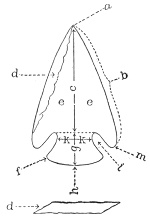
Fig. 176—Diagram, explaining terms. |
|
The only difference between barb and shoulder is that the barb is prolonged toward the base. The shoulder is called squared or rounded according to whether the edge of the implement makes an angle or a curve where drawn in to form the stem.
In the stemless specimens the base is the end opposite the point.
A tapering stem means one narrowing toward the base; straight, one whose sides are parallel; and expanding, one which is widest at the base.
The stemless flints are triangular or oval in outline. For convenience they will be divided into those small enough for arrowpoints (not above 2½ inches long) and those which are too large for such purpose. The latter reach to the length of 7½ inches. They are chipped to a sharp edge all around. The ratio of width to length varies from 1:4 to 4:5.
These objects were mostly for use as knives, scrapers or spearheads. Some of the thicker ones were spikes for clubs. Abbott167 mentions three triangular jasper implements 3 to 4 inches long from graves, associated with fragments of large bones which showed plainly that they had been used for clubs, and the Iroquois are known to have used a club with a sharp-pointed deer-horn about four inches long inserted in the lower side. Schoolcraft168 illustrates a pointed stone with a square 144 section (apparently of the class usually called “picks”), mounted in a club which is curved at the end to let the spike set in the end at a right angle to the handle; and Brickell observes that the North Carolina Indians used clubs or long poles, in the ends of which were fastened artificially sharpened stones, or horns of animals.169 Morgan also notes that among the Iroquois rows of arrow-shaped chert heads about two feet in extent have been found lying side by side. They were set in a frame and fastened with thongs, forming a species of sword.170 According to Tylor the Mexicans had a similar sword, with obsidian teeth gummed in holes in a war club,171 and Bourke observed at Taos pueblo a similar weapon with iron teeth.172 But the number of specimens found mounted indicates that most of them were used as knives or scrapers.
A. With base and edges straight or slightly convex; corners square. The type illustrated in figure 177 is from Montgomery county, North Carolina. Similar forms come also from eastern Tennessee; central and western North Carolina; southwestern Illinois; Miami and Scioto valleys, and central Ohio; southwestern Wisconsin; northeastern and southwestern Arkansas; northeastern and northwestern Alabama, and Coosa valley in the same state; Kanawha valley, West Virginia; northeastern and central Kentucky; and Savannah, Georgia.
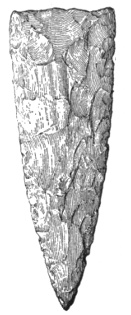
Fig. 177.—Triangular chipped flint.
B. Base straight or nearly so; edges parallel most of the length, curving abruptly to a point; usually with one face less convex than the other, even quite flat, giving a plano-convex section; medium size. The specimen shown in figure 178, from Kanawha valley, West Virginia, is representative. Other examples come from eastern Tennessee; central North Carolina; northwestern Alabama; Kanawha valley; and southwestern Illinois.
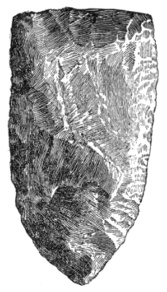
Fig. 178.—Chipped flint.
C. Base straight or nearly so; corners square or slightly rounded; edges convex, curving gradually and regularly to the point; usually widest about one-third of the way above the base; varying much in width, and in length from 6½ inches down to the arrowpoint. A few of the largest have the edges slightly expanding at their junction with the base, for firmer attachment to a handle. The type is 145 figure 179 (from Loudon county, Tennessee). Other specimens are from eastern Tennessee; central and western North Carolina; Kanawha valley; Keokuk, Iowa; Miami and Scioto valleys, and central Ohio; eastern, southern, and southwestern Wisconsin; northeastern Arkansas; central and northeastern Kentucky; northwestern Georgia, and Savannah; southwestern Illinois; and Coosa valley, Alabama.
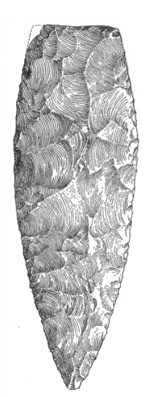
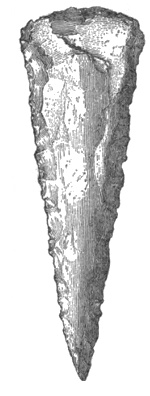
Fig. 179.—Chipped flint.
Fig. 180.—Chipped flint, somewhat bell-shape.
D. Narrow and thick; up to 6 inches long; convex base; edges straight to the base, where they expand somewhat, giving the implement a bell shape. The largest specimen in the lot (figure 180) has both faces polished almost the entire length, a feature absent from all the others. This example is from Caldwell county, North Carolina. The form is found also in central and western North Carolina, eastern Tennessee, northeastern Kentucky; Kanawha valley; and northeastern Arkansas. Few of the flints occur in the collection except from the two localities first mentioned, where they are moderately abundant.
E. Elliptical outline; some very thin, others resembling celts. One from Kanawha valley has the projecting facets and ridges on one face very smooth from use, those on the other being still sharp, as when first chipped. The one figured has the edge worn smooth entirely around, seemingly from use as a cutting tool, the ends being most worn. Represented by figure 181 (from Dane county, Wisconsin). Found also in southern and southwestern Wisconsin; eastern Tennessee; northeastern Arkansas; central and western North Carolina; Brown county, Illinois; Kanawha valley; and South Carolina.
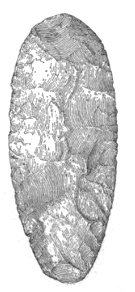
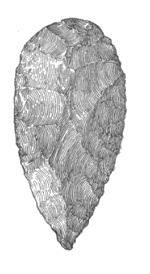
Fig. 181.—Chipped flint, elliptical outline.
Fig. 182.—Chipped flint, leaf-shape or oval outline.
F. With the outline a continuous curve from the point entirely around, the base being regularly rounded. This is the model of the pointed oval or leaf-shape flint. Sometimes one face is flatter than the other, being less worked, or in a few cases the unaltered flat side of a flake. Usually they are quite symmetrical, but occasionally one edge is more curved 146 than the other. The type illustrated in figure 182 is from Vernon county, Wisconsin. Other specimens are from western and central Wisconsin; eastern Tennessee; Miami and Scioto valleys, and central Ohio; southwestern Illinois; Kanawha valley; northeastern Kentucky; northeastern and southwestern Arkansas; northwestern and northeastern Georgia, and Savannah.
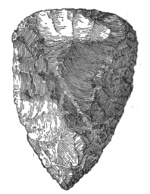
Fig. 183.—Chipped flint.
G. With convex edges and slightly convex base; being a medium between the triangular and the leaf-shape. Some are quite narrow and thick, others wide and thin; the former probably clubs or spearheads, the latter knives. A good example, shown in figure 183, is from Savannah, Georgia. Others are from central Arkansas; central Ohio; eastern Tennessee; Kanawha valley; central North Carolina; southern Wisconsin; northwestern Georgia, and Savannah; northeastern Alabama; and South Carolina.
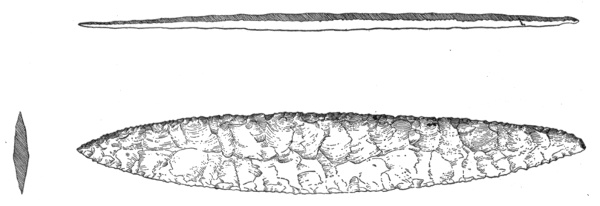
Fig. 184.—Chipped flint, large, pointed elliptical outline.
H. Pointed at each end; mostly elliptical, though sometimes widest near one end; from 5 to 12 inches long. Nearly all are thin and finely worked, with sharp edges. One from Cheatham county, Tennessee, has a deep notch on each edge about one-third of the way from one end, this end being somewhat rounded. The type (figure 184) is from Lonoke county, Arkansas. Other specimens are from central Arkansas, southwestern Illinois, northern and eastern Tennessee.

Fig. 185.—Chipped flint, large, long sharp point.
I. A similar pattern, but having one end continued into a narrow point, shown in figure 185, is from Bartow county, Georgia. Another of the same kind comes from Loudon county, Tennessee.
J. Similar to group H, but with the edges straight for more than half the length, probably to afford a more convenient hold for the hand. 147 The form is shown in figure 186, representing a specimen from Mississippi county, Arkansas. Others are from northwestern Georgia, southwestern Illinois, and northeastern Arkansas. There are a few similar in method of chipping to those of group I, but smaller and very narrow, from eastern and western Tennessee and northeastern Arkansas.
K. Double-pointed or lenticular in outline; quite symmetrical; from 2 to 4 inches long; thin and well worked. Represented in northeastern Arkansas; South Carolina; central and western North Carolina; eastern Tennessee; Scioto valley, and central Ohio; Kanawha valley; and northwestern Georgia.

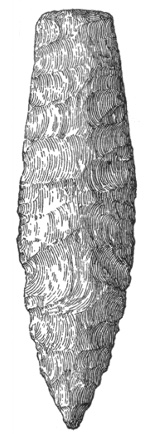
Fig. 186.—Chipped flint, large.
Fig. 187.—Chipped flint.
L. With straight or concave base; edges diverging by straight or slightly convex lines for about half the length from the base, then curving to the point. There is considerable variation in the relative width of these, as well as the amount of concavity at the base. None with this outline of the edges has a convex base. From 2 to 6 inches long. The form is illustrated by figures 187 (from Lawrence county, Ohio), and 188 (from Blount county, Tennessee). In addition to the specimens figured, there is material in the collection from Scioto valley, Ohio; central and western North Carolina; Keokuk, Iowa; Brown county, Illinois; eastern Tennessee; northeastern Alabama, and Coosa valley in the same state; Kanawha valley; South Carolina; southern Wisconsin; and Savannah, Georgia.
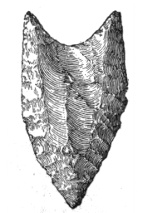
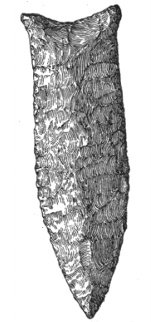
Fig. 188.—Chipped flint.
Fig. 189.—Chipped flint, with shoulders.
M. A modification of the last form in which the edge expands just at the base, forming a point at each corner or shoulder. Illustrated in figure 189. The specimen figured is from Forsyth county, Georgia. Others are from northwestern Georgia, and Savannah; eastern Tennessee; northeastern Kentucky; southwestern Wisconsin; and Kanawha valley.
Small triangular or oval arrowpoints, differing from those previously described in being too small for any similar uses, few of them 148 being so much as two inches in length, and varying from that size to not more than half an inch. Nearly all are very thin, though some of the narrower ones may have a diamond or thick lenticular section. Some are very slender, so much so that they are usually classed as perforators; others are equilateral. Both the base and edges may be straight, convex, or concave. A few have a shallow notch in each edge just above the corner; nearly all, however, have both base and edge continuous.

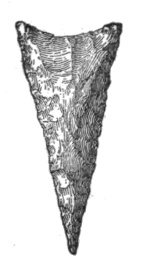
Fig. 190.—Chipped flint, small.
Fig. 191.—Chipped flint, triangular.
The groups and subdivisions which have been recognized among the smaller chipped flint objects in the Bureau collection may be enumerated as follows:
A. Concave base. The concavity may vary from almost a straight line to one-third the length of the flint. Usually symmetric, as in figures 190 and 191, though sometimes one tang or barb, if it may be called such, is longer than the other, as in figure 192. A very few have beveled or serrated edges.
1. Convex edges. The type, shown in figure 190, is from Jefferson county, Tennessee. Other specimens are from eastern Tennessee; Union county, Mississippi; northwestern Georgia, and Bibb county and Savannah in the same state; central and western North Carolina; Miami and Scioto valleys and central Ohio; Kanawha valley, West Virginia; South Carolina; and southwestern Arkansas.


Fig. 192.—Chipped flint, asymmetric.
Fig. 193.—Chipped flint, concave edges.
2. Straight edges, as in the specimen illustrated in figure 191, from Ouachita county, Arkansas. Similar specimens are found in northeastern and southwestern Arkansas; western and central North Carolina; Kanawha valley; eastern Wisconsin; northwestern Georgia, and Savannah; eastern Tennessee; South Carolina; southwestern Illinois; Union county, Mississippi; and northeastern Kentucky.
3. Concave edges. This abundant form is illustrated in figures 192 (Cherokee county, Georgia), 193 (Caldwell county, North Carolina), and 194 (Washington county, Virginia). Other specimens are from northwestern Georgia and Savannah; central and western North Carolina; Kanawha valley; eastern Tennessee; northeastern Kentucky; southwestern Arkansas; South Carolina; Union county, Mississippi; and Coosa valley, Alabama. This subdivision of group A is abundant, as well as widely distributed.
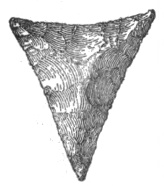
Fig. 194.—Chipped flint, triangular.
149
B. With straight bases. These are all small, the broad ones being short and the long ones slender. Most of them are both short and narrow.
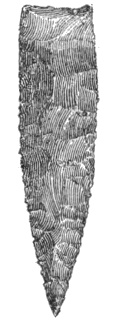
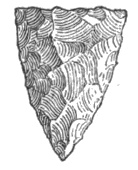
Fig. 195.—Chipped flint, small.
Fig. 196.—Chipped flint, short, convex edges.
1. Convex edges as in figures 195 (McMinn county, Tennessee) and 196 (Bradley county, Tennessee). The form is widely distributed, being represented by specimens from eastern Tennessee; northeastern, southwestern, and southeastern Arkansas; Scioto valley, Ohio; northeastern Kentucky; northwestern Georgia and Savannah; Kanawha valley; Union county, Mississippi; Holt county, Missouri; northeastern Alabama, and Coosa valley in the same state; southern and southwestern Wisconsin; and western North Carolina.
2. Straight edges. Exemplified by the specimen shown in figure 197, from McMinn county, Tennessee. Found also in eastern Tennessee; northeastern Arkansas; Coosa valley, Alabama; Union county, Mississippi; Kanawha valley; Miami and Scioto valleys, Ohio; eastern, southern, and southwestern Wisconsin; western and central North Carolina; Bartow county and Savannah, Georgia; South Carolina, and northeastern Kentucky.
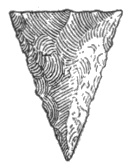
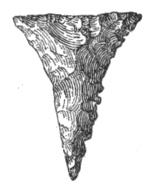
Fig. 197.—Chipped flint, triangular.
Fig. 198.—Chipped flint, concave edges.
3. Concave edges, as in figure 198 (from Bledsoe county, Tennessee). Other examples of this class are from eastern Tennessee; Scioto valley, Ohio; northeastern and southwestern Arkansas; Kanawha valley, West Virginia; northeastern Kentucky; western and central North Carolina; northeastern Alabama; southwestern Illinois; and Savannah, Georgia.
C. Convex bases. Less abundant than the preceding, and the forms representing it are less variable. Its sub-groups are as follows:
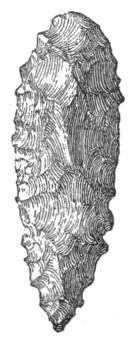
Fig. 199.—Chipped flint, convex base.
1. Convex edges. Some of these have a slight reverse curve at the base, giving a slight barb or shoulder. A few are widest at or near the middle, with bases somewhat pointed, but most of them are widest at the junction of the base and edges. They are mostly of the leaf-shaped type, but quite small. Figure 199 (Mississippi county, Arkansas) is a good example. Others are from northeastern and southwestern Arkansas; northeastern Alabama and Coosa valley; Kanawha valley, West Virginia; eastern Tennessee; western and central North Carolina; northwestern Georgia; eastern Wisconsin; southwestern Illinois, and Miami valley, Ohio. 150
2. Edges concave or nearly straight. There are very few of this form, as nearly all with the base convex have the edges also convex. The type (figure 200) is from Lawrence county, Ohio; others are from Miami and Scioto valleys, Ohio; Kanawha valley; and southeastern and southwestern Arkansas.
Two exceptional forms, which may be considered modifications of the triangular, come from eastern Tennessee and western North Carolina. The first, which is pentagonal, is shown in figure 201; the second, a medium between a perforator and a deeply serrated, triangular arrowpoint, is shown in figure 202.
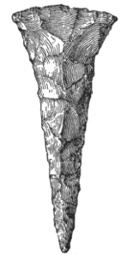
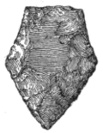
Fig. 200.—Chipped flint, edges concave.
Fig. 201.—Chipped flint, pentagonal.
While it is likely that the smaller flints, last described, were intended for arrows, it can not be stated with confidence whether they were for use in war or in hunting. It is said that some of the western Indians used barbless arrows with, long, tapering blades, firmly attached to the shaft, for hunting, while for war barbed arrows, only slightly attached, were employed.173
In many arrows with triangular points in the National Museum the sinew with which the flint is fastened to the shaft is brought over the corner or shoulder in such a way as to bind the point as firmly as could be done if it were barbed or stemmed, so that when the shaft is drawn from a wound the point must come with it. If an arrowhead of this form were inserted in a shaft, which was then wrapped behind the flint, the latter would remain in the wound when the shaft was withdrawn.

Fig. 202.—Chipped flint, narrow and thick.
There is no reason for supposing that only the larger points were used for war purposes; the greater penetrating power of the thin, sharp ones would seem to fit them especially for such work, and it is probable that the smaller straight or tapering-stemmed flints (next to be described) were also utilized for this purpose, as they could be easily detached. Those with expanding stem may have been used for hunting, as they could be permanently fastened to the shaft.
The abundant and variable material of this class may roughly be grouped by form into two divisions, in the first of which the stem is tapering or straight, while in the second the stem is generally expanding.
A. Square or rounded shoulders; stem concave at base; edges usually convex, rarely straight or concave. Nearly all are of quartzite or coarse 151 flint, roughly worked, the one illustrated (figure 203) being above the average, and are mostly from western North Carolina and the adjacent portions of South Carolina and Tennessee. All of them exceed three inches in length. Those from Savannah, Georgia, are usually much wider relative to the length than the specimens in the Bureau collection from other localities.
The specimen figured is from Montgomery county, North Carolina; others are from western and central North Carolina; Kanawha valley; eastern Tennessee; South Carolina; Coosa valley, Alabama; and northwestern Georgia and Savannah.
B. Similar to the last, except that the base is straight or convex, instead of concave. Large size, and nearly all of rough finish; mostly of argillite or flint, a few of quartzite. Varying considerably in width, as well as in thickness, some having almost a diamond section, others wide and thin, the latter generally having the edges worked quite sharp. Some are made from a large flake which has been dressed on one side only. One from Montgomery county, North Carolina, has the end opposite the stem worked round and sharp, similar to the blunt arrowheads, but its size excludes it from this class. From Savannah there are several which are chipped very thin, and smoothly finished, but they are exceptional; some from this locality are very large, reaching 5 by 3 inches, while others are almost as wide as they are long.
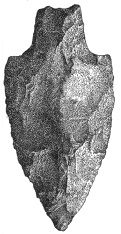
Fig. 203.—Chipped flint stemmed, barbless.
The specimens of this form are chiefly from western and central North Carolina; eastern Tennessee; South Carolina; southwestern Georgia, and Savannah; eastern Wisconsin; southwestern Arkansas; southwestern Illinois; northwestern Alabama and Coosa valley in the same state; Kanawha valley, West Virginia; and central Ohio.
C. Of the same general form as the last, but much smaller, and finely worked. Most seem to be intended for arrowheads. The specimen illustrated in figure 204 is from Caldwell county, North Carolina; others are from South Carolina; western and central North Carolina; Union county, Mississippi; eastern Tennessee; Coosa valley and Tuscaloosa, Alabama; Miami valley, Ohio; Kanawha valley; northwestern and southwestern Georgia and Savannah; and southeastern Arkansas.

Fig. 204.—Chipped flint, stemmed, barbless.
D. Convex edges; stem usually tapering with straight base, though it is noticeable that some are straight with convex base. Resembling the last in form, but slender; from 1¾ to 4¼ inches long. From western 152 and central North Carolina; Kanawha valley, West Virginia; and Savannah, Georgia.
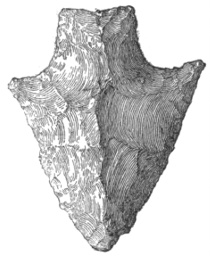
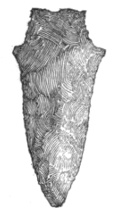
Fig. 205.—Chipped flint, expanding shoulder.
Fig. 206.—Chipped flint, double-curved edges.
E. Differing from specimen shown in figure 203, in having the edges expand at the shoulders in a projection or point, and varying more in size, some being small enough for arrowheads. All from Savannah (including the example shown in figure 205) are of smoother finish than those from other sections, and are usually larger, ranging from 2½ to 4½ inches long. There are some from this locality with base straight or convex. Found also in western and central North Carolina; Kanawha valley; South Carolina; eastern Tennessee; Coosa valley and northeastern Alabama; Brown county, Illinois; northeastern, southeastern, and southwestern Arkansas; and southwestern Georgia.
F. Edge having a double curve, being convex toward the point, and curving outward at the shoulders. Few of them are barbed, though many have the shoulder much expanded. Base sometimes convex or concave, but more often straight; in a few it is somewhat pointed. In most of the smaller specimens the base is notched, but of these none are over 2½ inches long. Stem tapering or expanding, rarely straight. A few have the base rubbed smooth and dull, or even polished (this feature appears in other forms, as noted); it seems to result from use as a knife or scraper, but the implement as a whole does not appear to be adapted to such use. None of them are over 3½ inches long, except a few from Savannah; all from there are wide, but from other places the longer ones are all narrow.
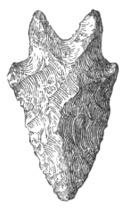
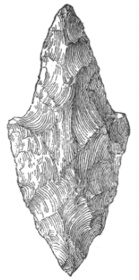
Fig. 207.—Chipped flint, double-curved edges.
Fig. 208.—Chipped flint, convex edges, long, tapering stem.
The specimens illustrated (figures 206 and 207) are from Madison county, Alabama, and Kanawha valley, respectively. Others are from northeastern Alabama and Coosa valley; eastern Tennessee; northwestern and southwestern Georgia and Savannah; Kanawha valley; Catahoula parish, Louisiana; western and central North Carolina; southwestern Illinois and Brown county in the same state; South Carolina; southwestern Arkansas; and Miami valley, Ohio.
G. Convex edges; sharp points; stem always long and tapering; base somewhat pointed, or outline of whole stem forming a regular 153 curve. Some slightly barbed, but mostly with only a small shoulder. The specimens vary much in size, and also in delicacy of workmanship. Classed by function the group would probably be divided among several. The example shown in figure 208 is from Jackson county, Illinois. Others come from southwestern Illinois; eastern Tennessee; South Carolina; Kanawha valley; northeastern, southeastern, and southwestern Arkansas; western and central Arkansas; and southern Wisconsin.
H. Similar to group G, save that the edges are straight while the stem is somewhat shorter. All the specimens are small. Found in western North Carolina; Kanawha valley, West Virginia; South Carolina; and southeastern Arkansas.
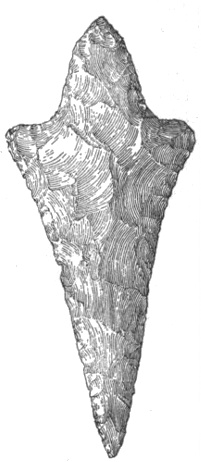
Fig. 209.—Chipped flint with long, tapering stem.
I. Differing from group G in having concave sides; none are barbed, and some have very wide shoulders. Nearly all are large. Two from Savannah have the base straight, all the others being of the common type. The type (fairly exemplified in figure 209) is from Union county, Illinois, and others come from southwestern Illinois; southwestern Arkansas; South Carolina; western North Carolina; Kanawha valley, West Virginia; eastern Tennessee; and Savannah, Georgia.
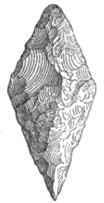
Fig. 210.—Stemmed chipped flint, diamond or lozenge shape.
J. Lozenge or diamond shape; the four edges straight or nearly so, varying a little toward convexity or concavity. In some the base does not come to a point but is rounded or truncated; sometimes, though seldom, there is a slight shoulder. From 1¼ to 3½ inches long. A typical example, shown in figure 210, is from Chester county, South Carolina. Additional material is from South Carolina; Kanawha valley; Brown and Ogle counties, Illinois; eastern Tennessee; western North Carolina; Bibb county and Savannah, Georgia; southeastern and southwestern Arkansas; Union county, Mississippi; and Coosa valley, Alabama.
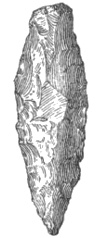
Fig. 211.—Stemmed chipped flint.
K. Edges usually convex, sometimes nearly straight, gradually rounding off into the stem, which may be straight, tapering, or slightly expanding; base straight or slightly convex. All of these are narrow, mostly thick, and none over two inches long. The type (figure 211) is from Bledsoe county, Tennessee; others are from eastern Tennessee; western and central North Carolina; Coosa valley, Alabama; northwestern Georgia; eastern, southern, and southwestern Wisconsin; 154 Kanawha valley, West Virginia; South Carolina; Brown county, Illinois; and northeastern and southeastern Arkansas.
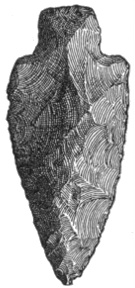
Fig. 212.—Stemmed chipped flint.
L. Edges convex, a very few being straight; shoulders square or somewhat rounded, in two or three somewhat expanding. Stem usually straight, sometimes tapering; base straight or convex. Varying much in size and relative width, being from 1¼ to 4½ inches long, and from ¾ to 2½ inches wide; some slender, others broad. Nearly all are quite roughly made. Illustrated in figure 212 (from Cherokee county, Georgia).
Like many other forms of small chipped implements, the distribution in this type is wide. It comes from northwestern Georgia and about Savannah; Kanawha valley, West Virginia; Miami valley, Ohio; southwestern Illinois; western and central North Carolina; eastern Tennessee; northeastern Alabama and Coosa valley in the same state; and southwestern Arkansas.
M. Convex edges; sharp points; very slight shoulders; stem tapering by curved lines; base convex or somewhat pointed. All made of quartz, quartzite, or coarse flint, and differing from the following group only in being very slender and, owing to the material employed, much more roughly finished. Found in western North Carolina, in South Carolina, and in southwestern Arkansas.
N. Convex edges; remarkably symmetrical outline; most specimens finely finished; slight shoulders; tapering stem, with convex base, the whole stem having a quite regularly curved outline. From 2 to 4½ inches long.

Fig. 213.—Stemmed chipped flint, ovoid.
The type which is shown in figure 213 is from Dane county, Wisconsin. This group also is widely distributed, being found in southern and southwestern Wisconsin; northeastern Kentucky; southwestern Illinois; Miami and Scioto valleys, Ohio, and the central part of the same state; northeastern, central, and southeastern Arkansas; western North Carolina; and Kanawha valley.
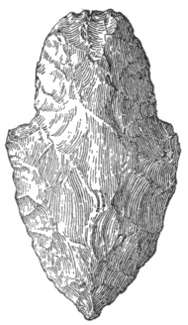
Fig. 214.—Stemmed chipped flint, short blade.
O. Differing from group N only in having longer stems and shorter blades, the latter sometimes less than an inch. Illustrated in figure 214 (from Kanawha valley). Found also in Scioto valley and in central Ohio; southwestern Wisconsin; southwestern Arkansas; and southwestern Georgia.
P. Convex edges; square shoulders; stem forming a quite regular and continuous curve, slightly expanding in some specimens. The one shown in figure 215, from Kanawha valley, West Virginia, has the most 155 symmetric outline of any specimen in the entire collection. There are other specimens from Kanawha valley, and also from northeastern Kentucky; Miami valley, Ohio; Washington county, Pennsylvania; eastern and western Tennessee; southwestern Illinois; and southeastern Arkansas.
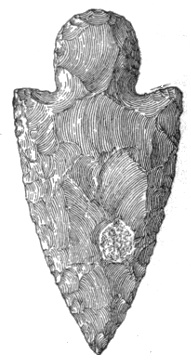
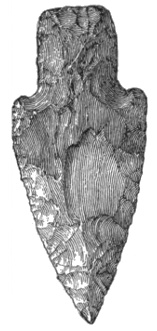
Fig. 215.—Stemmed chipped flint, symmetric outline.
Fig. 216.—Stemmed chipped flint.
Q. Similar to group P except that stem and base are straight. They are symmetric and well finished, vary more in size than those of the last group, being from 1¼ to 4¼ inches long, the others not reaching either of these limits.
The type (figure 216) comes from Knox county, Ohio, and other specimens from Miami valley and central Ohio; Keokuk, Iowa; northeastern Kentucky; Kanawha valley; eastern and western Tennessee; eastern, southeastern, and southwestern Arkansas; eastern and southwestern Wisconsin; northwestern Georgia; and southwestern Illinois.
R. Edges generally convex, sometimes straight; base straight or convex, only rarely concave; shoulders usually square, sometimes rounded; stem expanding by straight lines. From less than an inch to 3½ inches long, mostly about the medium.
The form, which resembles that shown in figure 216 in a general way, is widely distributed, its range including Keokuk, Iowa; Miami and Scioto valleys, Ohio; Bibb county and Savannah, Georgia, as well as the northwestern part of the state; eastern Tennessee; Kanawha valley, West Virginia; southeastern and southwestern Arkansas; southwestern Illinois, and Brown county in the same state; northeastern Kentucky; southern and southwestern Wisconsin; western and central North Carolina; and northeastern Alabama.
S. Differing from group Q in having the blade short, stem long (in some cases longer than blade), and only slight shoulders. Base somewhat convex in a few specimens; from an inch to 2¼ inches in length. From Kanawha valley; northwestern Georgia; Miami and Scioto valleys, Ohio; southwestern Arkansas; southern Wisconsin; and northeastern Alabama.
Beginning with those of group N and ending with those last described, all the best worked and most finely finished specimens are from Kanawha valley, West Virginia; northeastern Kentucky, and the central and southern parts of Ohio.
T. Convex edges; square shoulders; slender; very long and slender tapering or straight stem, coming almost to a point at the base. Illustrated 156 in figure 217 (from Kanawha valley). Others are from central North Carolina; Kanawha valley; southwestern Arkansas; and Catahoula parish, Louisiana. The specimens from the two latter districts have the stem wider and less pointed than the others.
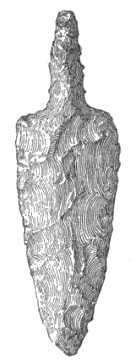
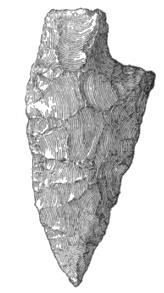
Fig. 217.—Chipped flint, with very long, slender stem.
Fig. 218.—Stemmed chipped flint, with but one barb or shoulder.
U. With one large, much expanded shoulder, the other being absent or very slight; both edges convex, or one convex and the other straight; stem sometimes straight, but usually tapering, being almost pointed in some; base usually convex, sometimes straight, rarely concave. A specimen from Ross county, Ohio, has the base deeply notched; it seems to have been symmetrical originally, and one barb or shoulder being broken, to have had that edge dressed down. Many were thus reworked, but in most cases it is evident that the form is original. Some are slender, others broad.
The type shown in figure 218 is from Bowie county, Texas. Other examples are from southwestern Arkansas; Catahoula parish, Louisiana; Scioto valley, Ohio; Kanawha valley; western and central North Carolina; eastern Tennessee; South Carolina; northeastern Alabama; as well as from northwestern Georgia and about Savannah.
In this class of flints the stem is expanding, unless the contrary is stated. The majority of specimens having barbs belong to this class; while those with straight or tapering stem usually have only square or rounded shoulders, the barb seldom appearing.
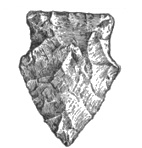
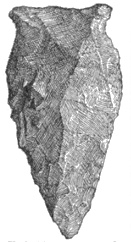
Fig. 219.—Stemmed chipped flint, short.
Fig. 220.—Stemmed chipped flint.
A. Short and broad; base usually straight, sometimes convex, rarely concave; notched in from edges to form the stem; very seldom with well-defined shoulders, and never barbed. The type, illustrated in figure 219, is from Kanawha valley, West Virginia. Found also in northeastern Kentucky; western North Carolina; northwestern Georgia and about Savannah; eastern Tennessee; Coosa valley, Alabama; and Union county, Mississippi.
B. Edges convex, seldom straight; base straight or rarely convex or concave; notched in on edges close to base, so as to leave a slight 157 tang; thin and well worked; from an inch to 2¼ inches long. All from Savannah have concave bases; a few are notched so as to have slight shoulders, and they are somewhat larger than from other localities. They fit better in this group, however, than in any other. A typical example, shown in figure 220, is from Montgomery county, North Carolina. Others are from central North Carolina; eastern Tennessee; southwestern Illinois; various localities in South Carolina; and about Savannah, Georgia.
C. Roughly made; unsymmetrical, seemingly made hastily; of various patterns, including all the common shapes. Nearly all with convex edges, few straight, none concave. Base straight or concave, often the natural surface or fracture of the stone. Sometimes made from the tip of a broken larger specimen. From 1 to 5 inches long; slender or wide; usually thick, except when made from a thin flake. Edges notched just at the base in some, leaving a slight tang; others have the corners chipped out. This group is quite variable in size and in character of workmanship, as well as in form. The material also is variable.
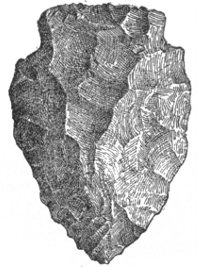
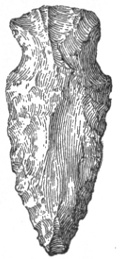
Fig. 221.—Stemmed chipped flint, roughly made.
Fig. 222.—Stemmed chipped flint.
The types (figures 221 and 222) are, respectively, from Bledsoe and Polk counties, Tennessee. The range includes eastern Tennessee; Kanawha valley; western North Carolina; eastern and southwestern Wisconsin; northeastern Alabama and Tuscaloosa valley; South Carolina; southwestern and northeastern Arkansas; central Ohio and Scioto valley; northeastern Kentucky; and southwestern Georgia, as well as Savannah.
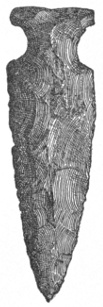
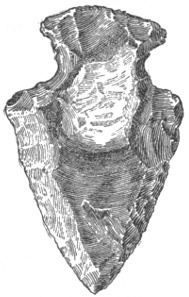
Fig. 223.—Stemmed chipped flint.
Fig. 224.—Stemmed chipped flint, edges convex.
D. Edges convex, rarely straight; base straight or convex; slender; from 1¼ to 4 inches long; usually thin; deeply notched, with edges worked close to base, leaving the latter as wide as the blade, or nearly so. This form could be quite firmly attached to a shaft or handle. It is illustrated by figure 223, representing one of the specimens from Kanawha valley. It is found also in southwestern Illinois and Brown county in the same state; eastern, southern, and southwestern Wisconsin; western and central North Carolina; eastern Tennessee; northwestern Georgia; central Ohio and Scioto valley; southeastern 158 Arkansas; northeastern Kentucky; and Coosa and Tuscaloosa valleys, Alabama.
E. Edges convex; base straight or convex; shoulders square or rounded; stem expanding by curved lines. A few are small enough for arrows, but most of them are large or of medium size. The specimen from Vernon county, Wisconsin, illustrated in figure 224, is representative. The group is characteristic of southwestern Wisconsin; Kanawha valley; central Ohio and Scioto valley; western and central North Carolina; eastern Tennessee; southeastern and southwestern Arkansas; southwestern Illinois; South Carolina; Coosa valley, Alabama; and Savannah, Georgia.
F. Edges straight or convex; long barbs, sometimes reaching to the base; stem straight or slightly tapering; base straight, or very slightly convex or concave, usually well finished. One barb is sometimes longer than the other, or the stem may be to one side of the center line. Sometimes made of a flake, the flat side being left untouched.
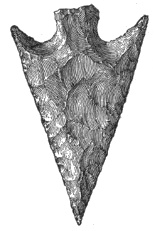
Fig. 225.—Stemmed chipped flint, with long barbs.
The type shown in figure 225 is from Madison county, Alabama. It is found generally in northeastern and northwestern Alabama, and also in eastern Tennessee; Kanawha valley; Keokuk, Iowa; Holt county, Missouri; southwestern Illinois and Brown county in the same state; northwestern Georgia and about Savannah; southeastern and southwestern Arkansas; northeastern Kentucky, and western and central North Carolina.
G. Similar to the last, but with stem expanding by straight or curved lines; base always straight in larger specimens, sometimes convex or concave in smaller ones. Barbs varying in length, short in some and reaching nearly to the base in others. From three-fourths to 3¾ inches in length, and varying much in width.
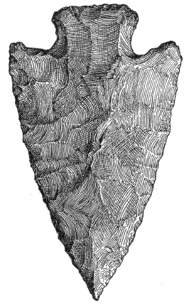
Fig. 226.—Stemmed chipped flint.
Figure 226 represents a typical example from Jackson county, Illinois. The range, which is quite wide, includes southwestern Illinois; northeastern, southwestern, and southeastern Arkansas; Miami and Scioto valleys, and central Ohio; southern and southwestern Wisconsin; western and central North Carolina; eastern Tennessee; South Carolina; northeastern Kentucky; Kanawha valley; and Savannah, Georgia.
H. Wide blade; short; convex edges; square shoulders or slight barbs; base convex or concave; stem broad and expanding by curved 159 lines; generally thick. Those with convex base are all of medium size, while those with concave base range from an inch to 4 inches in length.
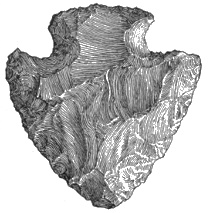
Fig. 227.—Stemmed chipped flint.
The form is indicated in figure 227, representing a good specimen from Dane county, Wisconsin. It is found over southern Wisconsin; northeastern Alabama and Coosa valley; southwestern Illinois and Brown county in the same state; central North Carolina; northwestern Georgia and about Savannah; eastern Tennessee; Miami and Scioto valleys, Ohio; Kanawha valley; southwestern Arkansas; South Carolina; and Keokuk, Iowa.
I. Edges parallel, or nearly so most of the length, with abrupt curve to the point; base straight or slightly convex; stem expanding by straight or curved lines; notched in from the corners of the base giving long barbs, which, in a few, project slightly beyond the line of edges; thin; well worked; from 2 to 4 inches long.
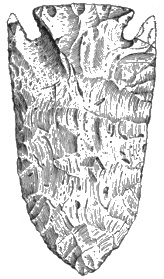
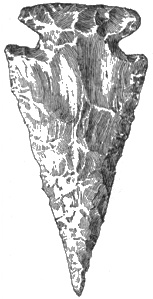
Fig. 228.—Stemmed chipped flint, broad point.
Fig. 229.—Stemmed chipped flint, slender point.
The specimen illustrated in figure 228 is from Dane county, Wisconsin, and there are several others from southern Wisconsin; southwestern Illinois; Scioto valley, Ohio; and Kanawha valley, West Virginia.

Fig. 230.—Stemmed chipped flint.
J. Edges convex or sometimes straight; base straight or slightly convex. Notched in on the edges, leaving the stem nearly or quite as wide at the bottom as the blade; corners of the base square or slightly rounded. Mostly small, suitable for arrows, though a few are larger, up to 3¼ inches. A few of these have the base polished. Some of the small ones are made of flakes having the natural, conchoidal shape and worked on one side only. Typical forms, shown in figures 229 and 230, are from Kanawha valley, and Nicholas county, Kentucky, respectively. The distribution extends also over southern and southwestern Wisconsin; Miami valley, Ohio; Holt county, Missouri; northeastern Kentucky; Brown county, Illinois; southwestern Arkansas; Coosa valley, Alabama; eastern Tennessee, and about Savannah, Georgia. 160
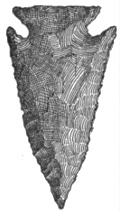
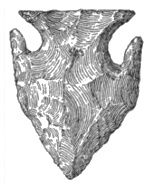
Fig. 231.—Stemmed chipped flint.
Fig. 232.—Stemmed chipped flint, thin.
K. Straight or convex edges (a few serrated or beveled); base straight, sometimes polished; notched in from the corners so as to give sharp barbs, with wide stem expanding by straight lines. Medium size. Illustrated in figure 231 (Bradley county, Tennessee). Found in eastern Tennessee; southwestern Illinois; Scioto valley; Kanawha valley; South Carolina; and about Savannah, Georgia.
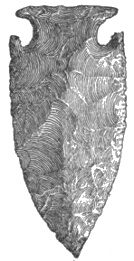
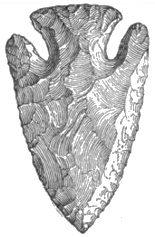
Fig. 233.—Stemmed chipped flint.
Fig. 234.—Stemmed chipped flint.
L. Very thin; well worked; usually quite symmetrical; base straight or slightly concave; stem expanding by curved lines; with shoulders or barbs; base with sharp tangs. Some specimens quite slender, others almost as wide as long. Few are above two inches in length. The edge is sometimes a broken line instead of a regular curve. The form is shown in figures 232 and 233, representing specimens from Lawrence county, Ohio, and Loudon county, Tennessee, respectively. Others are from Kanawha valley; Miami and Scioto valleys, Ohio; eastern Tennessee; western and central North Carolina; Union county, Mississippi; northeastern Kentucky; and southwestern Illinois.
M. Convex edges; usually quite symmetric; base generally straight, although sometimes convex or concave; stem expanding by straight or curved lines, and notched in from the corners by a narrow notch whose sides are parallel. Sometimes beveled (or feathered). The barb as well as the notch of the same width throughout its entire length. The type (figure 234) is from Knox county, Ohio, and similar forms come from central Ohio; Kanawha valley; western North Carolina; southern Wisconsin; southwestern Illinois; South Carolina; eastern Tennessee; and Savannah, Georgia.
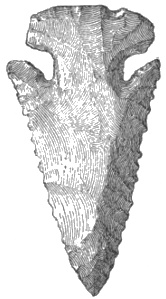
Fig. 235.—Stemmed chipped flint.
N. Straight, or rarely convex, edges; base straight or slightly curved, with rounded corners; notched in on the edges above the corners, with sharp barbs. Nearly every specimen is beveled, and some are serrated. Base polished in many of them even when slightly concave. A good example from Ross county, Ohio, is represented in figure 235. Others are from Miami and Scioto valleys and elsewhere in Ohio, as well as from Kanawha valley; eastern Tennessee; northwestern 161 Alabama; southwestern Georgia, and about Savannah in the same state. The style of chipping is frequently such as to give serrated edges, as in the specimen figured.

Fig. 236.—Stemmed chipped flint, slender, with small stem.
O. Long; slender; thin; short, small stem; convex base; notched upward from the corners of the base; short barbs. The type shown in figure 236 is from Loudon county, Tennessee, and other specimens come from eastern Tennessee and southeastern Arkansas.
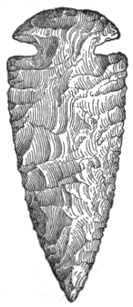
Fig. 237.—Stemmed chipped flint, oval outline, notched.
P. Convex edges and base; sometimes, though very seldom, the edges are nearly straight; the typical, leaf-shape implement, except for the notch, which is always worked in from the widest part of the specimen at right angles to the axis. The base is invariably polished, even in the smallest specimens. From Licking county (figure 237) as well as from Miami valley and throughout central Ohio; Kanawha valley; eastern Tennessee; southwestern Illinois; northeastern Alabama; southern Wisconsin; and about Savannah, Georgia.
Q. Edges less convex than the last, sometimes straight; the notches are worked in nearer the base, going in an angle of about 45 degrees, instead of perpendicular to the middle line or axis. Sometimes the blade is of uniform thickness until very close to the edges, which are worked off in a double chisel-edge. Very few of these, or of group P, are small enough for arrows. Usually symmetrical and well finished; the base always polished, but whether from use or to add to the utility of the specimen can not be determined. From Miami valley, Ohio; Keokuk, Iowa; southwestern Wisconsin; and eastern Tennessee.
R. Differing from the two last described only in being longer, and in having the stem always come to a point by either convex or concave lines, instead of being regularly convex; base never polished. From Kanawha valley, West Virginia, and central Arkansas.
S. Edges usually straight, sometimes concave, rarely convex; notched in deeply from edges; seldom barbed; stem nearly always wider than the blade, and large. Base convex; occasionally somewhat concave with rounded corners, and nearly always polished. Some (including all from the Savannah collection) are beveled and a few have blunt and rounded points, apparently broken specimens reworked. From less than an inch to nearly 3 inches long. Even among the very small ones, some have the base polished.
An implement of this form, or of any form in which the stem is wide or with very long tangs, and especially with concave base, would be well adapted for hunting purposes. The wide stem would allow firm 162 attachment to a shaft, whether as an arrow or a spear, and at the same time would be very difficult to withdraw from a wound. The shaft would impede the flight of an animal pierced by the weapon, particularly in weeds or bushes; though greater force would be required with these than with the more slender points to make them effective.
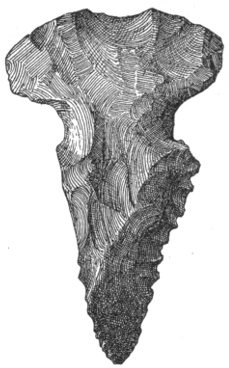
Fig. 238.—Stemmed chipped flint.
The type delineated in figure 238 is from Warren county, Ohio, and the form is well represented also in Scioto and Miami valleys, Ohio; western North Carolina; Kanawha valley; eastern Tennessee; southern and southwestern Wisconsin; southeastern and southwestern Arkansas; northeastern Kentucky; northeastern Alabama; and about Savannah, Georgia.
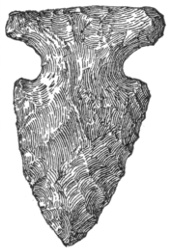
Fig. 239.—Stemmed chipped flint, notched, very wide stem.
T. Convex edges; base straight, or slightly convex or concave, with square corners, and nearly always polished; stem as wide as the blade or wider. Some rather slender, others as wide as long. Very few are beveled, except those from Savannah, all of which are thus made. From three-fourths to 2¼ inches long. Found in eastern Tennessee; Kanawha valley (including the specimen shown in figure 239); western North Carolina; southern and southwestern Wisconsin; South Carolina; southwestern Arkansas; Miami valley, Ohio; and in the vicinity of Savannah.
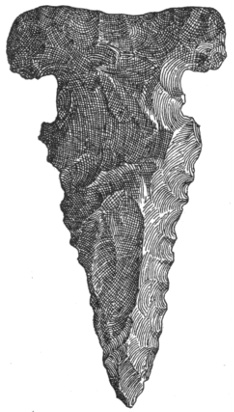
Fig. 240.—Stemmed chipped flint, notched, very wide stem.
U. Edges usually straight, sometimes convex; base regularly concave, or rounding off into a convex curve at the corners, and nearly always polished. The stem in all is wider than the blade. Those from Savannah are all beveled, and but few of them have polished bases. The type, illustrated in figure 240, is from Kanawha valley, and others come from Kanawha valley; southern Wisconsin; Scioto valley; eastern Tennessee; southwestern Illinois; and Savannah, Georgia.
V. Edges convex, seldom straight, never concave; usually well finished; base concave; notch worked in from the edge above the corner so as to leave the upper portion of the tang parallel to the lower, or base; corners square. Few are beveled. The length is from 1 to 4 inches, 163 the width also varying considerably; some are widest at or near the middle of the blade, others are as wide at base as at any other part.
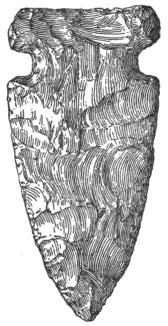
Fig. 241.—Stemmed chipped flint.
The form is illustrated in figure 241 (Union county, Illinois). The distribution is wide, including southwestern Illinois; northwestern and southwestern Georgia and Savannah; northeastern Kentucky; Kanawha valley; South Carolina; northwestern Alabama; eastern Tennessee; eastern and southern Wisconsin; western and central North Carolina; southeastern and southwestern Arkansas; Miami valley, Ohio; Keokuk, Iowa; and Union county, Mississippi.
W. Edges usually convex, sometimes straight; notched in on the edges above the corners; base concave; some slender, others broad. Somewhat resembling the two preceding types, but more roughly made. From 1 to 4 inches long. Represented by material from western and central North Carolina; Kanawha valley; eastern Tennessee; northeastern Alabama and Coosa valley, as well as from Miami valley, Ohio.
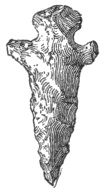
Fig. 242.—Stemmed chipped flint, projecting shoulders.
X. Small; very slender; convex edges, with wing-like barbs or shoulders; stem slightly expanding by curved lines. This rather rare type, shown in figure 242 (from Ouachita county, Arkansas), is known from northeastern and southwestern Arkansas, as well as eastern Tennessee, and Savannah, Georgia.
Y. Edges mostly straight, in a few convex; base straight, convex, or concave, in some specimens of each being polished; notched in on the edges just above the corners, notches usually slight; always widest at base. A few, including all from Savannah, are serrated or beveled. Very few are over an inch and a half long. They are nearly always thick. One from Kanawha valley has the point worn perfectly smooth and the edges polished half way to the base, showing use as a drill. Points of this form would make the countersunk holes so common in gorgets and other flat stones.
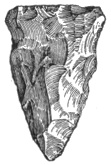
Fig. 243.—Stemmed chipped flint.
This form is widely distributed. The type (figure 243) is from Lawrence county, Ohio. Its range includes Miami and Scioto valleys, Ohio; northwestern Georgia and Savannah; eastern Tennessee; Kanawha valley; southwestern Illinois, and Brown county in the same state; western North Carolina; Coosa valley, Alabama; southwestern Arkansas; South Carolina; northeastern Kentucky; and eastern Wisconsin.
Z. Very rough finish; blade more or less worked by first chipping (there being usually no secondary chipping) to convex edges; base generally the natural surface of the nodule or pebble from which the implement was made; notches worked 164 in roughly on the edges. They were probably knives or spears, or in some cases celts or chisels, though none show polish. With these are placed a few that seem to be the points of larger rough implements, broken and having notches worked in the fragments. A typical form, shown in figure 244, is from Mississippi county, Arkansas. It occurs also in northeastern Arkansas; Scioto valley, Ohio; western Tennessee; southwestern Illinois; and Kanawha valley, West Virginia.
The implements variously classed by different writers as awls, drills, needles, rimmers or reamers, and the like, seem to represent a graded series, and as no distinction can be made in the different kinds, if, indeed, there is any room for distinction, they are grouped under one term, “perforators.”

Fig. 244.—Stemmed chipped flint, very rough.
Very few of the specimens could be used as drills, as most of them are too thin; only those with a rhomboidal or triangular section would seem adapted to this purpose, and the majority even of these seem too fragile. It is more probable that drilling was done with a stick or horn, with sand as a cutting medium, except in the thin tablets of slate or similar stone and in shells. The thicker flints would answer very well for this purpose, and the countersunk holes appear to indicate such an instrument. For sewing, bone would be more easily worked, and better suited than flint. The double-pointed slender specimens may have been used for bait-holders in fishing; bone implements of a similar shape, with a hole drilled at the middle for attaching a line, have been seen in use among the Indians of Florida.
Some such implement was no doubt used in the manner of a burin, especially in making the fine lines on the ornamented shells or stones; certain flints in the collection may have served such a purpose.
Lubbock considers it proved that the stone of which ornaments, carved axes, etc., are made could be worked with flint, and that the engraving on the Scotch rocks, even on granite, was executed with this material;174 and Bushmen are known to use triangular pieces of flint for cutting figures in rocks.175 Evans176 observes that there are five ways of making holes in stone, viz.: (1) Chiseling or picking, with “picks,” “celts,” or “drills” of flint or other stone; (2) boring with a solid borer, as wood, hard or soft, or horn with sand and water; (3) grinding with a tubular grinder, as horn, cane, elder, etc., with sand and water; (4) drilling with a stone 165 drill, e.g., of flint or sandstone; (5) drilling or punching with metal. It should be remembered that there are no evidences of the use of any metal except copper for economic purposes by the aborigines of the United States; and nearly everything of this material seems to have been ornamental in character. Bancroft says that the Nootka, in boring in wood, use a bird-bone drill worked between the hands,177 while according to Schumacher, the Santa Barbara Indians chip out rough disks of shell, pierce them with a flint drill, and enlarge the hole with a slender, round piece of sandstone.178 The Atlantic coast Indians drilled shell beads with a nail stuck in a cane or stick, rolling the drill on their thighs with the right hand, and holding the shell in the left;179 and the southern Indians, according to C. C. Jones, pierced shell beads with heated copper drills.180 Evans has found that ox-horn and sand make good borers,181 while low tribes on the Amazon make crystal tubes an inch in diameter and up to 8 inches long by rubbing and drilling with a flexible shoot of wild plantain, twilled between the hands, with sand and water;182 and Tylor expresses the opinion that such operations are not the result of high mechanical skill, but merely of the most simple and savage processes.183
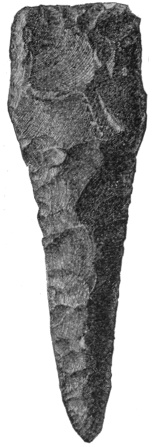
Fig. 245.—Perforator, not stemmed.
A. Base straight or nearly so; edges straight and parallel, sometimes half the length from the base, thence with concave curve which is reversed near the end to give a blunt point; these, usually the wider ones, are always thin, and were probably knives. The smaller ones, resembling the small triangular arrows except for the sharpened upper end, may have been for arrowheads, though the sharp points would have served well as awls or needles. Many of the smaller ones seem to be made from small broken arrowheads; exemplified by the specimen from Montgomery county, North Carolina, shown in figure 245. The collection includes material from western and central North Carolina; eastern Tennessee; Kanawha valley; northeastern Alabama; South Carolina; Keokuk, Iowa; and Savannah, Georgia.

Fig. 246.—Perforator, not stemmed, double pointed.
B. Slender, somewhat larger about the middle and tapering to a point at each end, or regularly and gradually decreasing 166 from base to point. Some are undoubtedly arrowheads, as they are too blunt or too thin to have been used for piercing. Others show marks of use which could have been produced in no way except by drilling in stone. The specimen illustrated in figure 246 (from Kanawha valley) shows this to a marked degree, while that shown in figure 247 (from Nicholas county, Kentucky) is without such indications. The distribution of this form is wide, including Kanawha valley; northeastern Kentucky; southwestern Illinois; southwestern Arkansas; southwestern Wisconsin; Coosa valley, Alabama; northwestern and southwestern Georgia, and Savannah; eastern Tennessee; and Scioto valley, Ohio.

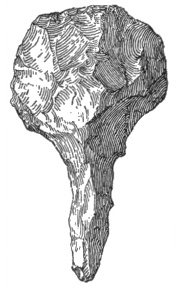
Fig. 247.—Perforator, not stemmed, double pointed.
Fig. 248.—Perforator, not stemmed, rough base.
C. With the base very large in ratio to the point or piercer; sometimes the entire implement is worked smooth or thin, again it is the natural fragment or chip of stone entirely unworked except a point flaked on one part or edge. The piercer varies from one-fourth of an inch to two inches in length. It could have been utilized only as an “awl” or “needle,” the base being held by the thumb and finger. This variable form is represented in figure 248 (from Lawrence county, Ohio). It comes from Scioto valley; Kanawha valley; western and central North Carolina; northeastern Kentucky; Keokuk, Iowa; southwestern and southeastern Arkansas; eastern Tennessee; and Savannah, Georgia.


Fig. 249.—Perforator, not stemmed, expanding base.
Fig. 250.—Perforator, not stemmed, expanding base.
D. Piercer thin and slender; base thin, expanding to a wing-like projection on each side. Very few are strong enough to have been used for drilling even in soft material, but they are excellent for piercing leather or similar substances. The expanding wings would make them good points for hunting and fishing arrows, as they would have great penetrating power and be very difficult to extract from a wound, while allowing very firm attachment to a shaft. The type, shown in figure 249, is from Kanawha valley. Other specimens come from the same locality, and also from southwestern Illinois, and Brown county in the same state; eastern Tennessee; Keokuk, Iowa; Scioto valley, Ohio; northeastern Kentucky; southern Wisconsin; and Savannah, Georgia.
E. With slight expansion at the base. These may be thick or thin, wide or narrow, and, according to their different forms, might be used 167 as drills, piercers, or arrowheads. A good example (presented in figure 250) is from Kanawha valley, West Virginia. It is found also in northeastern Kentucky, northeastern and southeastern Arkansas; eastern Tennessee; southwestern Illinois; and southwestern Wisconsin.
All of the foregoing perforators are without stems, unless the larger portion left at the base may be considered as such.
The form of the stem and shoulders among perforators is often the same as in the stemmed arrowheads, etc., previously described.

Fig. 251.—Perforator, stemmed.
A. Stem usually tapering; shoulder more or less defined; never barbed; blade wide at the part next to the stem, tapering rapidly by concave lines to a sharp point. Probably spearpoints or large arrowheads with the blade worked to a point. The type, shown in figure 251, is from Kanawha valley.
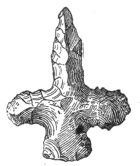
Fig. 252.—Perforator, stemmed, very wide shoulders.
B. Slender point; wide wings or shoulders; stem straight or nearly so; the implement having the form of a cross. Some are less than an inch long, and very delicately worked, while others reach 3 inches in length, and are thick. Some from Savannah have very broad stems. There is a good example (figure 252) from Ouachita county, Arkansas, and others from southwestern Arkansas; western North Carolina; and Savannah, Georgia.
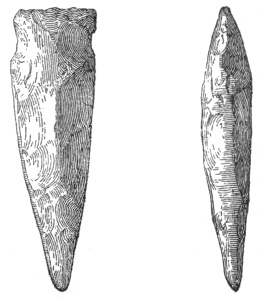
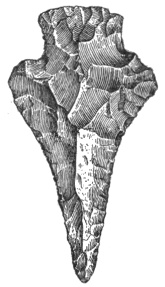
Fig. 253.—Perforator, stemmed.
Fig. 254.—Perforator, stemmed.
C. Narrow and thick almost of a diamond or round section; stem expanding or straight; with slight shoulders, sometimes slightly barbed. Some of the thinner ones, probably arrows, have a lenticular section; a few are triangular in section. This form is well suited for drilling, and many of the specimens show marks of such use, especially the one illustrated (figure 253), the edges of which are striated almost the entire length. This is from Mason county, Kentucky; and the distribution of the type includes Kanawha valley; Scioto valley, Ohio; eastern Tennessee; northeastern Alabama; western and central North Carolina; southeastern and northeastern 168 Arkansas; Brown county, Illinois; South Carolina; and northeastern Kentucky. Thus the type is common and its geographic range broad.
D. Long, slender point; shoulders wide or slightly barbed; stem straight, tapering, or expanding; edges straight or concave. Some would make good piercers for soft material, but very few could be used as drills. A majority would be good arrowheads. Some have the edges smooth, but if this was caused by drilling it must have been done in enlarging holes already made, since the implements so marked are very thin. The faces of the blades show no polish or smoothness, such as might result from use as knives. The specimen illustrated (figure 254) is from Madison county, Alabama; others from northeastern Alabama and Coosa valley; Scioto valley, Ohio; eastern Tennessee; western and central North Carolina; southwestern Arkansas; Kanawha valley; and Savannah, Georgia.
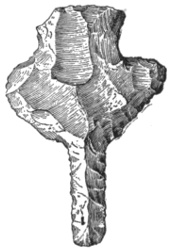
Fig. 255.—Perforator, stemmed, with cutting point.
E. Stem may be of any form; wide shoulders; never barbed; point or piercer narrow, well worked, with edges parallel its entire length, and terminating in a cutting edge instead of a point. This form (shown in figure 255) is found only in the collection from Savannah, Georgia.
Certain arrowheads have the end opposite the base rounded or flattened instead of pointed. Commonly, both faces are worked off equally, to bring the edge opposite the middle line of the blade, though sometimes it may be a little to one side. The stem and base are of any form found in the common patterns of arrowheads. Few are barbed, though many have shoulders. For the most part, they are probably made from the ordinary spearpoints or arrowheads and knives that have had the points broken off, though some seem to have been intentionally made this way originally. A few are smooth or polished at the ends, as though used as knives or scrapers; but most of them have no marks except such as would result from being struck or shot against some hard substance; even this being absent in many of them, as in the specimen represented in the accompanying figure.
Jones says that crescent-shaped arrows were used by southern Indians for shooting off birds’ heads,184 and it is known that chisel-shape arrows were much used during the Middle Ages.185
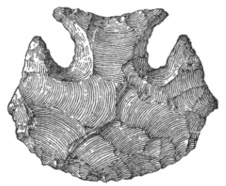
Fig. 256.—Blunt arrowhead, or “bunt”.
This type of aboriginal implement or weapon is shown in figure 256, representing a specimen from Savannah, Georgia. Other examples 169 come from eastern Tennessee; Kanawha valley; western North Carolina; southern and southwestern Wisconsin; southwestern Illinois; Scioto valley, Ohio; and Savannah, Georgia.
The same remarks as to form and method of making apply to stemmed scrapers as to blunt arrows, except that the chipping of the end is always from one face so as to produce a chisel edge. This edge is frequently smooth or polished from use. They would answer very well for smoothing down articles made of wood, or for cleaning hides in tanning; they would also serve excellently for removing scales from fish, and as they are usually abundant in the vicinity of good fishing places, they were no doubt employed for this purpose.
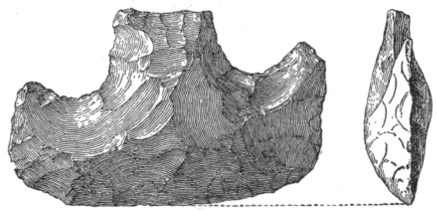
Fig. 257.—Stemmed scraper.
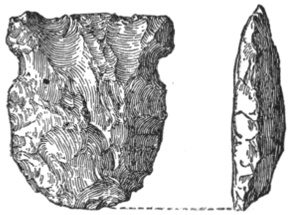
Fig. 258.—Stemmed scraper.
The material in the Bureau collection is represented by the specimens shown in figures 257 and 258, from Savannah, Georgia, and Dane county, Wisconsin, respectively. Other examples come from southern Wisconsin; southwestern Illinois; Kanawha valley, West Virginia; northeastern Kentucky; Miami valley, Ohio; central North Carolina; eastern Tennessee; and Savannah, Georgia.
A few quotations regarding the use and mode of manufacture of stemless scrapers may be given:
According to Evans, they are made by laying a flake flat side up on a stone, and chipping off around the edge with a hammer. The point struck must rest directly on the under stone, and but a thin spall is struck off at each blow.186 Leidy observed that the Shoshoni by a quick blow strike off a segment of a quartz bowlder in such a way as to form a circular or oval implement flat on one side, convex on the other, which is used as a scraper in dressing buffalo hides;187 and according to Knight the Australians obtain, in exactly the same way, specimens which they use as axes.188 Peale remarks that while hides are green they are stretched on the ground and scraped with an instrument resembling an adze;189 and Dodge says more explicitly that when the stretched skin has become hard and dry, the woman goes to work on it with an adze-like 170 instrument, with a short handle of wood or elkhorn tied on with rawhide; holding this in one hand, she chips at the hardened skin, cutting off a thin shaving at every blow.190
The scrapers of this class in the Bureau collection are as follows:
A. Chipped over the entire surface to the form of the ordinary celt, except that the scraping edge is in the same plane with one face. Some have a scraping edge at each end. In a few the flat or straight face is chipped off slightly, bringing the edge toward the middleline; but this was probably done after the implement had become broken or blunted from use. When there is any polish, it is always on the flat face, showing use as an adze, or, possibly, as a plane. Varying much in width, some measuring almost the same in either direction, while others are more like the “chisel” celts, though the position of the cutting edge shows their use.

Fig. 259.—Stemless scraper, celt form.
A typical specimen (figure 259) is from Jackson county, Illinois; others come from Brown county and the southwestern part of the state generally; from northeastern Kentucky; Keokuk, Iowa; southwestern Wisconsin; eastern Tennessee; and central Ohio.
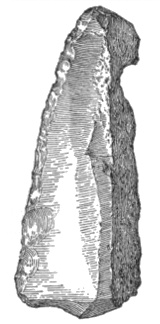
Fig. 260.—Stemless scraper, flake.
B. Flakes or spalls, chipped always from the concave side of the fragment. Some of the smaller specimens, usually those of somewhat circular outline, are chipped nearly, or in some cases entirely, around the edge. Figure 260 represents a specimen from Mason county, Kentucky. Others come from northeastern Kentucky; eastern Tennessee; Holt county, Missouri; Kanawha valley; southwestern Wisconsin; Miami valley, and central Ohio; Coosa valley, Alabama; Union county, Mississippi; and Savannah, Georgia.
The generally accepted name “cores” is applied to the blocks from which are struck off the flakes to be next described.
Dr. Gillespie191 claimed that objects of this kind were made so intentionally, and that the flakes are simply the refuse or waste material. 171 He gives six reasons for this belief, but an examination of the objects themselves would show that he is in error. That some might have been used as scrapers may be true, but very few are suited for such work, and not one shows the least mark of wear that could result from this use.
The specimens in the Bureau collection, with perhaps half a dozen exceptions, are from the aboriginal quarries at Flint ridge, in Licking county, Ohio, or of the material so abundant at that place.
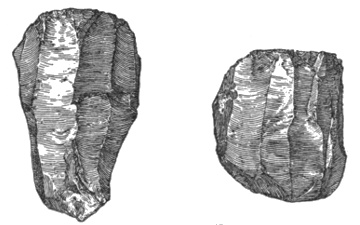
Fig. 261.—Cores.
All are small, few being of a size to furnish flakes over three inches long. The flakes were undoubtedly struck off by means of stone hammers, hundreds of which are to be found about the quarries, or removed by pressure, many showing the bulb of percussion, others being perfectly smooth on the flat face. Usually all the flakes were obtained from only one side of the core until it became too small to work (figure 261). Occasionally they were chipped from opposite sides, leaving the core of a conical or cylindrical shape (as represented in figure 262).
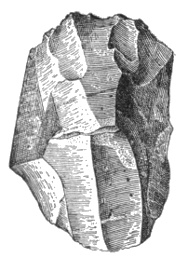
Fig. 262.—Core.
Cores and finely chipped implements of the Flint ridge stone have been taken from the mounds in Kanawha valley, West Virginia, and Scioto valley, Ohio, showing that the mound-builders are to be credited with at least a part of the great amount of work done in those localities; but it seems a mistake to say, as some authors have done, that the “turtlebacks” found in caches in southern Illinois are from the same source, as the stone is entirely different, and occurs abundantly in the vicinity in which the specimens are found.
The use to which were put the narrow, thin flakes so abundantly found in many parts of the world has caused some discussion. Schoolcraft says that the Dakota bleed patients by scarifying with these flakes; or sometimes one is fixed into the end of a piece of wood, held over a vein, and driven in as far as the wood will let it go,192 the use being similar to that of the modern fleam. Harpoons in the Kurile islands are made of bone, with a deep groove along each side; in these grooves thin and sharp flat flakes are fastened with gum.193 According to Evans, similar flakes were used for scraping,194 just as broken glass is used among modern 172 woodworkers. Flakes have been found in the Swiss lakes in wooden handles in the fashion of Eskimo knives; also in Australia with skin wrapped around one end to protect the hand.195
All the flakes in the Bureau collection are small, few of them being over three inches long. They are found elsewhere with a length of over a foot; but the nature of the flint occurring in the United States is seldom such as to allow flakes to be struck off equaling in size those found in Europe.
Evans says that blows with a pebble will form just such flakes as those produced by an iron hammer; the blows must, however, be delivered in exactly the right spot and with the proper force. Cores sometimes show markings of hammers when struck too near the edge. Flakes can be produced by using a pebble as a set or punch and striking it with a stone. The use of a set was probably the exception rather than the rule, for great precision may be obtained simply with a hammer held in the hand. The Eskimo use a hammer set in a handle to strike off flakes, or strike them off by slight taps with a hammer of jade, oval in shape, about 2 by 3 inches, and secured to a bone handle with sinew.196
According to Tylor, the Peruvian Indians work obsidian by laying a bone wedge on the surface of a piece and tapping it until the stone cracks;197 while the Indians of Mexico hold a piece of obsidian 6 or 8 inches long between their feet, then holding the crosspiece of a T-shape stick against the breast they place the other end against the stone and force off a piece by pressure.198
Nilsson says that the Eskimo set a point of deer horn into a handle of ivory and drive off splinters from the chert,199 and Redding saw a Cloud river Indian make flakes thus: Holding a piece of obsidian in his hand, he placed the straight edge of a piece of split deer horn, four inches long and half an inch in diameter, at a distance from the edge of the stone equal to the thickness of the arrow he wished to make; then striking the other end with a stone he drove off a flake.200 Schumacher observed that the Klamath Indians heat a stone and break it into fragments at a single blow.201
According to Stevens the Shasta Indian lays a stone anvil on his knee, and holding on the anvil the stone which he is working,202 strikes off a flake one-fourth of an inch thick with a stone hammer; but Powers says the Shasta Indians heat a stone and allow it to cool slowly, which splits it into flakes,203 and Bancroft that they place an obsidian pebble 173 on an anvil of stone and split it with an agate chisel to the required size.204 The Shoshoni or Snake Indians of the northwest work in the same way,205 and certain California Indians strike off flakes from a mass of agate, jasper, or chalcedony with a stone hammer,206 while the Apache break a bowlder of hornstone with a heavy stone hammer having a twisted withe for a handle.207
Schoolcraft says experience has taught the Indians that some varieties of hornstone (flint) are less easily fractured than others, and that the conchoidal form is found best in softer varieties; also that weathered fragments are managed with greater difficulty than are those freshly quarried.208
Evans points out that in making gunflints much depends upon the condition of the stone as regards the moisture it contains, those that have been too long exposed on the surface becoming intractable, and there is also a difficulty in working those that are too moist. Some of the workers, however, say that a flint which has been some time exposed to the air is harder than one recently dug, yet it works equally well.209
It is related that in former times white hunters in Ohio and Kentucky, when they needed a gunflint, would select a fragment from the surface, where practicable, and soak it in oil for several weeks “to make it tough;” otherwise it would shatter to fragments when struck.
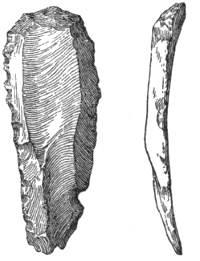
Fig. 263.—Flake, chipped for scraper.
Frequently the large flat spalls knocked from blocks or chunks of flint in shaping them, or in obtaining pieces to work, are of such form that very little additional labor converts them into serviceable scrapers, knives, spears, or arrows. A number of such pieces are found in the collection. These, however, are not considered in the flakes now to be described:
A. Edges bluntly chipped (from the concave side) for use as scrapers. They may or may not have notches for attachment to a handle. An example from Kanawha valley, West Virginia, is shown in figure 263. Others come from southwestern Arkansas; Kanawha valley; Miami and Scioto valleys, and central Ohio.
B. Trimmed only enough to give a general leaf shape, the faces being left unchanged; for use as knives or arrowheads, most of them being exceedingly small; notched, or with continuous edges. This form is 174 represented by the specimen from Licking county, Ohio, illustrated in figure 264. It is found in central Ohio; northeastern Arkansas; Coosa valley, Alabama; eastern Tennessee; and western North Carolina.

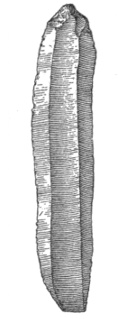
Fig. 264.—Flake, chipped for knife or arrow head.
Fig. 265.—Flake, slender, probably for lancet.
C. Long, slender, with three or four facets on one face, caused by others having been struck off above. The edges are as keen as broken glass, and the points are usually quite sharp. In a great many the points have been worked off by fine, secondary chipping. When this is done, it is always at the end which was struck in knocking off the flake. In some cases it may be due to the shattering effects of the blow; but in many specimens the evidence is plain that it was done afterward for the purpose of making a sharper point. Some flakes of this kind have notches for attachment to a shaft, probably for arrows; such specimens, however, are without the secondary chipping, and the notches are at the end opposite the one struck.
A good example, shown in figure 265, is from Kanawha valley, and there are others from the same locality, as well as from Miami valley, Ohio; and Union county, Mississippi.
From the Savannah collection there are several forms of chipped flints which, while resembling the foregoing in various ways, present characters which make it necessary to place them by themselves; and while containing a majority of the types described above, this collection has many that have no counterpart from any other section visited by the Bureau collectors. Some of these unique specimens of aboriginal art are among the following:
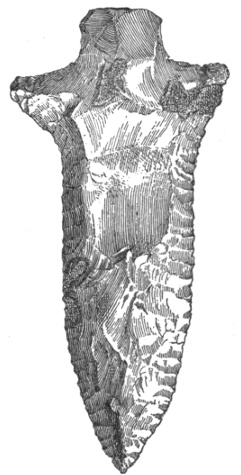
Fig. 266.—Stemmed chipped flint.
A. Edges double curved, expanding to a wide point at the shoulder; stem straight or tapering; base either straight or slightly convex. The type of the group is quite well represented in figure 266. 175
B. Edges concave; base and stem straight; very wide projections or wings at the shoulders, going in by straight or curved lines to the stem (illustrated in figure 267).
C. Edges concave, changing to convex at the shoulders, and curving around to the stem, which is straight or slightly expanding; base straight or very slightly convex (figure 268).
D. Convex edges, widening into greatly expanding barbs; base straight; stem expanding by straight lines (figure 269).
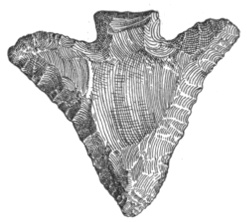

Fig. 267.—Stemmed chipped flint, winged.
Fig. 268.—Stemmed chipped flint.
E. Broad; double-curved edges; notched in from the base, and barbs worked so as to be narrowest near the blade, with the ends straight or round; stem expanding by straight lines; base straight (figure 270).
F. Edges nearly straight to the barbs, which are worked off to a point toward the stem; base convex and wide; stem expanding by curved lines (figure 271).
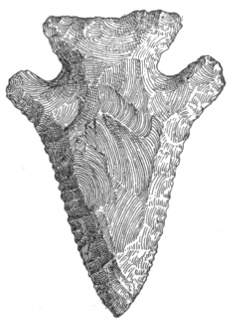
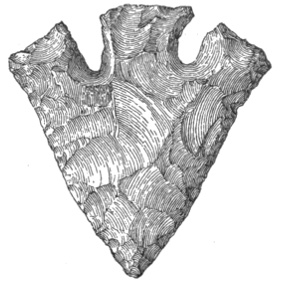
Fig. 269.—Stemmed chipped flint, barbed.
Fig. 270.—Stemmed chipped flint, broad.
G. Rather slender; base nearly straight, either convex or concave; stem rapidly expanding; notched in from the corners, making long slender barbs which project beyond the line of the edges (as illustrated 176 in figure 272). The same form comes from Dougherty county, southwestern Georgia, as well as from Savannah.
H. Straight or convex edges; base straight or slightly convex; stem to one side of the center, leaving one barb longer and larger than the other (figure 273).
I. Triangular, notched in from the bottom; barbs extend down even with the base, or the base is sometimes worked back, leaving it shorter than the barbs; some are beveled (figure 274). The same form is found in southwestern Georgia.
J. Broad; straight edges; base straight or concave; stem straight or expanding; long, rounded barbs (figure 275).
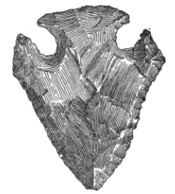
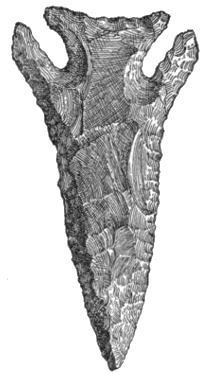
Fig. 271.—Stemmed chipped flint.
Fig. 272.—Stemmed chipped flint, slender.
K. From Arkansas county, Arkansas, there is an implement of basanite or black jasper, of the general type of figure 180 or 182, the point being broken off. The base has been worked down to a sharp edge, the stem highly polished on both faces. This polish does not extend to the faces of the blade, but both edges are rubbed smooth so far as they now extend. Whether the implement was originally pointed and used as a knife or spear, this sharp edge being given the stem after it was broken, or whether it was so made in the first place, can not be determined. Like the various forms with polished base, the specimen seems to indicate a manner of mounting or of use the reverse of what would be expected. It is shown in figure 276.
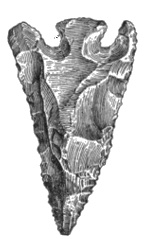
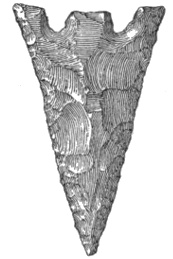
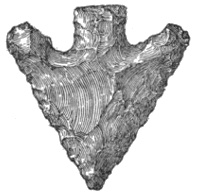
Fig. 273.—Stemmed chipped flint.
Fig. 274.—Stemmed chipped flint, triangular.
Fig. 275.—Stemmed chipped flint.
Figure 277 shows an implement from Licking county, Ohio, somewhat of the form of figure 205, except that it is wider and much thinner. It is worn smooth on each edge for ¾ inch from the point, the point itself being quite blunt. This probably results from use as a knife or drill; though, if due to the latter cause, the material on which 177 it was used must have been quite soft or thin. Similar wear is seen on implements from the same locality of the form of figures 176 and 223, but this article is smaller than those represented by the figures.
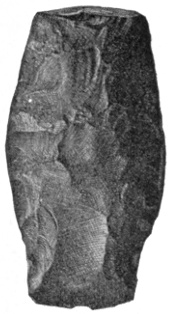
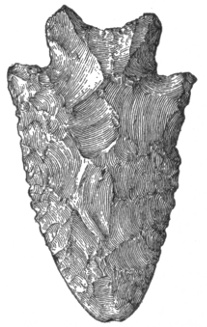
Fig. 276.—Chipped flint, with sharp-edged stem.
Fig. 277.—Stemmed chipped flint, point blunted from use.
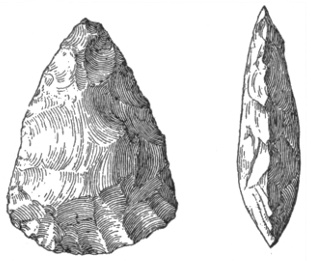
Fig. 278.—Stemmed chipped flint.
In figure 278 is shown a small knife of the pattern so common in specimens mounted in antlers, from the Swiss lake dwellings. In outline it resembles the arrowheads having straight edges and a convex base; but the side view shows the purpose for which it was made. Similar pieces are found throughout central Ohio, and along Ohio river from the Kanawha to the Miami.
In the beveled flints the side-chipping producing the bevel is always to the left, as may be seen in figure 235; only one exception to this has been found. It has been supposed that this is done to give a rotary motion to an arrow. Morgan210 says that “arrowheads are occasionally found with a twist to make the arrow revolve in its flight;” and 178 the same statement has often been made by others. It may be objected, however, that very few of these beveled specimens are small enough for arrowheads; and modern archers have shown that the shape does not affect the flight of the arrow.
Schoolcraft,211 Powers,212 Morgan,213 and Cheever214 say that the modern Indians sometimes have a spiral arrangement of the feathers on their arrow to produce a rotary motion or “rifling.” This rotary motion is supposed to keep the arrow in a straight course, as without it a deviation from the direct line would tend constantly to increase. But as showing that the rotary motion is not always desired, Dodge says that sometimes the blade, in regard to the string notch, is set so as to be perpendicular, to go in between the ribs of game; again, so as to be horizontal, to go in between the ribs of an enemy.215
The beveled flints were probably used for skinning game, as they are better fitted for this than for anything else, and would serve such purpose better than almost any other form of the smaller chipped flints. The bevel is such as would be necessary if the implement were held in the right hand and pulled toward the user.
There are a great many specimens in the collection, both in the ground or pecked and in the chipped implements, which can not be classified with any of the objects herein described; but they are to be considered as due rather to individual whims than as representative of a type.
1 Anahuac, p. 101.
2 Ibid., p. 98.
3 Dawson, Sir William; Fossil Men, p. 121.
4 Smithsonian Report for 1884, p. 741.
5 Ibid., p. 748.
6 Tylor; Early History of Mankind, p. 169.
7 Lubbock, Sir John; Prehistoric Times, p. 569.
8 Early History of Mankind, p. 203.
9 Abbott, C. C., in American Naturalist, vol. X, p. 494.
10 Perkins; Ibid, vol. XIII, p. 738.
11 Adair; History of American Indians, p 405.
12 Long, S. H.; Expedition to the Rocky Mountains, p. 211.
13 Knight, E. H.; Smithsonian Report for 1879, p. 242.
14 Wood, J. G.; Natural History of Mankind, p. 200.
15 Morgan, L. H.; League of the Iroquois, p. 358.
16 Beverly, Robt.; History of Virginia, 1722, p. 198.
17 Wyth, John; Graphic Sketches, part I, plate 14.
18 Catlin, Geo.; Last Rambles Among the Indians, pp. 100-101.
19 Mohr, Smithsonian Report for 1881, p. 618; Barber, Amer. Nat., vol. XII, p. 403; McGuire, Ibid., vol. XVII, p. 587; Walker, Science, vol. IX, p. 10; Schumacher, Eleventh Annual Report of Peabody Museum, p. 263.
20 Dawson, J. W.; Fossil Men, p. 16.
21 Ibid., p. 132.
22 Morgan, L. H.; League of the Iroquois, p. 358.
23 Stevens, E. T.; Flint Chips, p. 174.
24 Evans, John; Stone Implements, p. 218.
25 Ibid., p. 227.
26 Dodge, R. I.; Wild Indians, p. 254. Schoolcraft, H. R.; Indian Tribes, vol. IV, p. 107. Catlin, Geo.; North American Indians, vol. I, p. 416.
27 Powers, Stephen; Contributions to N. A. Ethnology, vol. III, p. 433.
28 Stone Implements, p. 218.
29 Ibid., p. 213.
30 Adair, James; American Indians, p. 409.
31 Lawson, John; History of North Carolina, p. 53.
32 Antiquities of the Southern Indians, pp. 315-320.
33 Fossil Men and Their Modern Representatives, p. 112.
34 Dodge; Our Wild Indians, plate I, fig. 3.
35 Lewis and Clarke; Travels, p. 425.
36 Powers; Contributions to N. A. Ethnology, vol. III, p. 52.
37 Ibid., p. 433.
38 Dawson; Fossil Men, p. 119.
39 Stevens; Flint Chips, p. 95.
40 League of the Iroquois, p. 359.
41 Carver, Jonathan; Travels in North America, p. 191.
42 Report to Regents of the Univ. of New York, vol. II, p. 86.
43 Schoolcraft; Notes on the Iroquois, p. 239.
44 Schumacher; 11th Ann. Rept. Peabody Museum, p. 264.
45 Powers; Contributions to N. A. Eth. vol. III, p. 377.
46 Flint Chips, p. 95.
47 Abbott, C. C.; Primitive Industry, chap. 28.
48 Jones, C. C.; Antiquities of the Southern Indians, p. 338.
49 Nilsson, S.; Stone Age, p. 25.
50 Thatcher, B. B.; Indian Traits, vol. I, p. 70.
51 Jones; Antiquities of the Southern Indians, p. 338.
52 Amer. Naturalist, vol. XX, p. 574.
53 Hayden Surv., Bull. 3, 1877, p. 41; also 11th Ann. Rept. Peabody Museum, p. 265.
54 Primitive Industry, p. 244.
55 Stevens; Flint Chips, p. 95.
56 Ibid., p. 96. Morgan; League of the Iroquois, p. 381.
57 Stevens; Flint Chips, p. 499.
58 Dale, L.; in Journal of Anth. Inst. of Great Br. and Ireland, vol. I, p. 347.
59 Layard, E. L.; in ibid., appendix, c.
60 Griesbach, C. L.; in ibid., p. cliv.
61 W. D. Gooch says they were used as club heads by the predecessors of the Bushmen, who now use them as diggers; ibid., vol. XI, p. 128.
62 Knight, E. H.; in Smithsonian Report for 1879, p. 232.
63 Stone Implements, p. 194.
64 Bul. Bur. of Eth., “Perforated Stones from California.”
65 Adair; American Indians, p. 402.
66 Lawson; History of North Carolina, p. 98.
67 Morgan; League of the Iroquois, p. 299.
68 Irving, J. T.; Indian Sketches, vol. II, p. 142.
69 Cremony, J. C.; Life Among the Apaches, p. 302.
70 Matthews, W.; Smithsonian Report for 1884, p. 814.
71 Report of Pacific Railroad Survey, vol. III, p. 114.
72 Long; Expedition to Rocky Mountains, vol. I, p. 205.
73 Brackinridge, H. M.; Views of Louisiana, p. 256.
74 Catlin; North American Indians, vol. I, p. 132.
75 Schumacher, in Twelfth Annual Report Peabody Museum, p. 622.
76 Lubbock; Prehistoric Times, p. 648.
77 Im Thurn in Jour. Anth. Inst. Gt. Br. and Ireland, vol. II, p. 647.
78 Stone Implements, p. 218.
79 Ibid., p. 227.
80 For any or all of which purposes they may have been used in the course of their manufacture.
81 Captivity Among the Indians, Lexington, 1799; reprinted, Cincinnati, 1870, p. 36.
82 Eells, Myron; Hayden Surv., Bull. 3, 1877, p. 81.
83 Primitive Industry, p. 229.
84 Flint Chips, p. 581.
85 Henshaw in Amer. Jour. Arch., vol. I, pp. 105-114.
86 Pear-shaped stones with the smaller end cut squarely off are frequent in Georgia; they are about the size of turkey eggs. Jones; Antiq. Southern Indians, p. 372.
87 Stone Age, p. 215.
88 Abbott; Primitive Industry, p. 408.
89 American Indians, p. 48.
90 Stone Age, p. 83.
91 Im Thurn in Jour. Anth. Inst. Gt. Br. and Ird., vol. XI. p. 445.
92 Powers; Contributions to N.A. Eth., vol. III, pp. 52 and 79.
93 Chase; MS. Rept. on Shell Mounds of Oregon.
94 Dodge; Our Wild Indians, p. 131.
95 Abbott; Primitive Industry, p. 373.
96 Brickell, John; Nat. History of N.C., p. 317.
97 Wyth; Graphic Sketches, part I, plate 8.
98 Schoolcraft in Trans. Am. Eth. Soc., vol. I, p.401, pl. I.
99 I am informed by Prof. Cyrus Thomas that he noticed in the collection of Mr. Neff. Gambier, Ohio, a “boat-shape stone” attached to the underside of a stone pipe, which the owner informed him was thus attached when found.
100 Evans; Stone Implements, p. 383.
101 Amer. Antiquarian, vol. II, p. 100.
102 Expl. in the Valley of the Amazon, vol. II, p. 74.
103 Indian Tribes, vol. I, p. 90.
104 Amer. Naturalist, vol. VII, p. 180.
105 Flint Chips, p. 478.
106 MS. Rept. on Shell Mounds of Oregon.
107 Some perforated stones that will not come under any of these heads are here noted separately under the National Museum numbers:
131614. An elliptical piece of steatite, with notches at each end for suspension, “tallies” all around the edge, and four holes on the longer axis.—Bradley county, Tennessee.
62879. A steatite ornament, shape like a bird’s head.—Jefferson county, Tennessee.
131856. A short, wedge-shape ornament of barite, drilled at the larger end.—Loudon county, Tennessee; also a similar but much larger ornament of indurated red clay, possibly catlinite, from a mound in the same county, represented in figure 149. The edges of the holes are much worn by a cord.
90847. A small ellipsoidal steatite bead, with several deep incisions around the edge.—Kanawha valley, West Virginia.
116335. A small marble bead; form like the rim of a bottle mouth.—Bradley county, Tennessee.
113943. Three small pendants of cannel coal. One is in shape like the keystone of an arch, with hole at smaller end; the other two are apparently in imitation of a bear’s tusk.—Kanawha valley, West Virginia.
91761. A limestone celt, 6½ inches long, either much weathered since made or else never highly polished, with a large hole drilled in from both sides at the center.—Bartow county, Georgia.
116067. A sandstone celt, with a hole drilled near one corner at the top.—Loudon county, Tennessee.
97764. A large polished piece of steatite, curved from end to end, or claw-shaped. One end is pointed; the other blunt and rounded, with a hole drilled through it.—Caldwell county, North Carolina.
108 Gillman, H.; in Smithsonian Report for 1873, p. 371.
109 Primitive Industry, p. 371.
110 Antiq. of the Southern Indians, p. 30.
111 Schoolcraft; Indian Tribes, vol. I p. 212.
112 Schumacher, Paul; Hayden Surv., Bull. 3, 1877, p. 548.
113 Indian Tribes, vol. I, p. 253.
114 Contributions to N.A. Eth., vol. III, p. 426.
115 Native Races, vol. I, p. 589.
116 Ibid., p. 566.
117 Antiquities of the Southern Indians, pp. 362-364.
118 Hoffman, W. J.; "The Midē´wiwin of the Ojibwa." Seventh Annual Rep. Bur. Eth., 1885-86, p. 278, pl. XVIII.
119 Amer. Antiquarian, vol. II, p. 154.
120 Peabody Mus., 11th Ann. Rept., p. 268.
121 Dodge; Our Wild Indians, p. 130.
122 De Forest, J. W.; History of Indians of Conn., p. 5.
123 Peabody Mus., 11th Ann. Rept., p. 271.
124 Fossil Men, p. 125.
125 Fossil Men., p. 119.
126 Proc. A. A. A. S., vol. XXXI, p. 592.
127 Since this was written several thousand specimens have been found in a small mound near Chillicothe, Ohio. The nearest point at which similar material is known to exist is between Corydon and Leavenworth, Indiana.
128 Flint Chips, p. 442.
129 Amer. Naturalist, vol. IV, p. 140.
130 Last Rambles Among the Indians, p. 187.
131 Journal Anth. Ins. Gt. Br. and Ird., vol XI, p. 447.
132 Anthropology, p. 245.
133 Jewitt, Llewellyn; Grave-mounds and their Contents, p. 121.
134 Stone Implements, p. 374.
135 Op. cit., p. 245.
136 Stone Implements, p. 36 (from Craveri).
137 Stone Implements, p. 36 (from De Pourtales).
138 Ibid., p. 35 (from Belcher).
139 Ibid., p. 38.
140 Crook in Smithsonian Report for 1871, p. 420.
141 Catlin; Last Rambles, pp. 184, 185.
142 Ibid., p. 290.
143 Stevens; Flint Chips, p. 81 (from Belcher).
144 Ibid., p. 84.
145 Powers in Contributions to N. A. Eth., vol. III, p. 104.
146 Ibid., p 374.
147 Bancroft; Native Races, vol. I, p. 342.
148 Schoolcraft; Indian Tribes, vol. I, p. 212.
149 Beckwith in Rep. Pac. R. R. Survey, vol. II, p. 43.
150 History of Virginia.
151 Redding in Amer. Naturalist, vol. XIII, p. 665.
152 Cheever in ibid., vol. IV, p. 139.
153 Cited by Stevens, Flint Chips, p. 78.
154 Hayden Survey, Bull. 3, 1877, p. 547.
155 MS. account of the Shell Mounds of Oregon.
156 Prehistoric America, p. 170.
157 Smithsonian Report for 1871, p. 420.
158 MS. Shell Mounds of Oregon.
159 Flint Chips, p. 77.
160 Prehistoric Times, p. 106 (from Dodge and Blackmore).
161 Contributions to N. A. Eth., vol. III, p. 104.
162 History of Mankind, p. 188.
163 Adair; American Indians, p. 403.
164 Adair; American Indians, p. 410.
165 Cheever in Amer. Naturalist, vol. IV, p. 139.
166 The section below shows this more plainly.
167 Amer. Naturalist, vol. X, p. 116.
168 Indian Tribes, vol. II, p. 74, fig. 5.
169 Nat. Hist, of N. C., p. 318.
170 League of the Iroquois, p. 359.
171 Anahuac, p. 332.
172 Bourke, John G.; Snake Dance of the Moquis, p. 251. See also Dodge; Our Wild Indians, plate 5.
173 Long; Exp. to Rocky Mountains, vol. I, p. 290. Dodge; Our Wild Indians, p. 418.
174 Prehistoric Times, p. 122.
175 Holub, E., in Jour. Anth. Inst. Gt. Br. and Ird., vol. X, p. 460.
176 Stone Implements, p. 48.
177 Native Races, vol. I, p. 189.
178 Hayden Surv., Bul. 3, 1877, p. 43.
179 Brickell; Nat. Hist. of N. C., p. 339.
180 Antiq. of the Southern Indians, p. 230.
181 Stone Implements, p. 46.
182 Stevens; Flint Chips, p. 96. Tylor; Early History of Mankind, p. 188.
183 It would seem that in using a wood or horn drill, water would be a disadvantage, as the drill would swell and wear rapidly away when wet, thus choking the bore. The sand also would be forced into the drill instead of sticking to its surface, thus being less effective.
184 Quoted by Dawson; Fossil Men, p. 124.
185 Evans; Stone Implements, p. 353.
186 Stone Implements.
187 Hayden Survey, 1872, p. 653.
188 Smithsonian Report for 1879, p. 236.
189 Ibid, 1870, p. 390.
190 Our Wild Indians, p. 256.
191 Gillespie, Dr. W.; Jour. Anth. Inst. Gt. Br. and Ird., vol. VI, p. 260.
192 Indian Tribes, vol I, p. 253.
193 Nilsson; Stone Age, p. 46.
194 Stone Implements, p. 256.
195 Stone Implements, p. 263.
196 Ibid., pp. 20, 23, and 35.
197 Anahuac, p. 99.
198 Ibid, pp. 231, 232 (note).
199 Stone Age, p. 261 (note).
200 Amer. Naturalist, vol. XIII, p. 665.
201 Hayden Survey, Bul. 3, 1877, p. 547.
202 Flint Chips, p. 77.
203 Contributions to N. A. Eth., vol. III, p. 104.
204 Native Races, vol. I, p. 342.
205 Schoolcraft; Indian Tribes, vol. I, p. 212.
206 Stevens; Flint Chips, p. 78 (from Powers).
207 Catlin; Last Rambles Among the Indians, p. 187.
208 Indian Tribes, vol. III, p. 467.
209 Stone Implements, p. 17.
210 League of the Iroquois, p. 358.
211 Indian Tribes, vol. I, p. 213.
212 Cont. to N. A. Eth., vol. III, p. 52.
213 League of the Iroquois, pp. 306, 308.
214 Amer. Nat., vol. IV, p. 140.
215 Our Wild Indians, p. 418.
Inconsistent spelling and hyphenation are as in the original.
End of the Project Gutenberg EBook of Stone Art, by Gerard Fowke
*** END OF THIS PROJECT GUTENBERG EBOOK STONE ART ***
***** This file should be named 50769-h.htm or 50769-h.zip *****
This and all associated files of various formats will be found in:
http://www.gutenberg.org/5/0/7/6/50769/
Produced by PM for Bureau of American Ethnology, The
Internet Archive (American Libraries) and the Online
Distributed Proofreading Team at http://www.pgdp.net (This
file was produced from images generously made available
by the Bibliothèque nationale de France (BnF/Gallica) at
http://gallica.bnf.fr)
Updated editions will replace the previous one--the old editions will
be renamed.
Creating the works from print editions not protected by U.S. copyright
law means that no one owns a United States copyright in these works,
so the Foundation (and you!) can copy and distribute it in the United
States without permission and without paying copyright
royalties. Special rules, set forth in the General Terms of Use part
of this license, apply to copying and distributing Project
Gutenberg-tm electronic works to protect the PROJECT GUTENBERG-tm
concept and trademark. Project Gutenberg is a registered trademark,
and may not be used if you charge for the eBooks, unless you receive
specific permission. If you do not charge anything for copies of this
eBook, complying with the rules is very easy. You may use this eBook
for nearly any purpose such as creation of derivative works, reports,
performances and research. They may be modified and printed and given
away--you may do practically ANYTHING in the United States with eBooks
not protected by U.S. copyright law. Redistribution is subject to the
trademark license, especially commercial redistribution.
START: FULL LICENSE
THE FULL PROJECT GUTENBERG LICENSE
PLEASE READ THIS BEFORE YOU DISTRIBUTE OR USE THIS WORK
To protect the Project Gutenberg-tm mission of promoting the free
distribution of electronic works, by using or distributing this work
(or any other work associated in any way with the phrase "Project
Gutenberg"), you agree to comply with all the terms of the Full
Project Gutenberg-tm License available with this file or online at
www.gutenberg.org/license.
Section 1. General Terms of Use and Redistributing Project
Gutenberg-tm electronic works
1.A. By reading or using any part of this Project Gutenberg-tm
electronic work, you indicate that you have read, understand, agree to
and accept all the terms of this license and intellectual property
(trademark/copyright) agreement. If you do not agree to abide by all
the terms of this agreement, you must cease using and return or
destroy all copies of Project Gutenberg-tm electronic works in your
possession. If you paid a fee for obtaining a copy of or access to a
Project Gutenberg-tm electronic work and you do not agree to be bound
by the terms of this agreement, you may obtain a refund from the
person or entity to whom you paid the fee as set forth in paragraph
1.E.8.
1.B. "Project Gutenberg" is a registered trademark. It may only be
used on or associated in any way with an electronic work by people who
agree to be bound by the terms of this agreement. There are a few
things that you can do with most Project Gutenberg-tm electronic works
even without complying with the full terms of this agreement. See
paragraph 1.C below. There are a lot of things you can do with Project
Gutenberg-tm electronic works if you follow the terms of this
agreement and help preserve free future access to Project Gutenberg-tm
electronic works. See paragraph 1.E below.
1.C. The Project Gutenberg Literary Archive Foundation ("the
Foundation" or PGLAF), owns a compilation copyright in the collection
of Project Gutenberg-tm electronic works. Nearly all the individual
works in the collection are in the public domain in the United
States. If an individual work is unprotected by copyright law in the
United States and you are located in the United States, we do not
claim a right to prevent you from copying, distributing, performing,
displaying or creating derivative works based on the work as long as
all references to Project Gutenberg are removed. Of course, we hope
that you will support the Project Gutenberg-tm mission of promoting
free access to electronic works by freely sharing Project Gutenberg-tm
works in compliance with the terms of this agreement for keeping the
Project Gutenberg-tm name associated with the work. You can easily
comply with the terms of this agreement by keeping this work in the
same format with its attached full Project Gutenberg-tm License when
you share it without charge with others.
1.D. The copyright laws of the place where you are located also govern
what you can do with this work. Copyright laws in most countries are
in a constant state of change. If you are outside the United States,
check the laws of your country in addition to the terms of this
agreement before downloading, copying, displaying, performing,
distributing or creating derivative works based on this work or any
other Project Gutenberg-tm work. The Foundation makes no
representations concerning the copyright status of any work in any
country outside the United States.
1.E. Unless you have removed all references to Project Gutenberg:
1.E.1. The following sentence, with active links to, or other
immediate access to, the full Project Gutenberg-tm License must appear
prominently whenever any copy of a Project Gutenberg-tm work (any work
on which the phrase "Project Gutenberg" appears, or with which the
phrase "Project Gutenberg" is associated) is accessed, displayed,
performed, viewed, copied or distributed:
This eBook is for the use of anyone anywhere in the United States and
most other parts of the world at no cost and with almost no
restrictions whatsoever. You may copy it, give it away or re-use it
under the terms of the Project Gutenberg License included with this
eBook or online at www.gutenberg.org. If you are not located in the
United States, you'll have to check the laws of the country where you
are located before using this ebook.
1.E.2. If an individual Project Gutenberg-tm electronic work is
derived from texts not protected by U.S. copyright law (does not
contain a notice indicating that it is posted with permission of the
copyright holder), the work can be copied and distributed to anyone in
the United States without paying any fees or charges. If you are
redistributing or providing access to a work with the phrase "Project
Gutenberg" associated with or appearing on the work, you must comply
either with the requirements of paragraphs 1.E.1 through 1.E.7 or
obtain permission for the use of the work and the Project Gutenberg-tm
trademark as set forth in paragraphs 1.E.8 or 1.E.9.
1.E.3. If an individual Project Gutenberg-tm electronic work is posted
with the permission of the copyright holder, your use and distribution
must comply with both paragraphs 1.E.1 through 1.E.7 and any
additional terms imposed by the copyright holder. Additional terms
will be linked to the Project Gutenberg-tm License for all works
posted with the permission of the copyright holder found at the
beginning of this work.
1.E.4. Do not unlink or detach or remove the full Project Gutenberg-tm
License terms from this work, or any files containing a part of this
work or any other work associated with Project Gutenberg-tm.
1.E.5. Do not copy, display, perform, distribute or redistribute this
electronic work, or any part of this electronic work, without
prominently displaying the sentence set forth in paragraph 1.E.1 with
active links or immediate access to the full terms of the Project
Gutenberg-tm License.
1.E.6. You may convert to and distribute this work in any binary,
compressed, marked up, nonproprietary or proprietary form, including
any word processing or hypertext form. However, if you provide access
to or distribute copies of a Project Gutenberg-tm work in a format
other than "Plain Vanilla ASCII" or other format used in the official
version posted on the official Project Gutenberg-tm web site
(www.gutenberg.org), you must, at no additional cost, fee or expense
to the user, provide a copy, a means of exporting a copy, or a means
of obtaining a copy upon request, of the work in its original "Plain
Vanilla ASCII" or other form. Any alternate format must include the
full Project Gutenberg-tm License as specified in paragraph 1.E.1.
1.E.7. Do not charge a fee for access to, viewing, displaying,
performing, copying or distributing any Project Gutenberg-tm works
unless you comply with paragraph 1.E.8 or 1.E.9.
1.E.8. You may charge a reasonable fee for copies of or providing
access to or distributing Project Gutenberg-tm electronic works
provided that
* You pay a royalty fee of 20% of the gross profits you derive from
the use of Project Gutenberg-tm works calculated using the method
you already use to calculate your applicable taxes. The fee is owed
to the owner of the Project Gutenberg-tm trademark, but he has
agreed to donate royalties under this paragraph to the Project
Gutenberg Literary Archive Foundation. Royalty payments must be paid
within 60 days following each date on which you prepare (or are
legally required to prepare) your periodic tax returns. Royalty
payments should be clearly marked as such and sent to the Project
Gutenberg Literary Archive Foundation at the address specified in
Section 4, "Information about donations to the Project Gutenberg
Literary Archive Foundation."
* You provide a full refund of any money paid by a user who notifies
you in writing (or by e-mail) within 30 days of receipt that s/he
does not agree to the terms of the full Project Gutenberg-tm
License. You must require such a user to return or destroy all
copies of the works possessed in a physical medium and discontinue
all use of and all access to other copies of Project Gutenberg-tm
works.
* You provide, in accordance with paragraph 1.F.3, a full refund of
any money paid for a work or a replacement copy, if a defect in the
electronic work is discovered and reported to you within 90 days of
receipt of the work.
* You comply with all other terms of this agreement for free
distribution of Project Gutenberg-tm works.
1.E.9. If you wish to charge a fee or distribute a Project
Gutenberg-tm electronic work or group of works on different terms than
are set forth in this agreement, you must obtain permission in writing
from both the Project Gutenberg Literary Archive Foundation and The
Project Gutenberg Trademark LLC, the owner of the Project Gutenberg-tm
trademark. Contact the Foundation as set forth in Section 3 below.
1.F.
1.F.1. Project Gutenberg volunteers and employees expend considerable
effort to identify, do copyright research on, transcribe and proofread
works not protected by U.S. copyright law in creating the Project
Gutenberg-tm collection. Despite these efforts, Project Gutenberg-tm
electronic works, and the medium on which they may be stored, may
contain "Defects," such as, but not limited to, incomplete, inaccurate
or corrupt data, transcription errors, a copyright or other
intellectual property infringement, a defective or damaged disk or
other medium, a computer virus, or computer codes that damage or
cannot be read by your equipment.
1.F.2. LIMITED WARRANTY, DISCLAIMER OF DAMAGES - Except for the "Right
of Replacement or Refund" described in paragraph 1.F.3, the Project
Gutenberg Literary Archive Foundation, the owner of the Project
Gutenberg-tm trademark, and any other party distributing a Project
Gutenberg-tm electronic work under this agreement, disclaim all
liability to you for damages, costs and expenses, including legal
fees. YOU AGREE THAT YOU HAVE NO REMEDIES FOR NEGLIGENCE, STRICT
LIABILITY, BREACH OF WARRANTY OR BREACH OF CONTRACT EXCEPT THOSE
PROVIDED IN PARAGRAPH 1.F.3. YOU AGREE THAT THE FOUNDATION, THE
TRADEMARK OWNER, AND ANY DISTRIBUTOR UNDER THIS AGREEMENT WILL NOT BE
LIABLE TO YOU FOR ACTUAL, DIRECT, INDIRECT, CONSEQUENTIAL, PUNITIVE OR
INCIDENTAL DAMAGES EVEN IF YOU GIVE NOTICE OF THE POSSIBILITY OF SUCH
DAMAGE.
1.F.3. LIMITED RIGHT OF REPLACEMENT OR REFUND - If you discover a
defect in this electronic work within 90 days of receiving it, you can
receive a refund of the money (if any) you paid for it by sending a
written explanation to the person you received the work from. If you
received the work on a physical medium, you must return the medium
with your written explanation. The person or entity that provided you
with the defective work may elect to provide a replacement copy in
lieu of a refund. If you received the work electronically, the person
or entity providing it to you may choose to give you a second
opportunity to receive the work electronically in lieu of a refund. If
the second copy is also defective, you may demand a refund in writing
without further opportunities to fix the problem.
1.F.4. Except for the limited right of replacement or refund set forth
in paragraph 1.F.3, this work is provided to you 'AS-IS', WITH NO
OTHER WARRANTIES OF ANY KIND, EXPRESS OR IMPLIED, INCLUDING BUT NOT
LIMITED TO WARRANTIES OF MERCHANTABILITY OR FITNESS FOR ANY PURPOSE.
1.F.5. Some states do not allow disclaimers of certain implied
warranties or the exclusion or limitation of certain types of
damages. If any disclaimer or limitation set forth in this agreement
violates the law of the state applicable to this agreement, the
agreement shall be interpreted to make the maximum disclaimer or
limitation permitted by the applicable state law. The invalidity or
unenforceability of any provision of this agreement shall not void the
remaining provisions.
1.F.6. INDEMNITY - You agree to indemnify and hold the Foundation, the
trademark owner, any agent or employee of the Foundation, anyone
providing copies of Project Gutenberg-tm electronic works in
accordance with this agreement, and any volunteers associated with the
production, promotion and distribution of Project Gutenberg-tm
electronic works, harmless from all liability, costs and expenses,
including legal fees, that arise directly or indirectly from any of
the following which you do or cause to occur: (a) distribution of this
or any Project Gutenberg-tm work, (b) alteration, modification, or
additions or deletions to any Project Gutenberg-tm work, and (c) any
Defect you cause.
Section 2. Information about the Mission of Project Gutenberg-tm
Project Gutenberg-tm is synonymous with the free distribution of
electronic works in formats readable by the widest variety of
computers including obsolete, old, middle-aged and new computers. It
exists because of the efforts of hundreds of volunteers and donations
from people in all walks of life.
Volunteers and financial support to provide volunteers with the
assistance they need are critical to reaching Project Gutenberg-tm's
goals and ensuring that the Project Gutenberg-tm collection will
remain freely available for generations to come. In 2001, the Project
Gutenberg Literary Archive Foundation was created to provide a secure
and permanent future for Project Gutenberg-tm and future
generations. To learn more about the Project Gutenberg Literary
Archive Foundation and how your efforts and donations can help, see
Sections 3 and 4 and the Foundation information page at
www.gutenberg.org Section 3. Information about the Project Gutenberg
Literary Archive Foundation
The Project Gutenberg Literary Archive Foundation is a non profit
501(c)(3) educational corporation organized under the laws of the
state of Mississippi and granted tax exempt status by the Internal
Revenue Service. The Foundation's EIN or federal tax identification
number is 64-6221541. Contributions to the Project Gutenberg Literary
Archive Foundation are tax deductible to the full extent permitted by
U.S. federal laws and your state's laws.
The Foundation's principal office is in Fairbanks, Alaska, with the
mailing address: PO Box 750175, Fairbanks, AK 99775, but its
volunteers and employees are scattered throughout numerous
locations. Its business office is located at 809 North 1500 West, Salt
Lake City, UT 84116, (801) 596-1887. Email contact links and up to
date contact information can be found at the Foundation's web site and
official page at www.gutenberg.org/contact
For additional contact information:
Dr. Gregory B. Newby
Chief Executive and Director
[email protected]
Section 4. Information about Donations to the Project Gutenberg
Literary Archive Foundation
Project Gutenberg-tm depends upon and cannot survive without wide
spread public support and donations to carry out its mission of
increasing the number of public domain and licensed works that can be
freely distributed in machine readable form accessible by the widest
array of equipment including outdated equipment. Many small donations
($1 to $5,000) are particularly important to maintaining tax exempt
status with the IRS.
The Foundation is committed to complying with the laws regulating
charities and charitable donations in all 50 states of the United
States. Compliance requirements are not uniform and it takes a
considerable effort, much paperwork and many fees to meet and keep up
with these requirements. We do not solicit donations in locations
where we have not received written confirmation of compliance. To SEND
DONATIONS or determine the status of compliance for any particular
state visit www.gutenberg.org/donate
While we cannot and do not solicit contributions from states where we
have not met the solicitation requirements, we know of no prohibition
against accepting unsolicited donations from donors in such states who
approach us with offers to donate.
International donations are gratefully accepted, but we cannot make
any statements concerning tax treatment of donations received from
outside the United States. U.S. laws alone swamp our small staff.
Please check the Project Gutenberg Web pages for current donation
methods and addresses. Donations are accepted in a number of other
ways including checks, online payments and credit card donations. To
donate, please visit: www.gutenberg.org/donate
Section 5. General Information About Project Gutenberg-tm electronic works.
Professor Michael S. Hart was the originator of the Project
Gutenberg-tm concept of a library of electronic works that could be
freely shared with anyone. For forty years, he produced and
distributed Project Gutenberg-tm eBooks with only a loose network of
volunteer support.
Project Gutenberg-tm eBooks are often created from several printed
editions, all of which are confirmed as not protected by copyright in
the U.S. unless a copyright notice is included. Thus, we do not
necessarily keep eBooks in compliance with any particular paper
edition.
Most people start at our Web site which has the main PG search
facility: www.gutenberg.org
This Web site includes information about Project Gutenberg-tm,
including how to make donations to the Project Gutenberg Literary
Archive Foundation, how to help produce our new eBooks, and how to
subscribe to our email newsletter to hear about new eBooks.